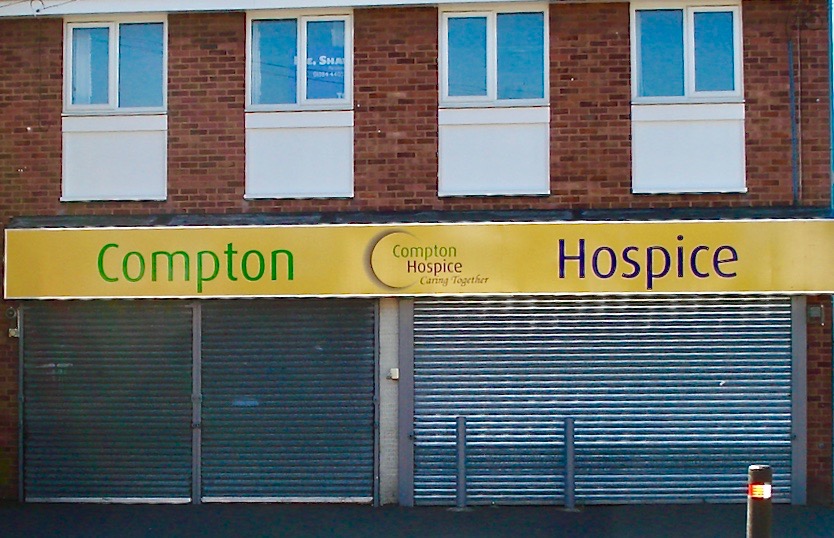
The Compton Hospice Shop
2010s
A smaller building on the corner of Cobden Street was closed and the premises which had been SPAR, were converted for the charity shop’s use. The building offers a much larger space and there is better parking for vehicles delivering goods to the rear of the building. The move took place in 2017 after SPAR moved to new premises further along Bridgnorth Road, now next to the post office.
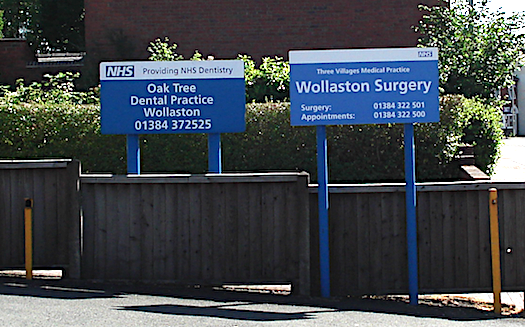
NHS signs in Bridgnorth Road
2000s
As the two medical surgeries are located in adjoining properties, the paired signs provide an easy reference to both buildings.
Oak Tree Dental Practice
What had been family home was converted into a dental surgery in the early years of the 21st century. There is ample parking and a number of consulting rooms which has meant that there are patients coming from areas other than only Wollaston, The doctor’s surgery is next door and the signs for both practices are easy to see.
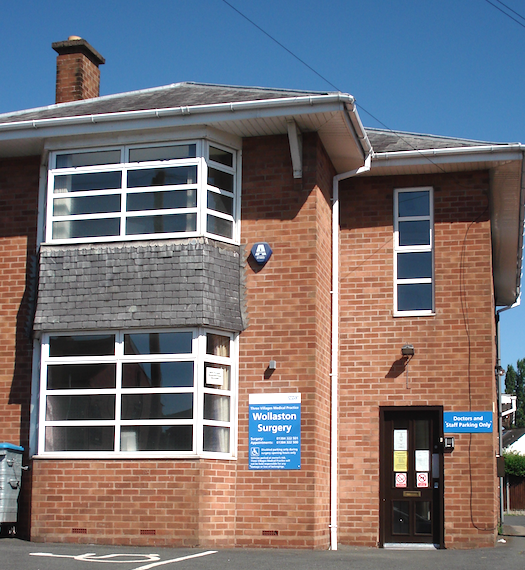
Surgeries in Bridgnorth Road
2000s
The first surgery in Wollaston was opened in one of the buildings on the opposite side of the road by Dr Anderson. The house, which he built for the surgery also became the Doctor’s home.. After his retirement Dr Williams and Dr Chinnock ran the practice and Dr and Mrs Chinnock lived in the house. Another surgery was opened in Amblecote and continued to be used for many years. As the population of the are increased a surgery was built in John Corbett Drive. The house in Bridgnorth Road was developed and the practice took over the whole of the building with more accommodation for reception, a waiting room and consulting rooms.
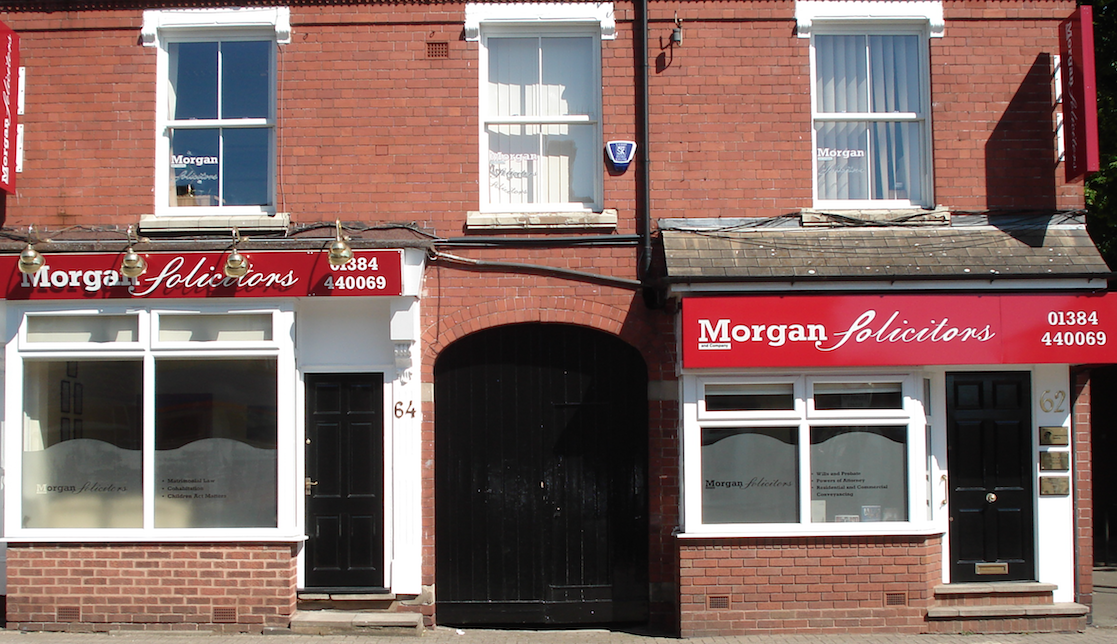
Morgan Solicitors
2000s
Morgan Solicitors was established by Susan Morgan and her son William. Since Susan retired William has a new partner, Daniel Williams and they offer personal service for Wills and Probates, Advice for elderly clients, Inheritance planning and advice and Powers of Attorney, divorce and separation, Civil Partnerships and conveyancing for the sale and purchase of property.
Doulton Brook
2010s
In 2013 the demolition of the old BSR works, later Sunrise Medical began. The land where the new houses are being build occupies both sides of the River Stour so is partly in Amblecote and partly in Wollaston. In 2014 the first houses were ready for occupation although there are still more being erected in late 2015. The name of the development is based on the fact that the glassworks was part of the Doulton group. A new bridge has been built over the river to connect the two areas.
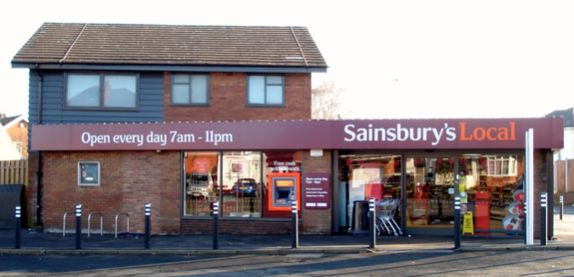
Sainsbury’s Local
2010s
In 2014 another new small supermarket was opened on the corner of High Street and Vicarage Road. It has a large car park behind the houses in Vicarage Road with access from Vicarage Road. It now occupies the site which was once The Barley Mow.
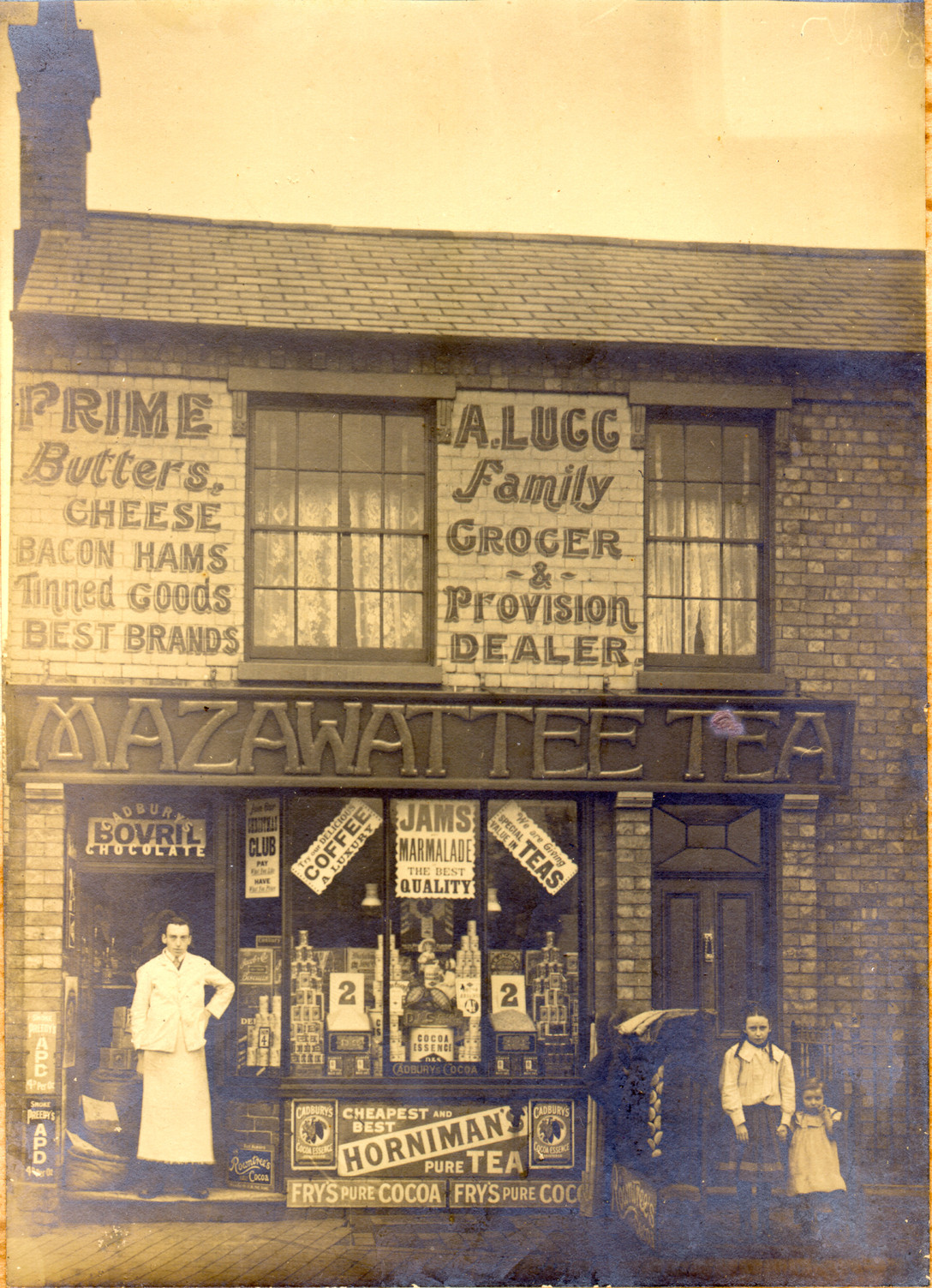
A. Lugg - Grocer
1910s
Ambrose Lugg, his wife and oldest son lived in West Bromwich in 1891. By 1901 they had moved to Wollaston and there were then three sons and a 4 month old daughter recorded in the Census. In 1911 the family consisted of Ambrose and Annie and their children Fred, aged 20, Hubert, aged 18, Samuel, aged 16, Annie, aged 9 and Hilda, aged 3. Later in 1911 the family emigrated to Australia where they lived in Brisbane and named their house Wollaston.
Information came from Cameron Davidson, Ambrose’s great grandson who thinks that the photograph may have been taken in 1910/1911.
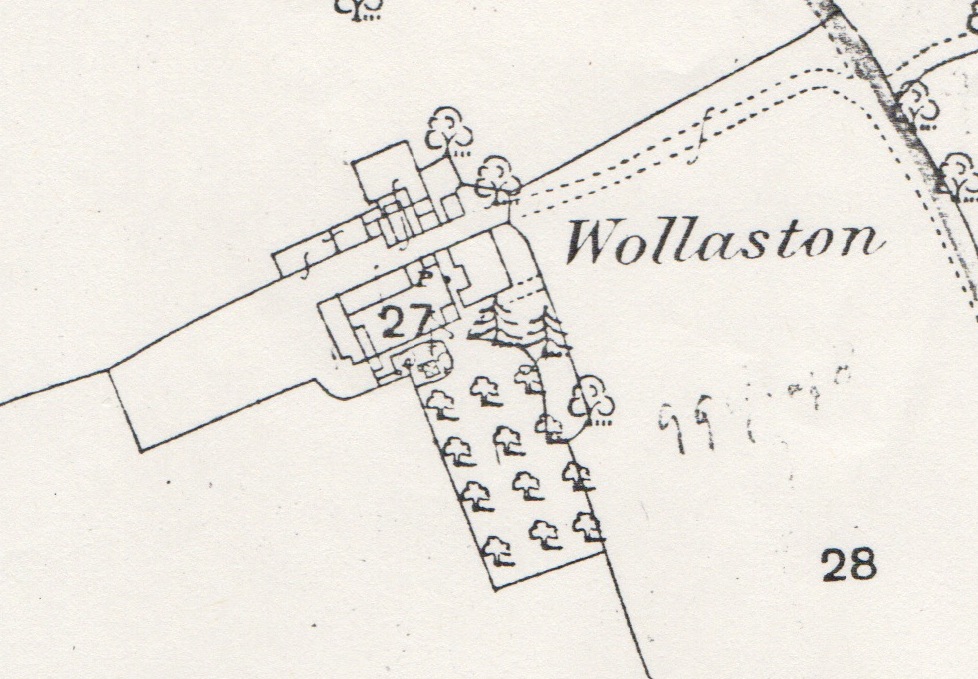
A plan of the farmhouse of Wollaston Farm
1880s
The 1888 O.S. map clearly shows the shape of the farmhouse with the orchard shown as rows of trees. St James’s School still uses the word orchard to describe the grassy area in front of the school. Other trees surround the house and one of these survived until the 1990s when it was cut down to make way for an extension to the school. It is not easy to distinguish the different buildings but the barn is still there although it was developed into the school library in the 1980s.
.jpg)
Wollaston Farm
1880s
Wollaston Farm was the largest farm in Wollaston being about 150 acres, and was still being farmed until the early 1950s. In 1888 the tenant farmer was Edward Parsons and the owner of the land was William Orme Foster who had inherited it from his uncle, James Foster. A small area had been taken out of the farmland to build the Vicarage when, in 1860, the church was built at W.O. Foster’s expense. The bridle road is shown crossing the fields from Vicarage Road and the road to the farmhouse is roughly where Somerset Drive is today.
When Wollaston Farm Estate was built the area around the farm house was used for Meadow Park Infants’ School and the farmhouse remained for a while as the house for the school’s caretaker. One of the farm buildings remained and until the infant and junior schools combined in 1984 the barn was used for storage by the infant school. The development of the new St James’s Primary School incorporated the outline of the barn into the new buildings when it was converted into the school library.
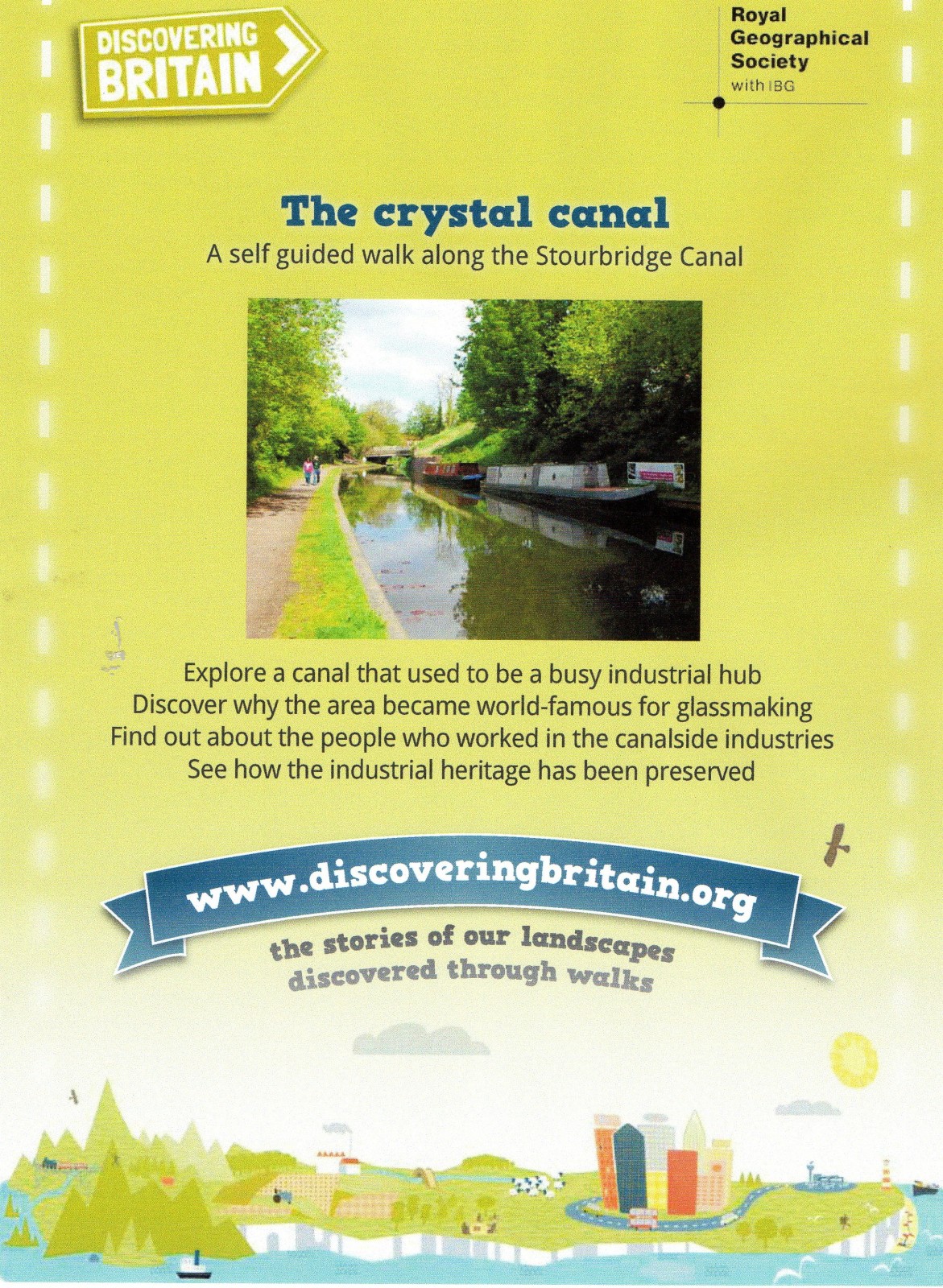
The crystal canal
2010s
A new walk has been added to the Royal Geographical Society’s website. It gives details of a walk between the Bonded Warehouse and the Red House Glass Cone in Wordsley. While the canal towpath is the other side of the River Stour and therefore not in Wollaston, it is relevant to Wollaston’s History as the growth of Wollaston came about in the 19th century through the expansion of the ironworks and glass works in the area.
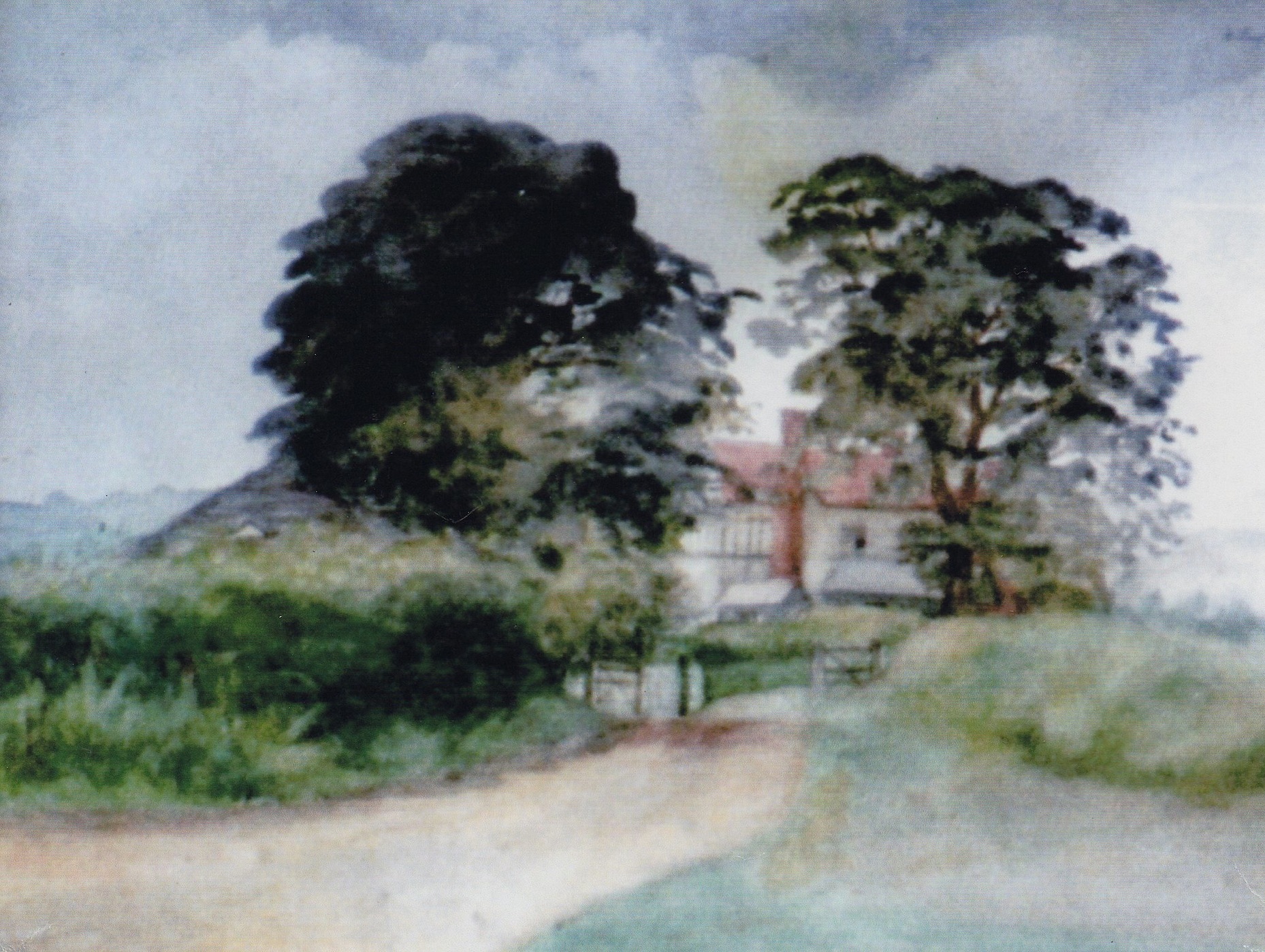
Wollaston Farm
1890s
The painting of Wollaston Farm shows tall trees each side of the house, one of which was still standing when Meadow Park Infants’ School was opened in 1959. The land lay to the north of Vicarage Road and the windmill was one of the early buildings on that side of the road. It was just below where the Vicarage was built in 1863. There is a record of a pupil admitted to the Boys’ School in 1859 whose father’s occupation was miller.
The land belonged to the Foster family and one of the tenants was Edward Parsons who farmed there from about 1882 until the 1920s. In the 1851 census the farm was referred to as Mr Bill’s Farm and the farmer was his widow. The intention in 1935 was for Stourbridge Borough to purchase the land for house building but the war prevented that and the development did not take place until the 1950s. The farm house survived until Meadow Park Infants’ School opened when it was used as a caretaker’s house. The barn was rebuilt as the library for St James’s Primary School when it merged in 1984.
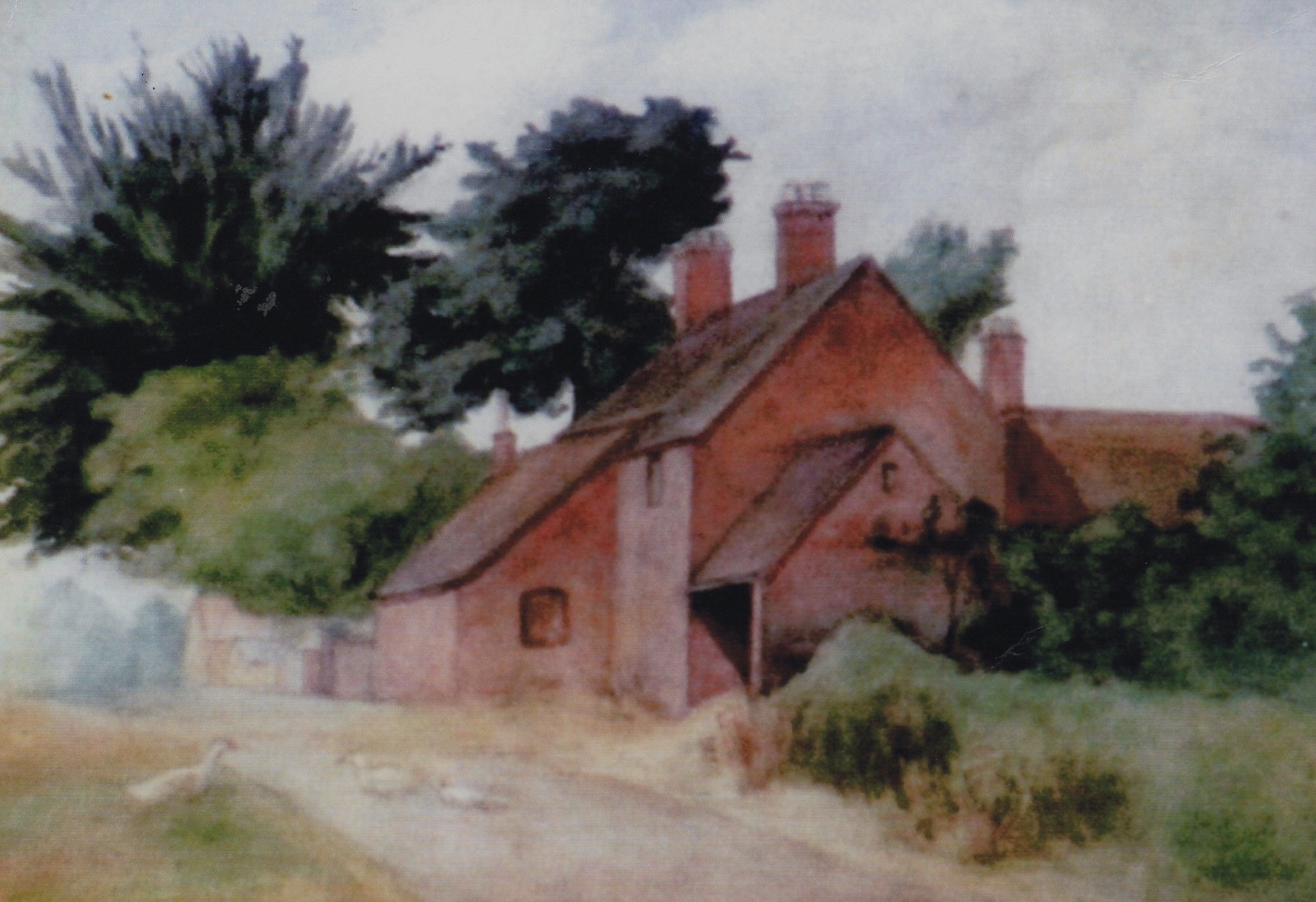
High Park Farm
1890s
High Park Farm covered over 41 acres of land which was bounded by what is now High Park Avenue, South Road and Park Road. It was once part of the land which belonged to the Foley family until 1809 when it was sold to the Earl of Dudley. The tenant of the most of Wollaston’s farms was Charles Grazebrook but the land was farmed by others. In the 1841 census the occupant of the farmhouse was William Rylands and his family but he gave his occupation as a bank clerk. In the two adjoining houses were two agricultural labourers who presumably worked the land.
There were other farmers named in later directories and censuses but the last known farmers were from the Whitmore family and there are a number of mentions in the Boys’ School log books of Mrs Whitmore’s farm when, on one occasion, boys were punished for stealing turnips from her farm.
Their surname is remembered in Whitmore Road which is one of the roads on the High park Estate which was built in the late 1920s.
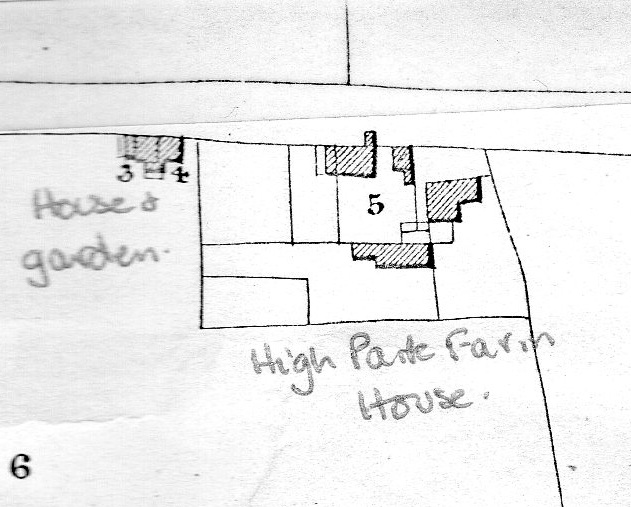
High Park Farmhouse
1840s
High Park Farm occupied about 41 acres of land to the east of what is now High Park Avenue. In 1848 the sale of Wollaston Hall, Wollaston Rolling Mill and two farms, Eggington and High Park, was held on 25th January at the Talbot Hotel in Stourbridge. Wollaston had been part of the Foley lands until 1809 when it was sold to the Earl of Dudley. The tenant named in the sale document was Charles Grazebrook but he did not work them himself and in the 1851 census the occupiers of the farmhouse were Sarah Grosvenor, a housekeeper, and Thomas Bewley, a farm labourer. The next two entries are for farm labourers and they were probably numbers 3 and 4 on the map.
The numbers on the map refer to the farm house:- 3 - House & garden; 4 - house & garden; 5 High Park Farmhouse, yard, garden & buildings.
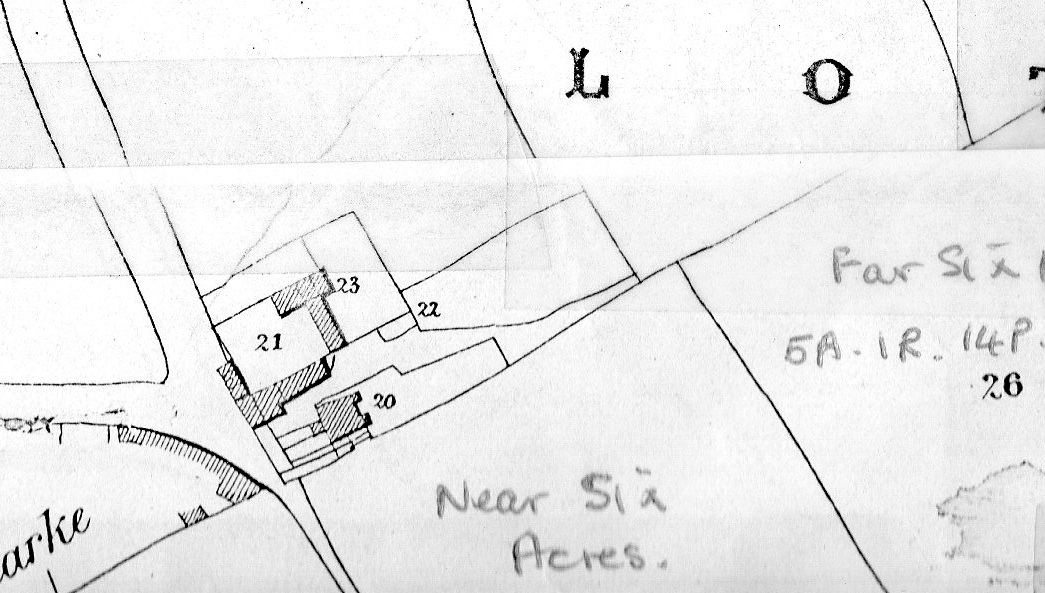
Eggington Farmhouse
1840s
An enlargement from the map of Wollaston Estate when it was sold at auction on 25th January 1848. Eggington Farm consisted of 62 acres of land and the numbers on this map name the areas around the farmhouse. 20 - Eggington Farm house & garden; 21 - Building land etc.; 22 - Garden etc.; 23 - Rick-yard. The road junction shown in front of the buildings is between High Park Avenue and Bridgnorth Road. The farmhouse is where Hamilton Avenue is and the last house before Bridgnorth Road now stands. The barn was used by the Home Guard during the war.
The whole of Wollaston was once part of the Foley lands and was sold to the Earl of Dudley in 1809 and again in 1848The sale included Wollaston hall, Wollaston Rolling Mill and High Park and Eggington Farms.
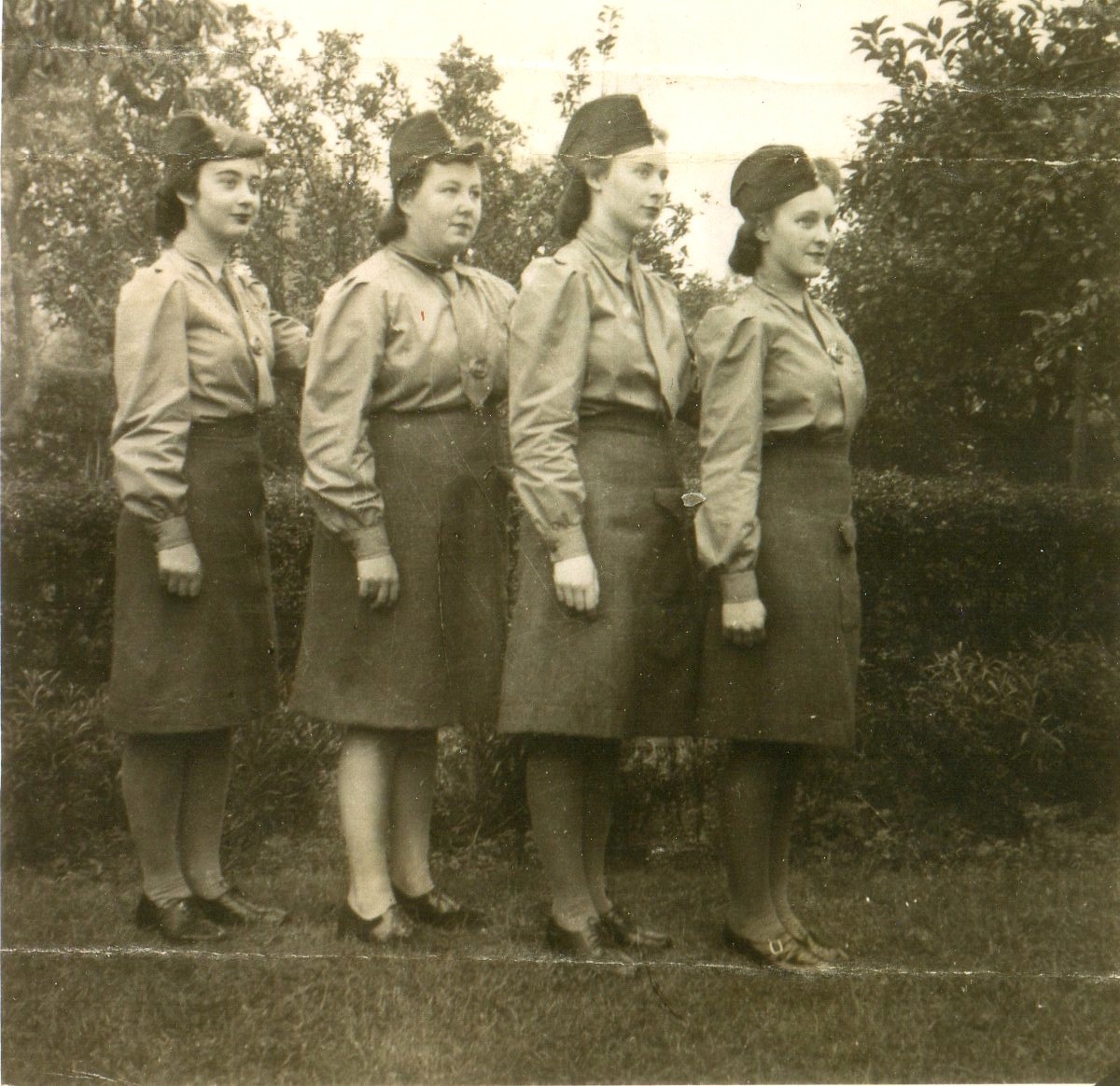
The Women’s Homeguard
1940s
The Women’s Home Guard and Auxiliary, also nicknamed “Mum’s Army”, were intended to work as clerks, typists, cooks and messengers. This was to free the men from these duties. They were formed in 1943 and just four women served in Wollaston. They are:- Betty Davies, Dot Davies, Margaret White and sheila Burroughs.
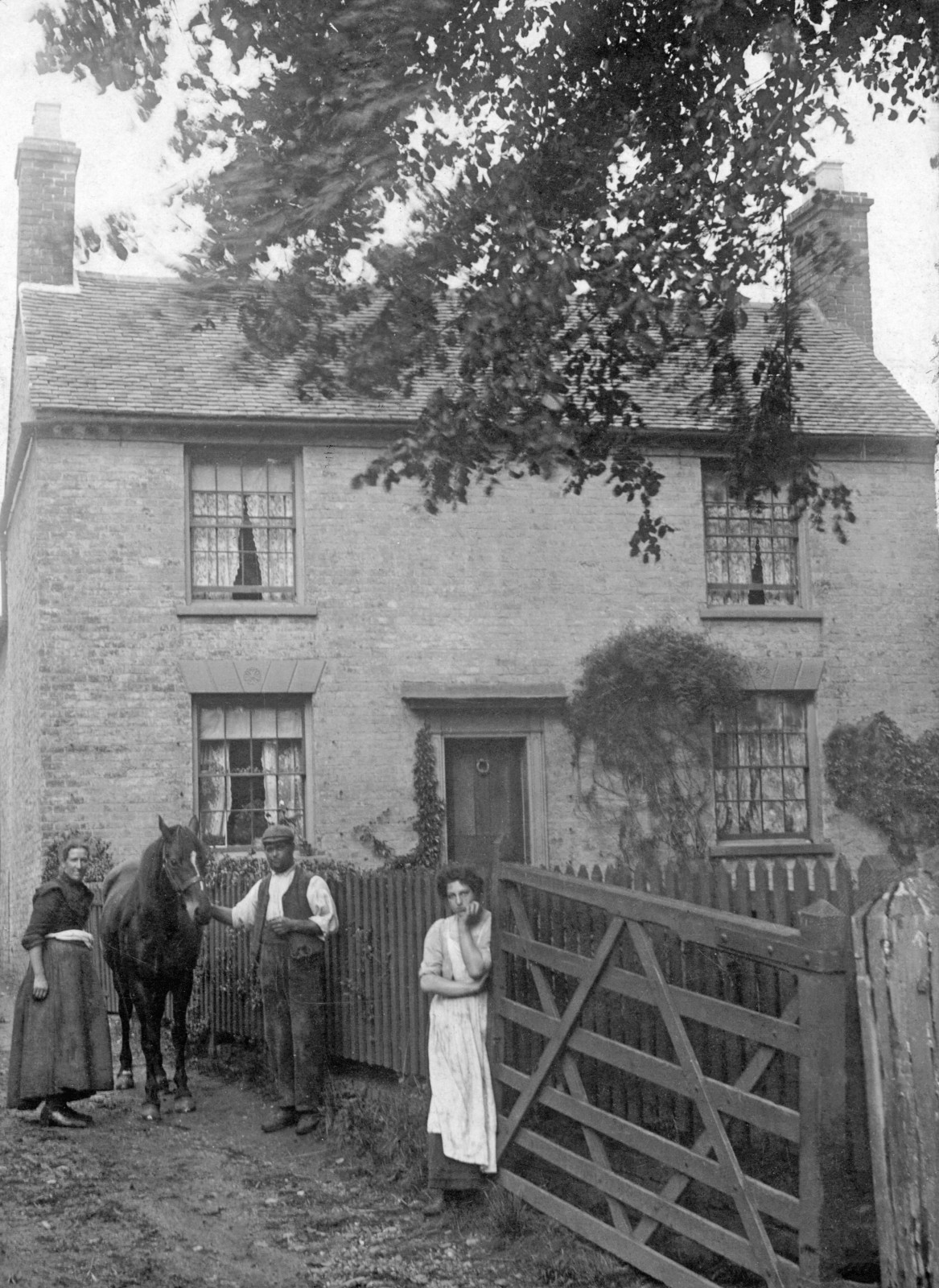
Eggington Farm Cottage
1900s
This cottage was part of the farm buildings of Eggington Farm. In about 1902 the house was occupied by Alfred Davies who worked on the farm. He is seen here with his wife Lucy and daughter Florence. They had moved from the Bewdley area in 1899 and Florence, her older sister Dora and her brother Arthur were admitted to Wollaston Schools on 28th August 1899. Their address was then Sewerage Farm which was just outside Wollaston. By 1903 they had moved into the farm cottage on Eggington Farm as this different address was in the Admissions Register of Wollaston Boys’ School when another brother, George, was admitted on 1st May 1903.
The family left Wollaston to live in Kingswinford in 1906.
The property stood until 1964 when the site was bought by a building company which developed Hamilton Avenue. Most of the farm land was sold and built on over many years starting in 1903. The cottage and farm buildings are shown on a map of 1903.
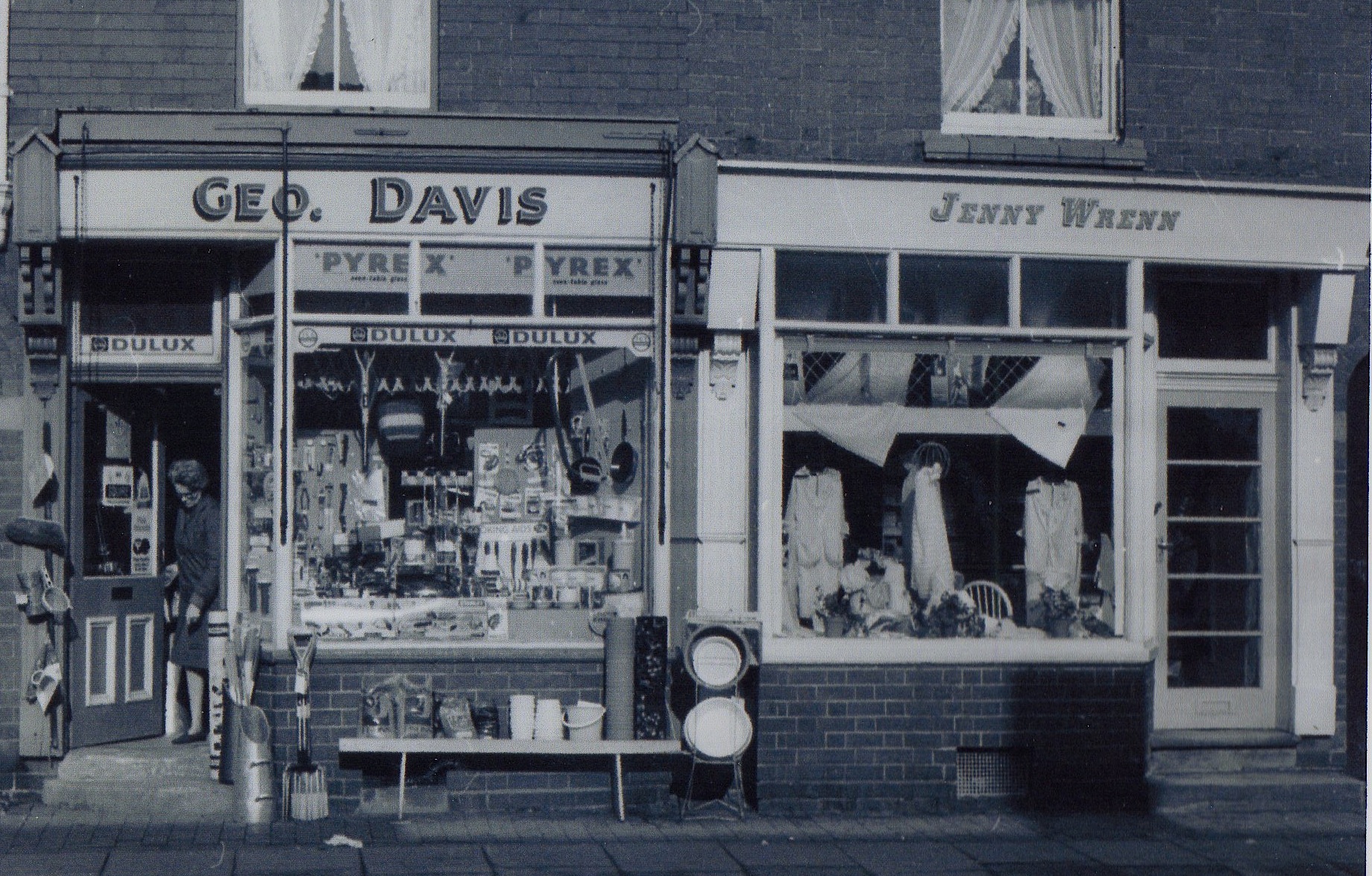
Bridgnorth Road shops in the 1960s.
1960s
The ironmongers was originally run by L. Griffiths. There are images of his ownership on the site but when this photograph was taken it had changed hands and was run by George Davis. Next door was a children’s wear shop called Jenny Wren. This property is now part of Morgan Solicitors.
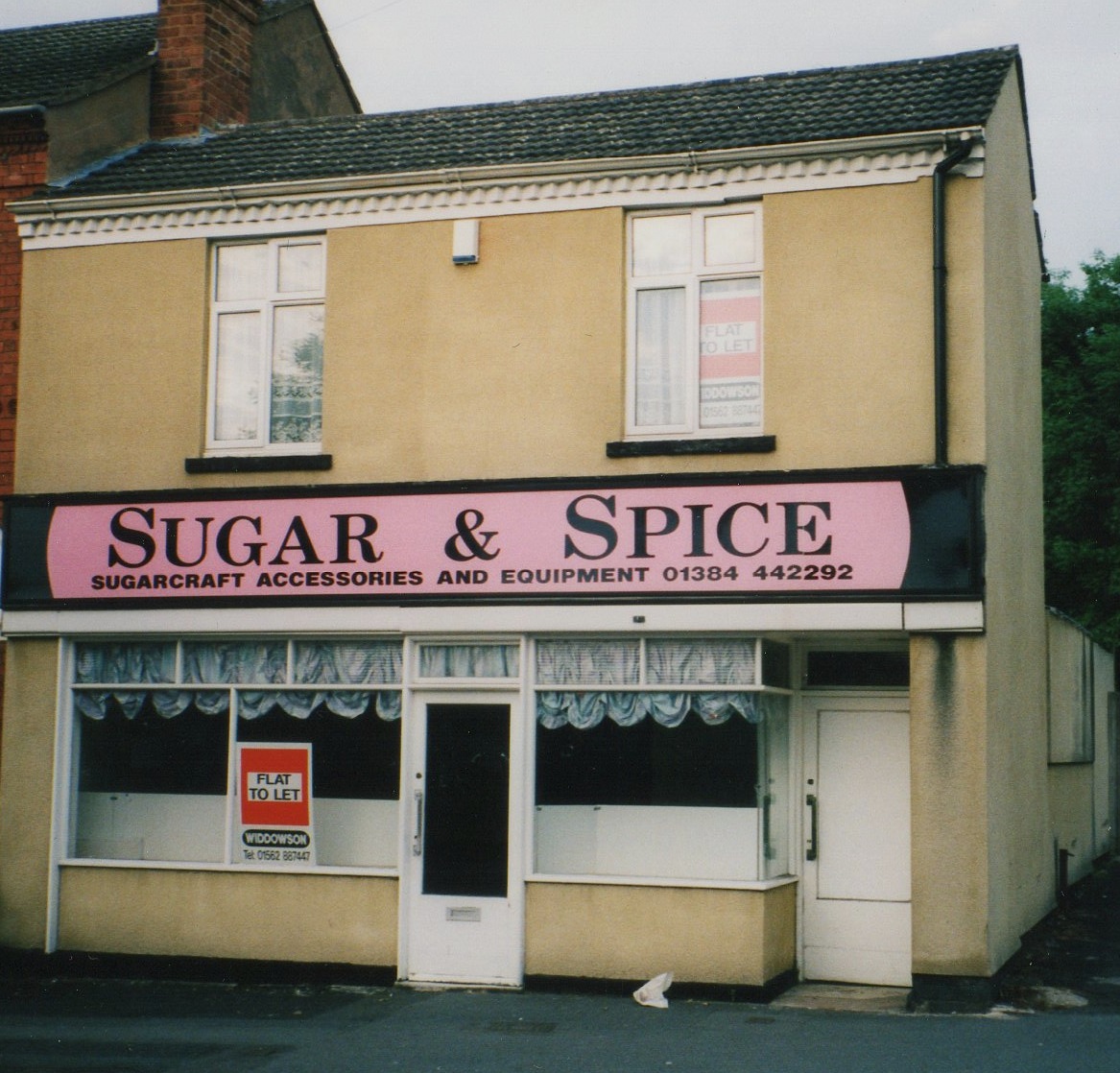
Sugar & Spice in High Street
2000s
This building at number 4 High Street has had a number of occupants. In the 1960s it housed the post office. It has also been a cafe in the early years of the 21st cntury and in 2013 it is now a tattoo Studio. When this photograph was taken in August 2000 it offered equipment and accessories for cake making.
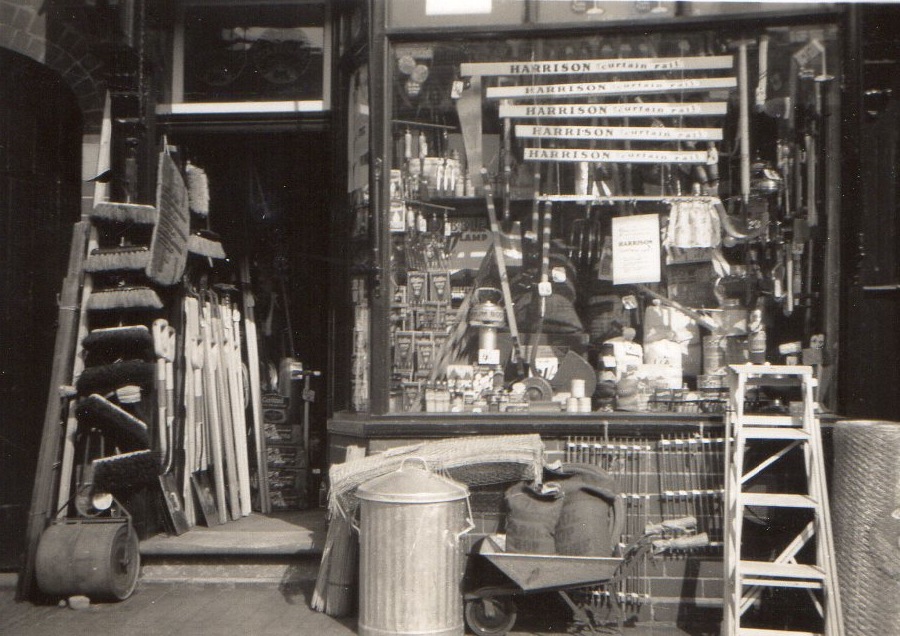
L. Griffiths - ironmonger
1970s
L. Griffiths ran the ironmonger’s shop in Bridgnorth Road. There was a wide variety of stock sold which included many items that are no longer available locally or needed in the 21st century. They include step ladders, dustbins, a coal scuttle, wheelbarrows, electrical items and many tools for use in the garden and around the home. The premises were later taken over by George Davis.
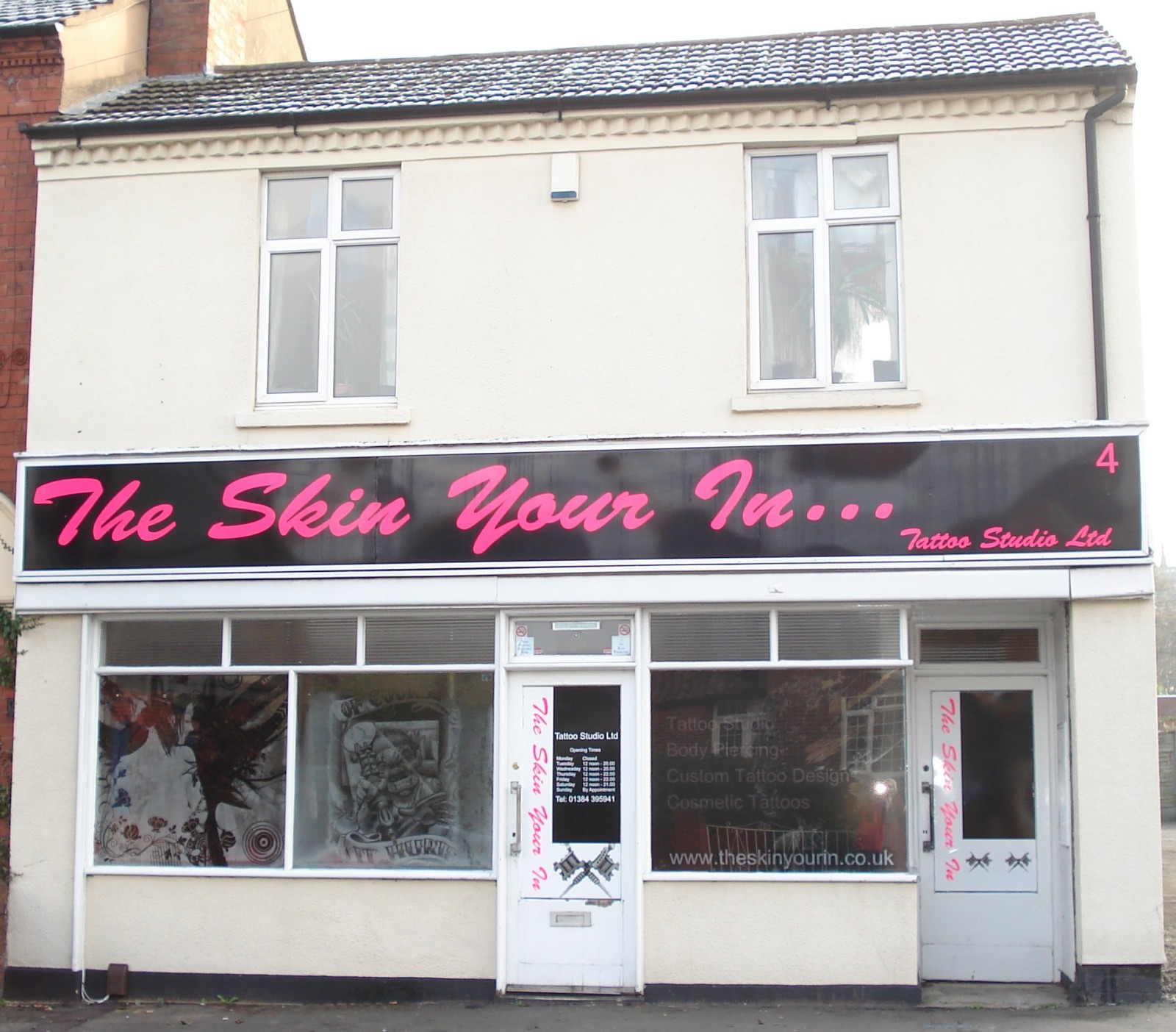
No. 4 High Street
2010s
The tattoo studio which opened in 2012 and was called maximus iv ink, changed its name in January 2013. The new title above the windows reads: ‘The Skin Your In’. Either the owners have a sense of humour or do not understand English spelling/punctuation. It has a company name showing that it is registered as Tattoo Studio Ltd.
Other entries on the site show many of the former uses of the building. In the 1960s it was the post office.
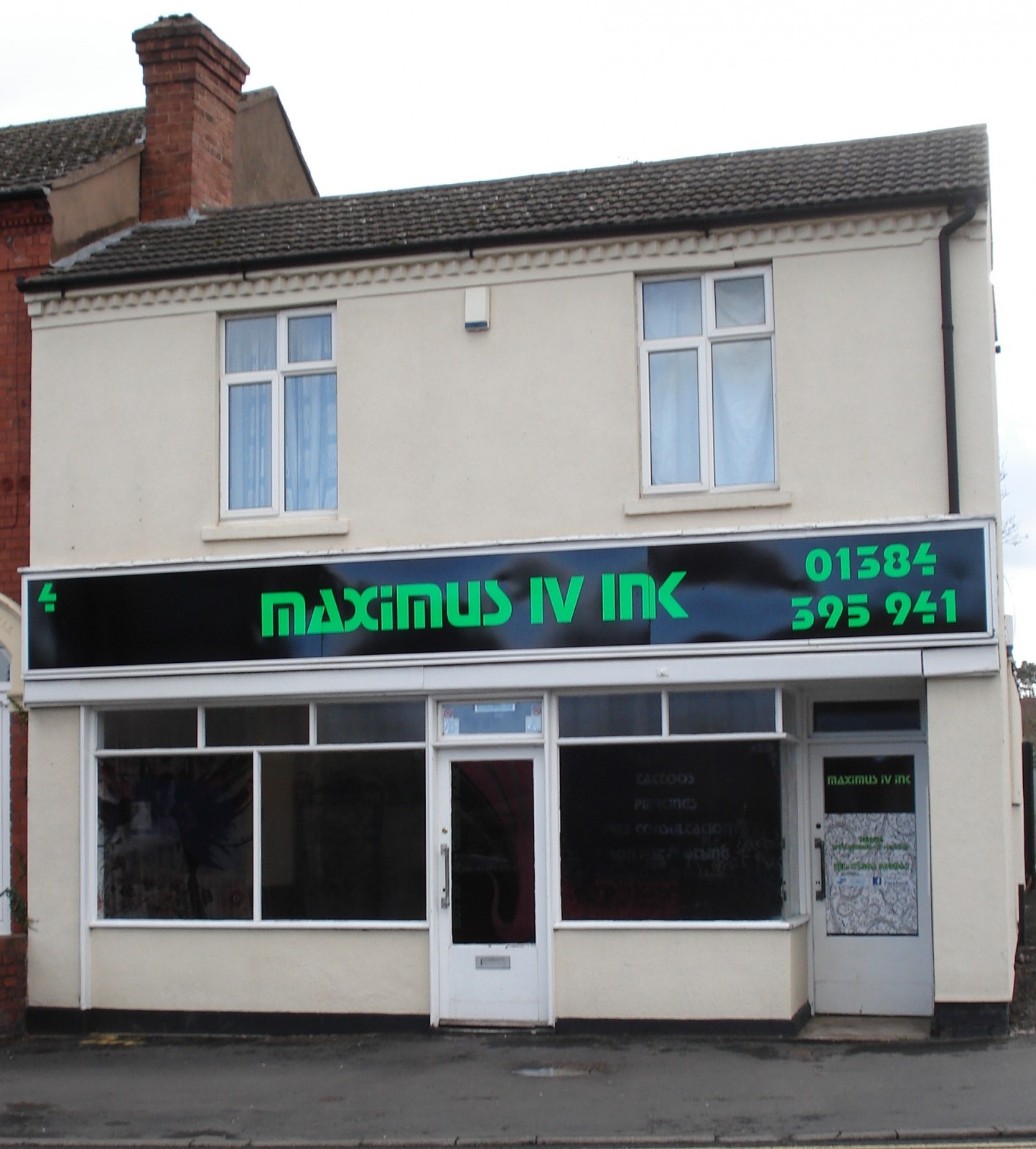
No. 4 High Street
2010s
Number 4 High Street was originally built as a house with a small front garden and a large back garden. It has been many premises during the years since it was the post office in the 1960s. In 2012 it became a tattoo parlour called maximus ink.
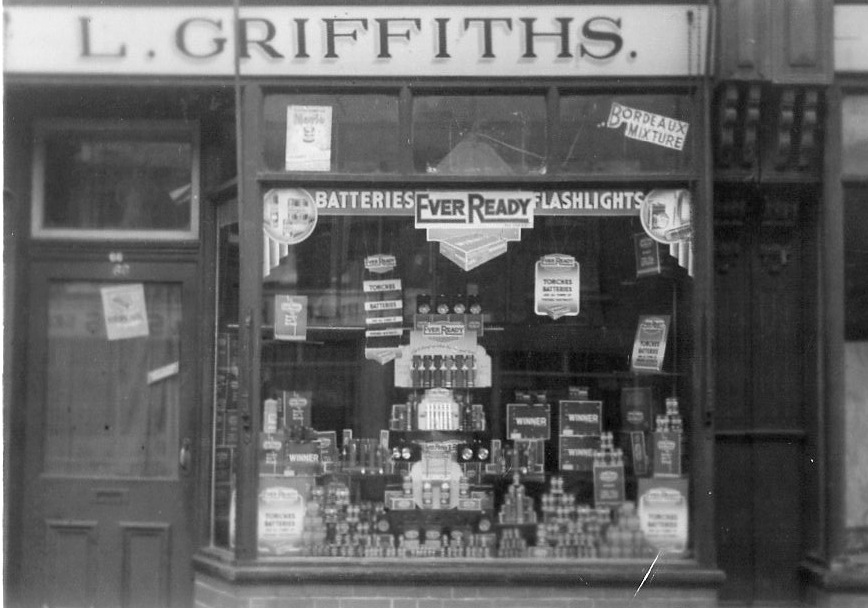
The Ironmongers, L. Griffiths.
1950s
The ironmongers which occupied a property in Bridgnorth Road was run by L. Griffiths for many years, as shown in this photograph. Later it was still in business run by George Davies. There was often a grand display of goods spilling over onto the footpath. The property is now a travel agents.
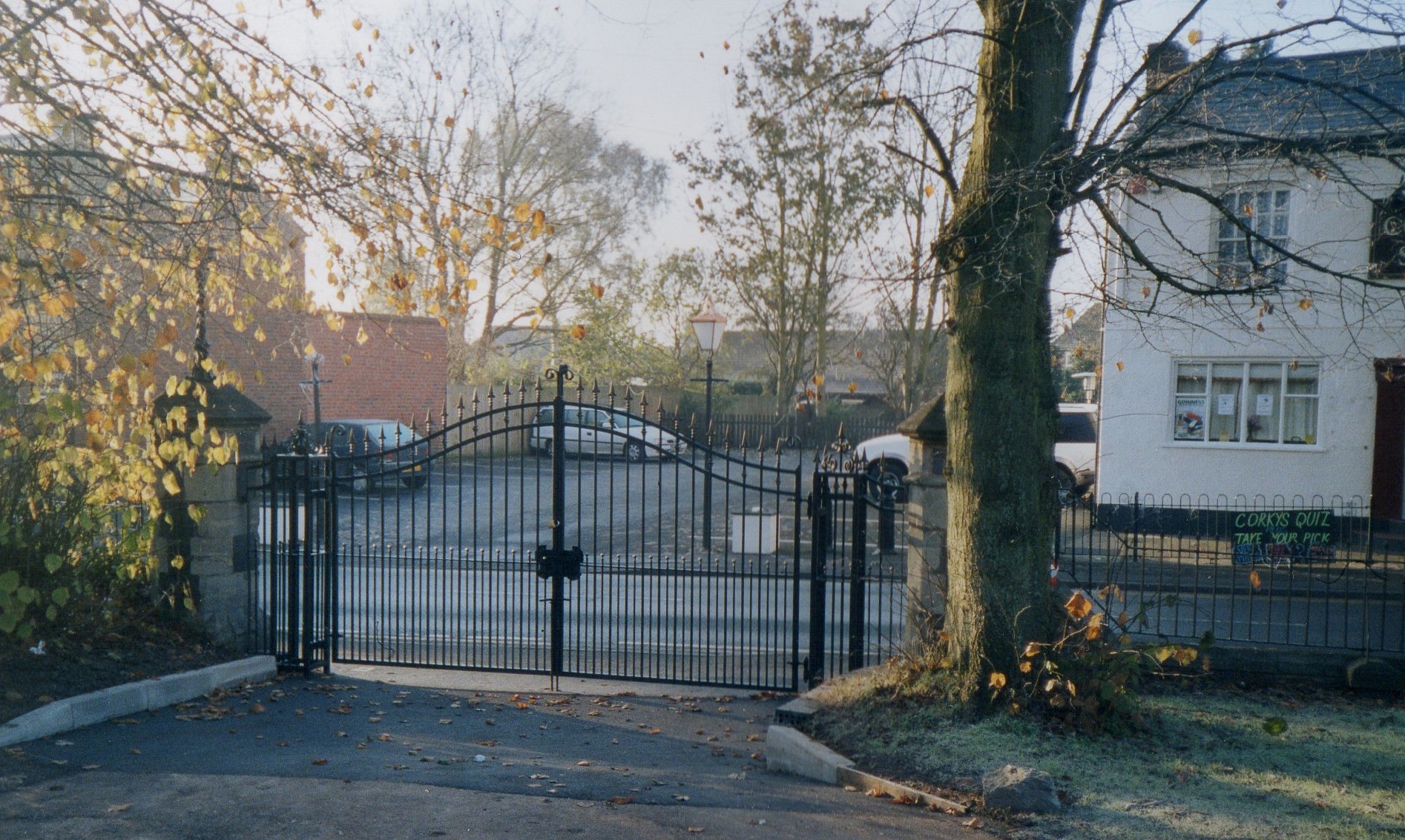
The new churchyard gates
2010s
New gates to the entrance to St James’s Churchyard were installed in 2005. These lead onto Bridgnorth Road, opposite the Cottage Spring public house (now Graham’s Place).
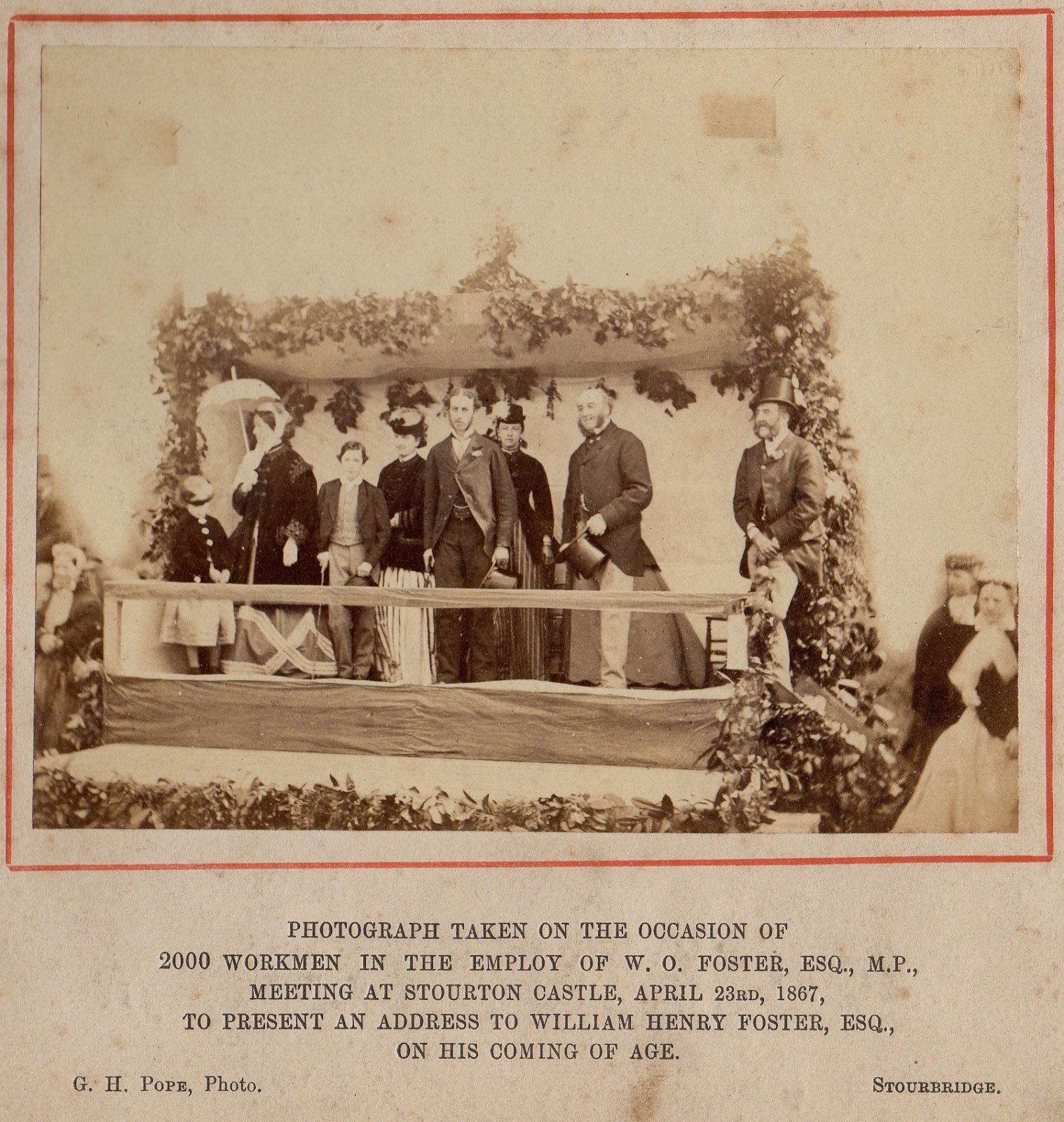
William Henry Foster
1860s
William Henry Foster was the elder son of William Orme Foster who was the local ironmaster and benefactor in Wollaston. He was educated at Oxford and was nominally head of the family iron making business after his father’s death in 1899. From 1870 onwards he had taken some part in running the various works. Prior to the death of W.O.Foster he had lived in Northampton and served as a Member of Parliament. He inherited Apley Park and moved there in 1899.
This photograph was taken at Stourton Castle when an address was presented to him by 2000 workmen employed by W. O. Foster.
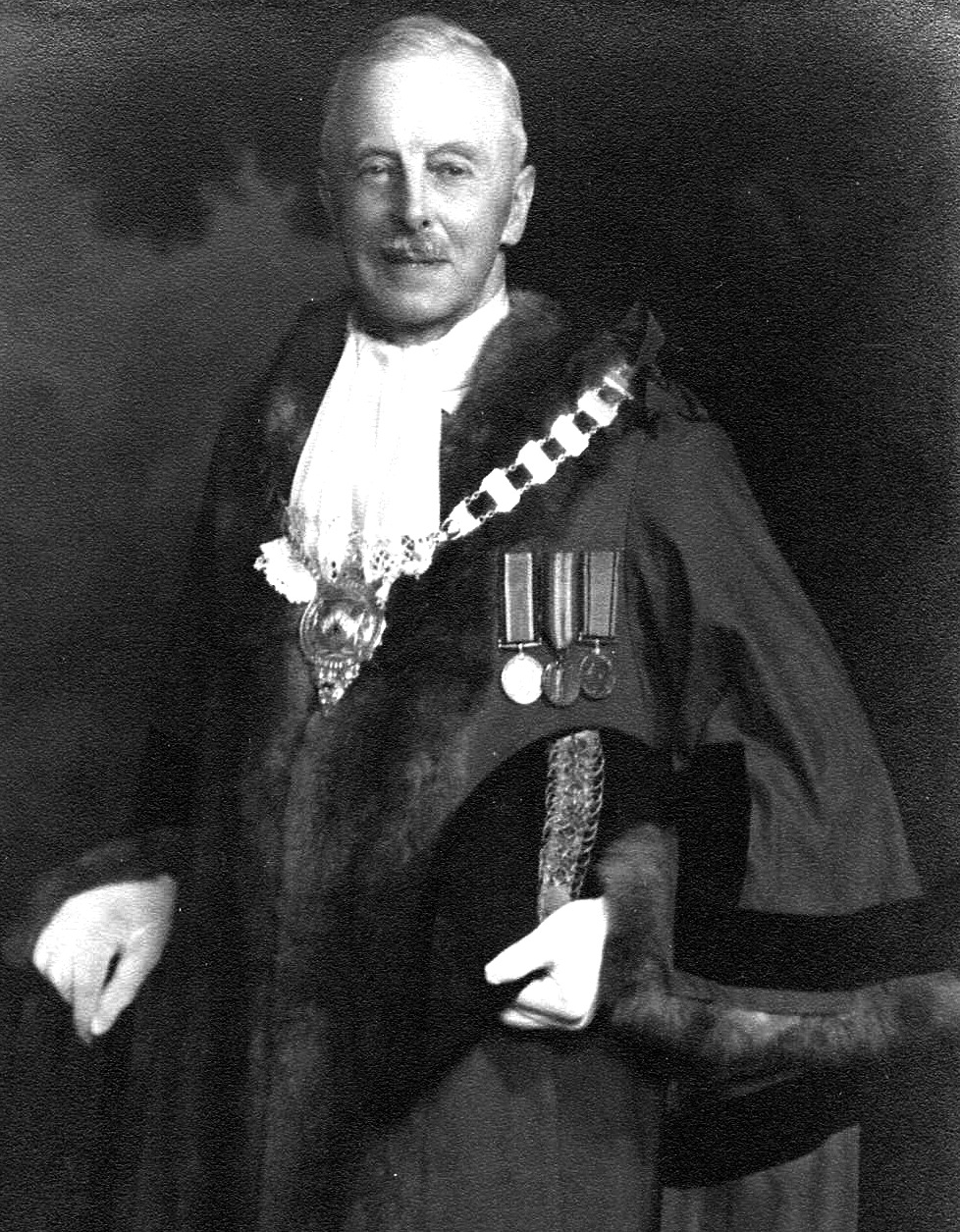
Councillor E.R.R. Tooby
1950s
Reed Tooby was well known in Wollaston having been a pupil at Wollaston Schools before joining his father in the building trade. He served in the Great War in the Royal Engineers in France. After his return to the area he built up his own business as a builder and built many houses in the village. In November 1924 he bought 16 acres of land which consisted of most of Eggington Farm, and over the next 30 years he developed Meriden Avenue and Meriden Close. He was elected as an independent councillor on Stourbridge Council in 1928 and served for the next 26 years until retiring in 1954. He served as Mayor of Stourbridge in 1952 and is seen in this photograph in his mayoral robes. He served on many committees during his time on the Council and was a Manager of Wollaston Schools.
He was a long serving member and principal lay officer of the Congregational Church in Lower High Street, Stourbridge and was for a time Chairman of the Worcestershire Congregational Union. He died in July 1973 at his home in Unwin Crescent.
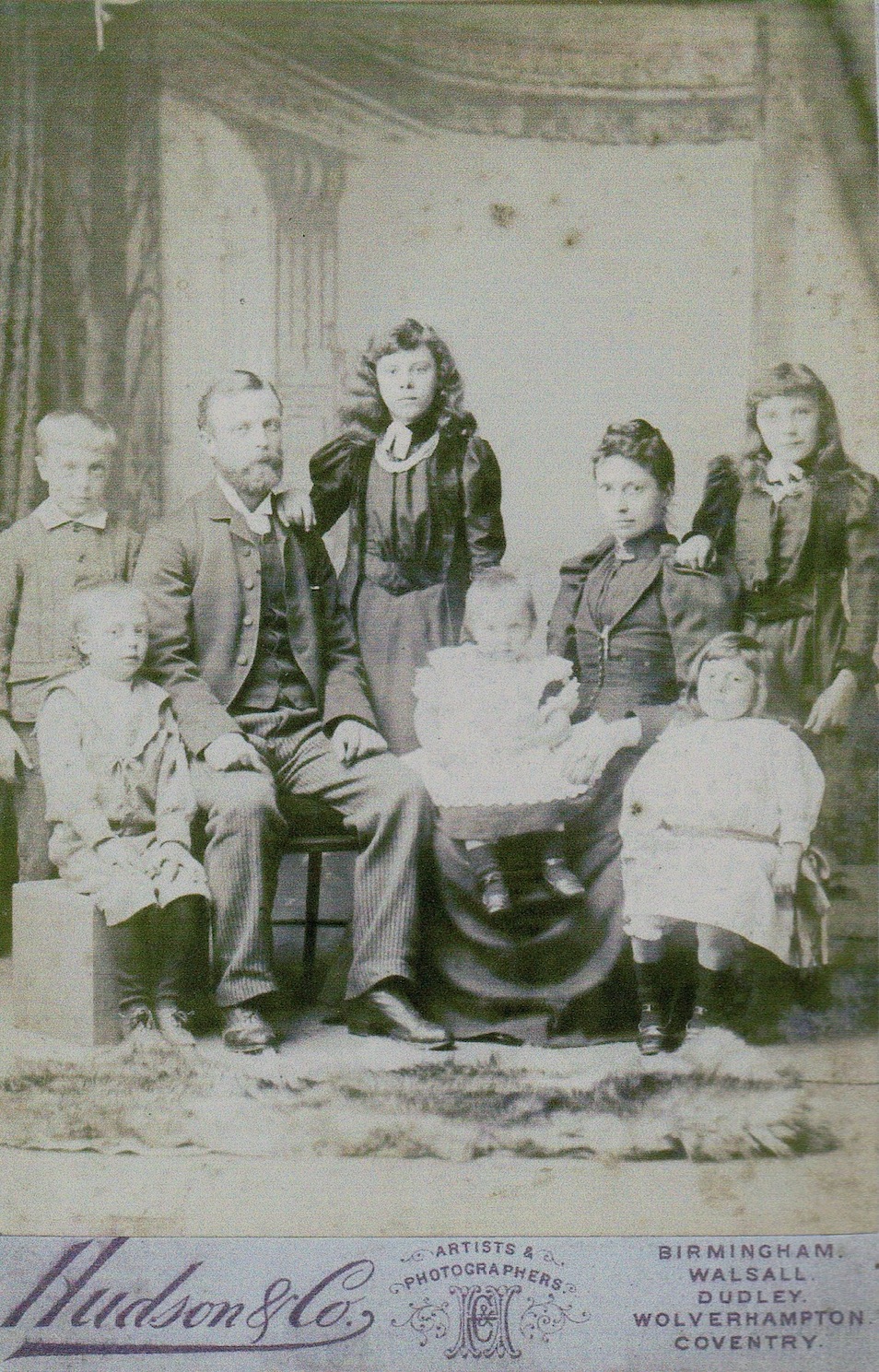
Reed Tooby & family
1890s
This photograph of Reed Tooby and his children was taken in the early 1890s. The parents, seated, are Edward Reginald Reed Tooby, born 1857, died 1921 and his wife Emma, born 1858, died 1937. Their children are, standing from left to right:- Edward Reginald Reed, 1883 to 1973, Winifred Emma, born 1880 and Ethel Annie, born 1881; seated Charles Frederick, born 1886, baby Mabel Jane, born 1891 and Rachel Irene, born 1888. A third son, Norman George was born in 1894.
Reed, the elder was a pupil at Wollaston Schools and all his children also attended the schools. Mabel was a pupil teacher in the Girls’ School between 1907 and 1909.
Reed Tooby and his son, also known as Reed, were both in the building trade. The younger Reed served in the Great War and on his return bought most of Eggington Farm which over many years he developed for housing. He served as a Stourbridge Councillor and was Mayor of Stourbridge in 1952. The family lived in Enville Street and later Cathcart Road.
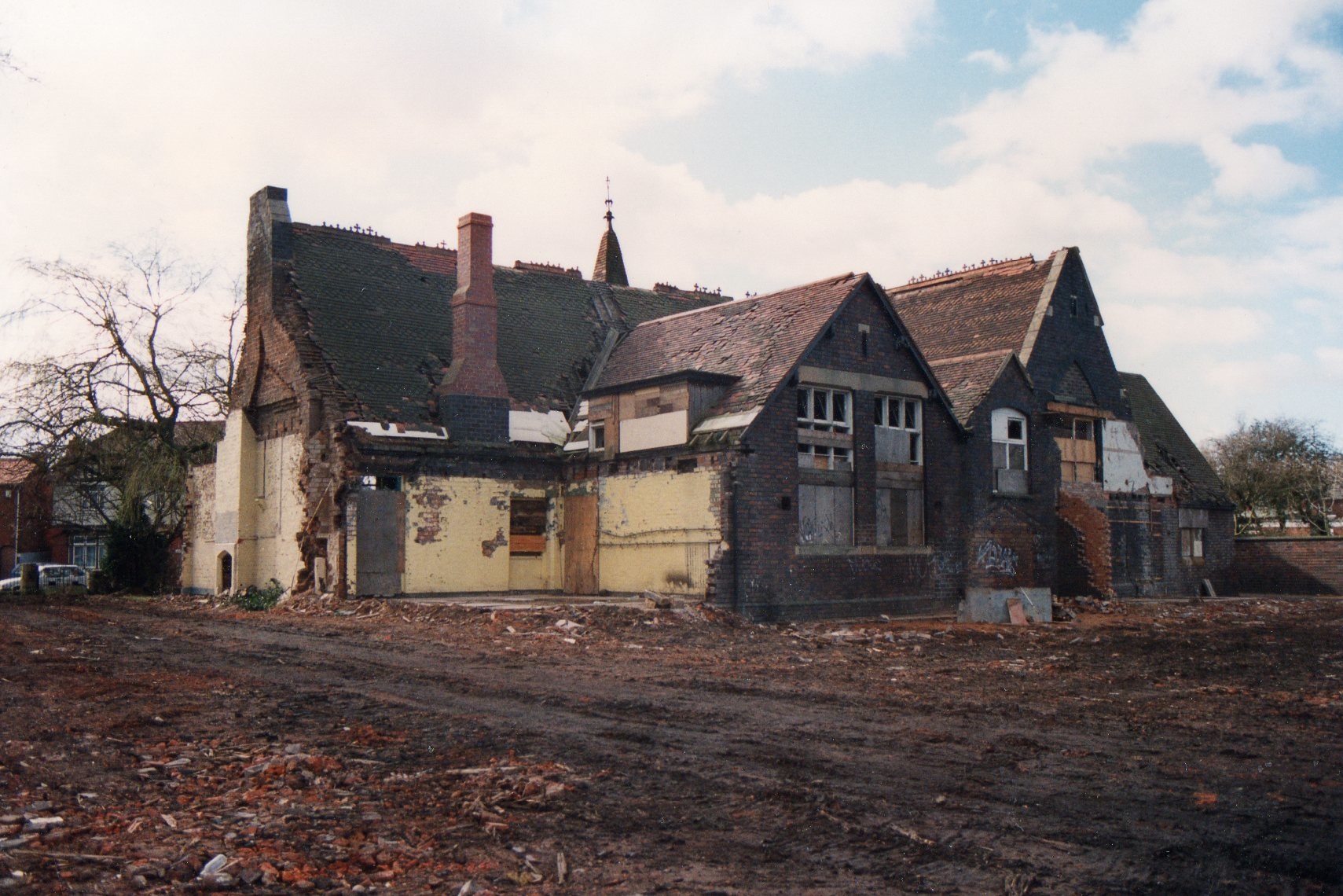
Demolition of the old schools
1980s
The part of the school building which had originally been the Infants’ School was demolished to make way for Belfry Drive. This gave access to the housing development which took place on the school playing field. The chimney and window were reinstated in the altered building which now houses commercial operations.
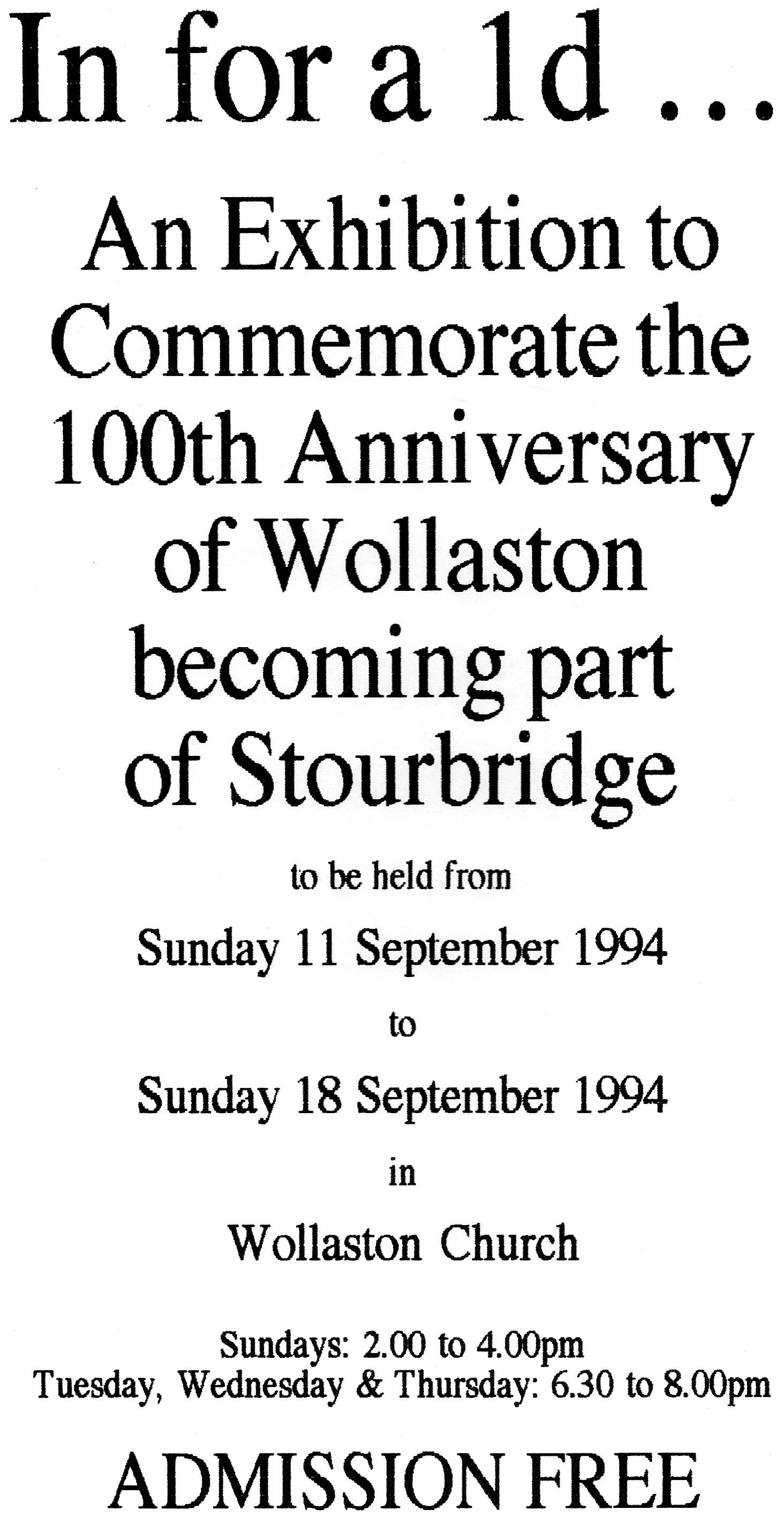
Anniversary - 1994
1990s
In September 1994 an exhibition was held to commemorate the 100th Anniversary of Wollaston becoming part of Stourbridge. The exhibition ran for a week from Sunday 11th to Sunday 18th September.
The title of the event - In for a Penny - reflected the move by Wollaston Vestry Committee to make the decision to join with Stourbridge after being granted a concession that the rates paid by the people of Wollaston should be 1d (1 penny) cheaper than if it chose to remain independent. Better road maintenance, cheaper gas lighting and a reduction of the Poor Rate were also negotiated and on 11th September 1894 the Chairman of Worcester County Council recommended that the District of the Stourbridge Urban Sanitary Authority be extended so as to include the Township of Wollaston.
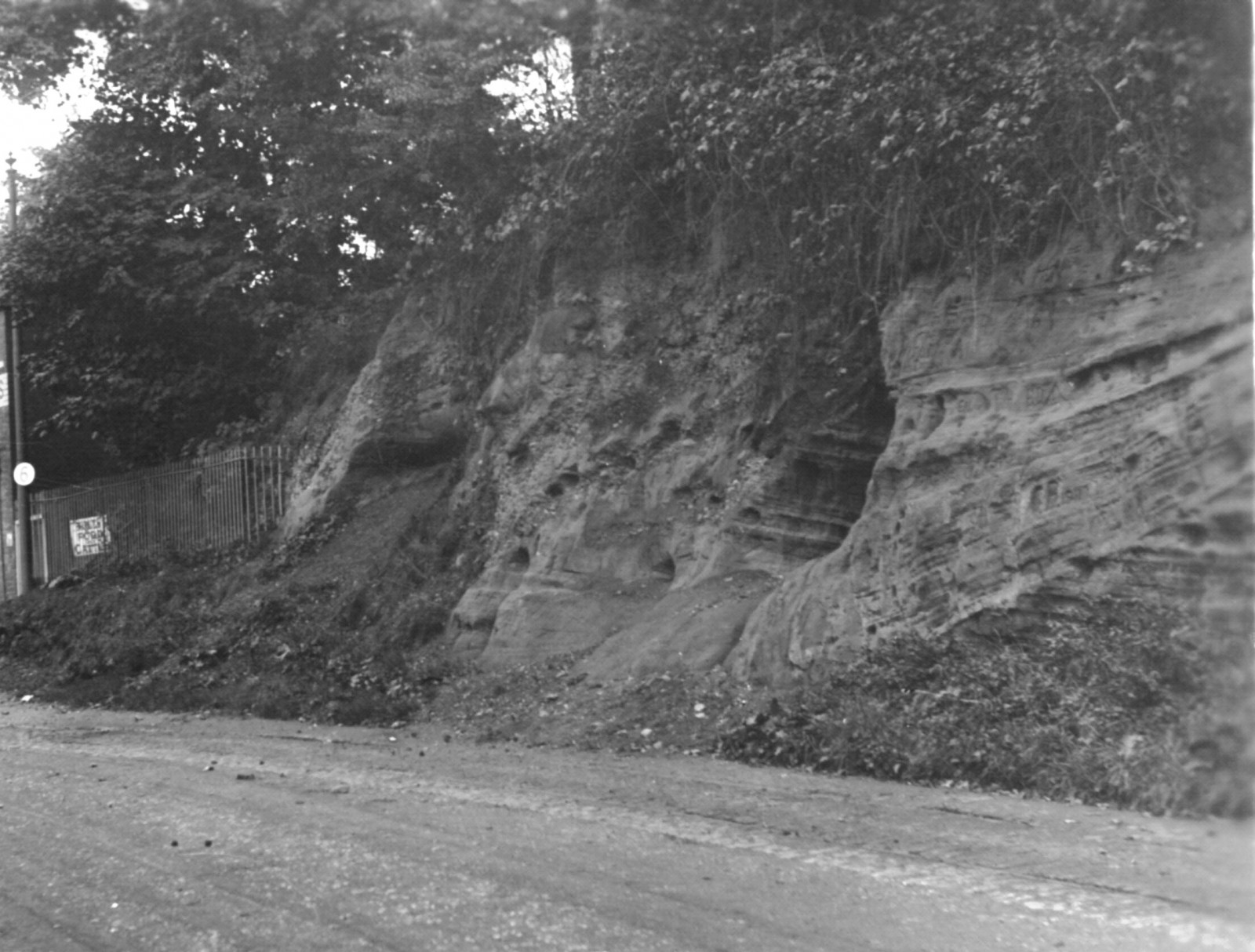
Tramlines at The Ridge
1910s
There is good detail on some commercial postcards. Here the Kinver Light Railway’s lines can be seen crossing to the side of the road past The Ridge.
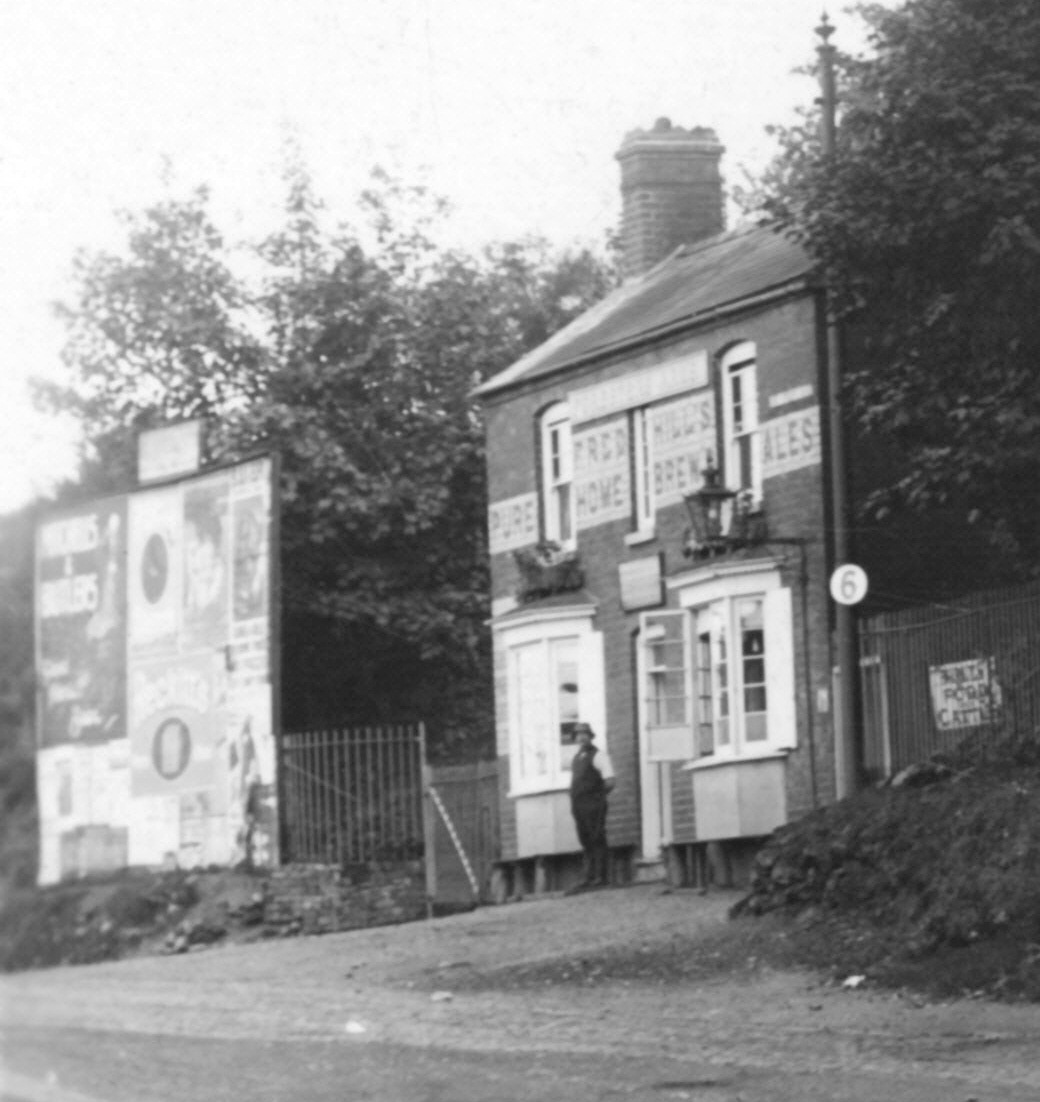
The Foresters Arms
1910s
A close-up of The Foresters Arms from a commercial post card. Note the bench seats around the bay windows. These were for passengers waiting for the Kinver Light Railway cars.
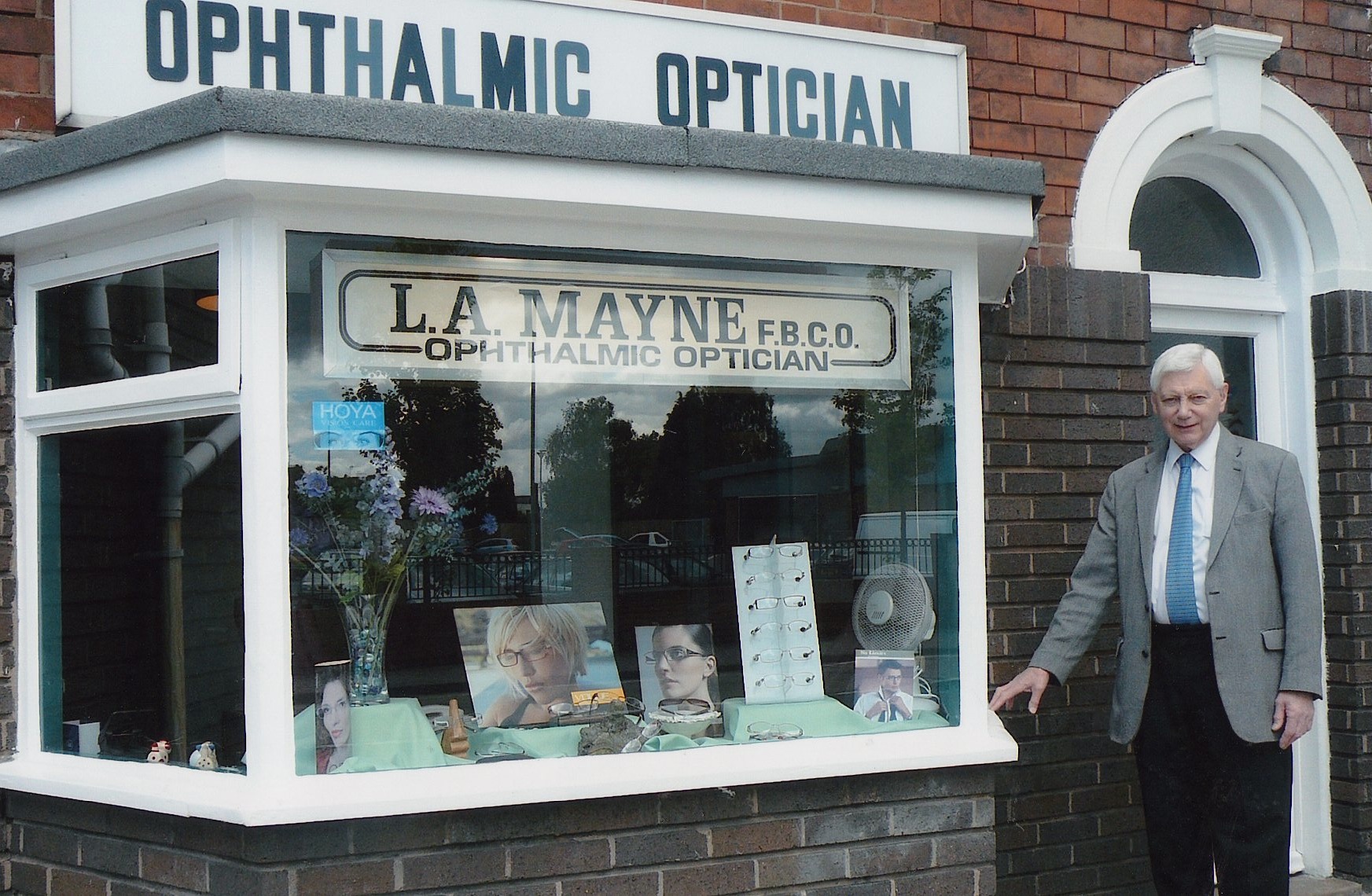
L. A. Mayne, F.B.C.O, Ophthalmic Optician
2010s
Laurie Mayne took over the existing opticians in August 1987. For many years he combined his work at Birmingham Eye Hospital with his work in Wollaston. He remained in the village for 24 years and retired in June 2011. Although he did not live in Stourbridge, he was well known to many Wollaston people who remained his patients for the many years he was here. His wife often acted as his receptionist.
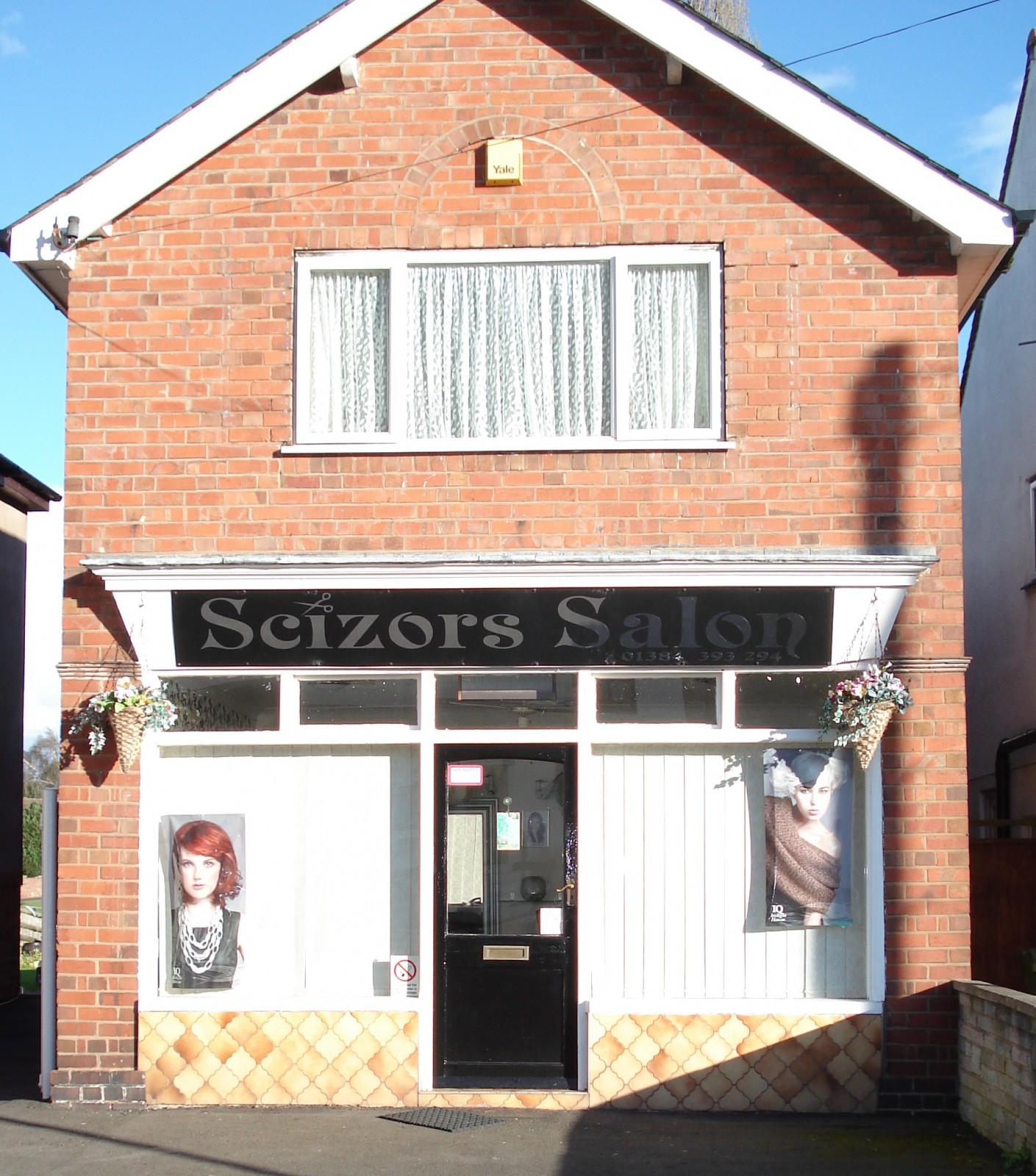
Scizors Salon in High Street
2010s
This was originally a house but at one time was a butcher’s shop run by Clive Dulson. He later traded from 125 Bridgnorth Road. In 2012 it is a hairdressers called Scizors Salon and has been at 90 High Street since at least 2000.
.jpg)
The entrance to Wollaston Schools.
1950s
There were two gates used by the children who went to Wollaston Schools. This photograph shows two, one was opposite the main entrance to the building and the second near to the church. The central one was closed and the wall built leaving just one way in along the side of the building and straight onto the playground behind the school where the children would wait before being called in.
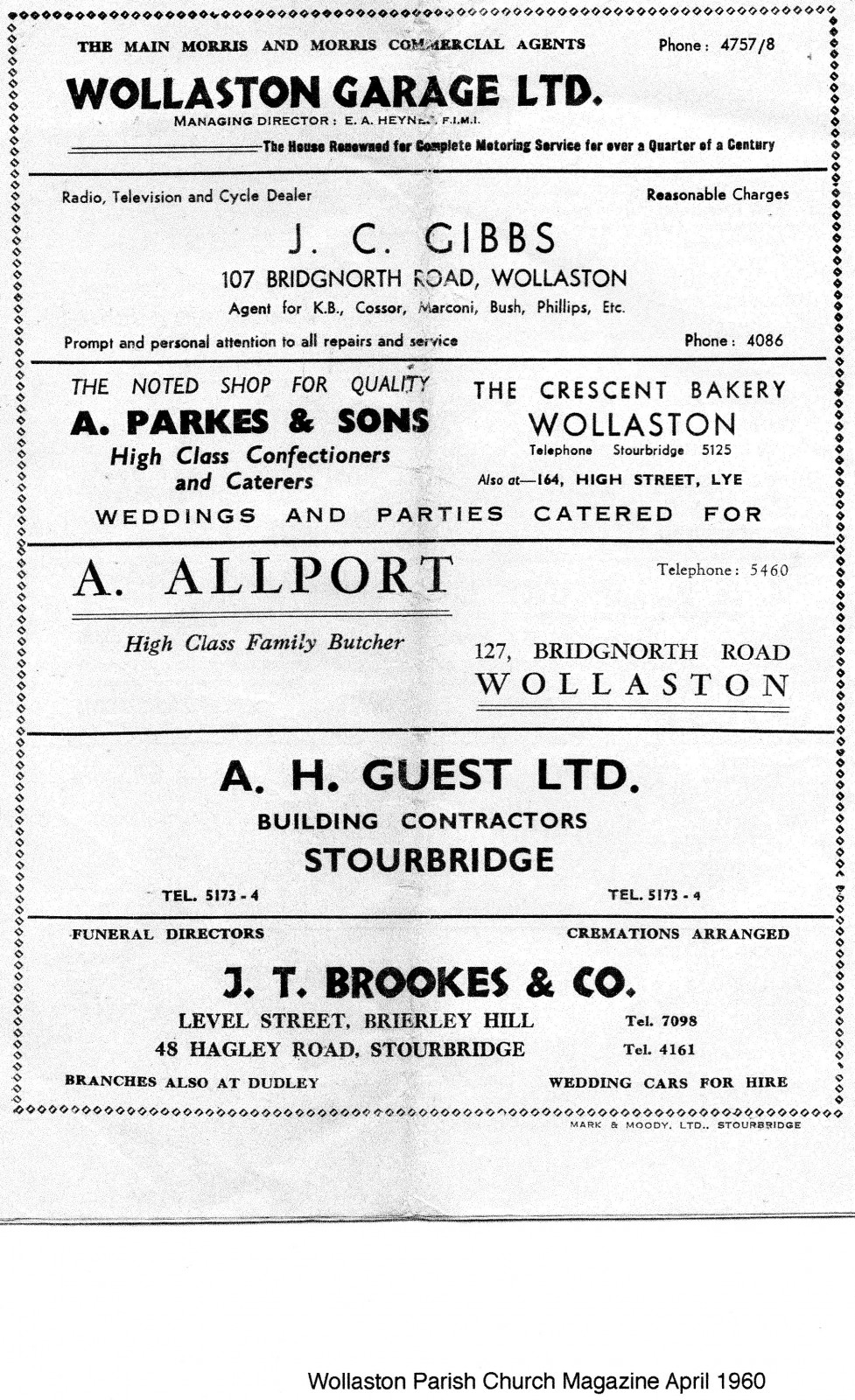
1960 Advertisements
1960s
Wollaston Parish Church Magazine for April 1960 had four pages of advertisements, most of them for businesses and shops in Wollaston. These six represent long established shopkeepers and well known councillors who represented Wollaston on Stourbridge Council. They were Eric Heynes of Wollaston Garage who was first elected an independent councillor in 1938. He served for 25 years, was appointed an alderman in 1952 and a magistrate in the 1940s. Alfred Allport, a butcher, was the last mayor of Stourbridge and active in raising money for the Senior Citizens’ Centre. In 1901 Albert Guest was appointed Churchwarden at St James’s Church and served for 16 years. He was a successful building contractor and owned sand and gravel mines at the Ridge. He gave 8 acres of land behind the schools which became the Recreation Ground, known as ‘The Rec’ . This was officially opened on 29th August 1921. He was appointed a J.P. in 1927 and died in at the end of that year.
.jpg)
Wollaston Infants’ School
1950s
This view shows the section of the old school building which was used as the Infants’ School until the infants moved to the new Meadow Park School on Kingsway in 1959. The juniors then occupied the rooms and there were adaptations made to them. This part of the building was demolished to make way for Belfry Drive which gave access to the houses built on the school playing field, Liddiard Court and the new Church Hall.
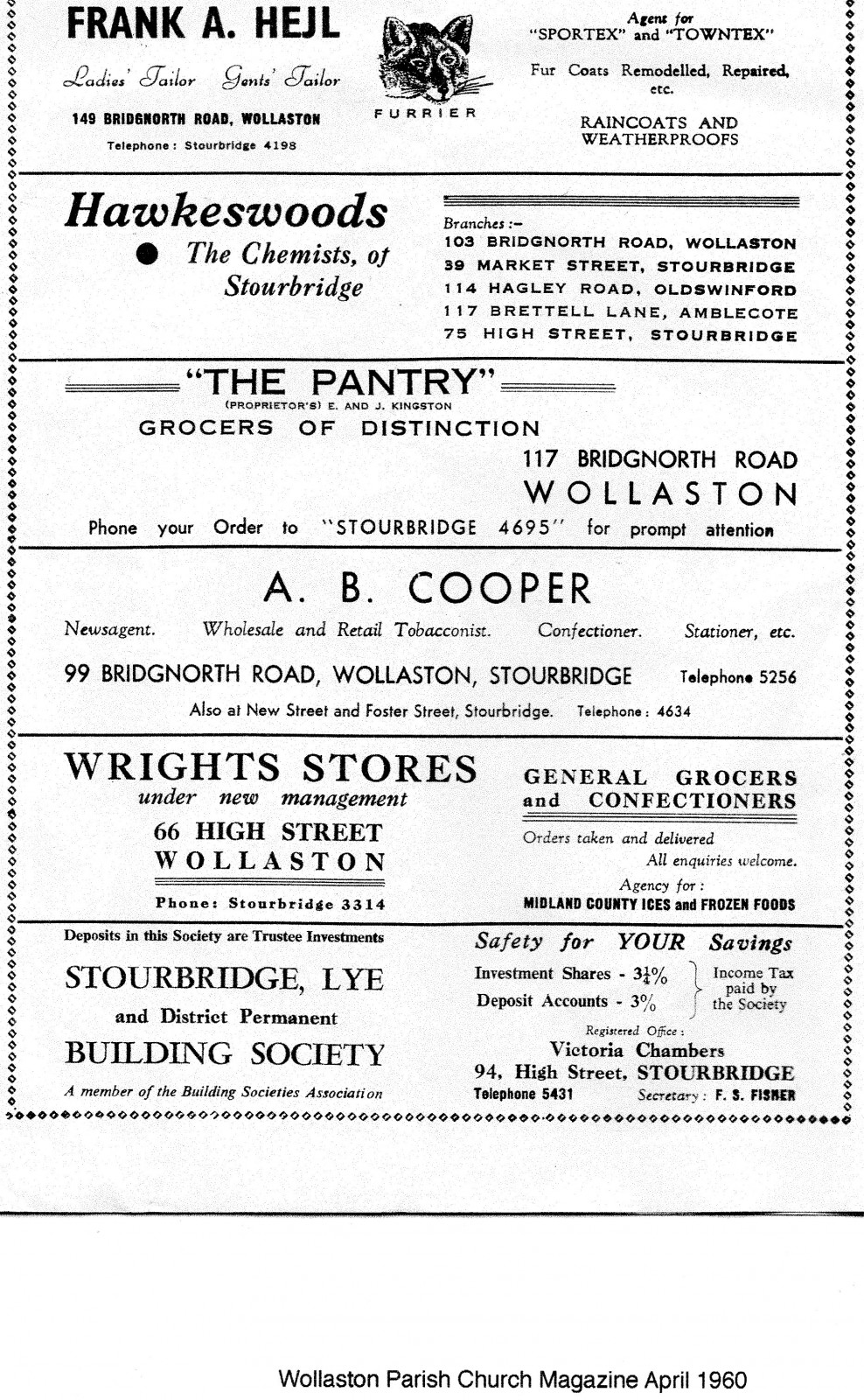
Advertisements from 1960
1960s
Of these advertisements which appeared in the April edition of the Parish Magazine in 1960 only one is still selling the same goods. A.B.Cooper ran the newsagent’s shop from 1939. He took over from Charles Smalley who had been there for over 30 years. Peter Cooper took over from his father and also ran a toy shop in what is now the Crescent Arcade. The shop has changed hands a number of times but is still a newsagents in 2012.
Frank A. Hejl’s shop was on the corner of Duncombe Street but was demolished in 1969 and SPAR was built on the site. A row of modern shops was built between Duncombe Street and High Park Avenue, with some parking in front and garages behind for the shopkeepers and occupants of the flats above. Hawkeswoods the chemists was opened in 1928 and served Wollaston and other areas of Stourbridge for 50 years. Cecil Hawkeswood died in 1984 and for a short time his son, Bob, continued to serve the villagers.
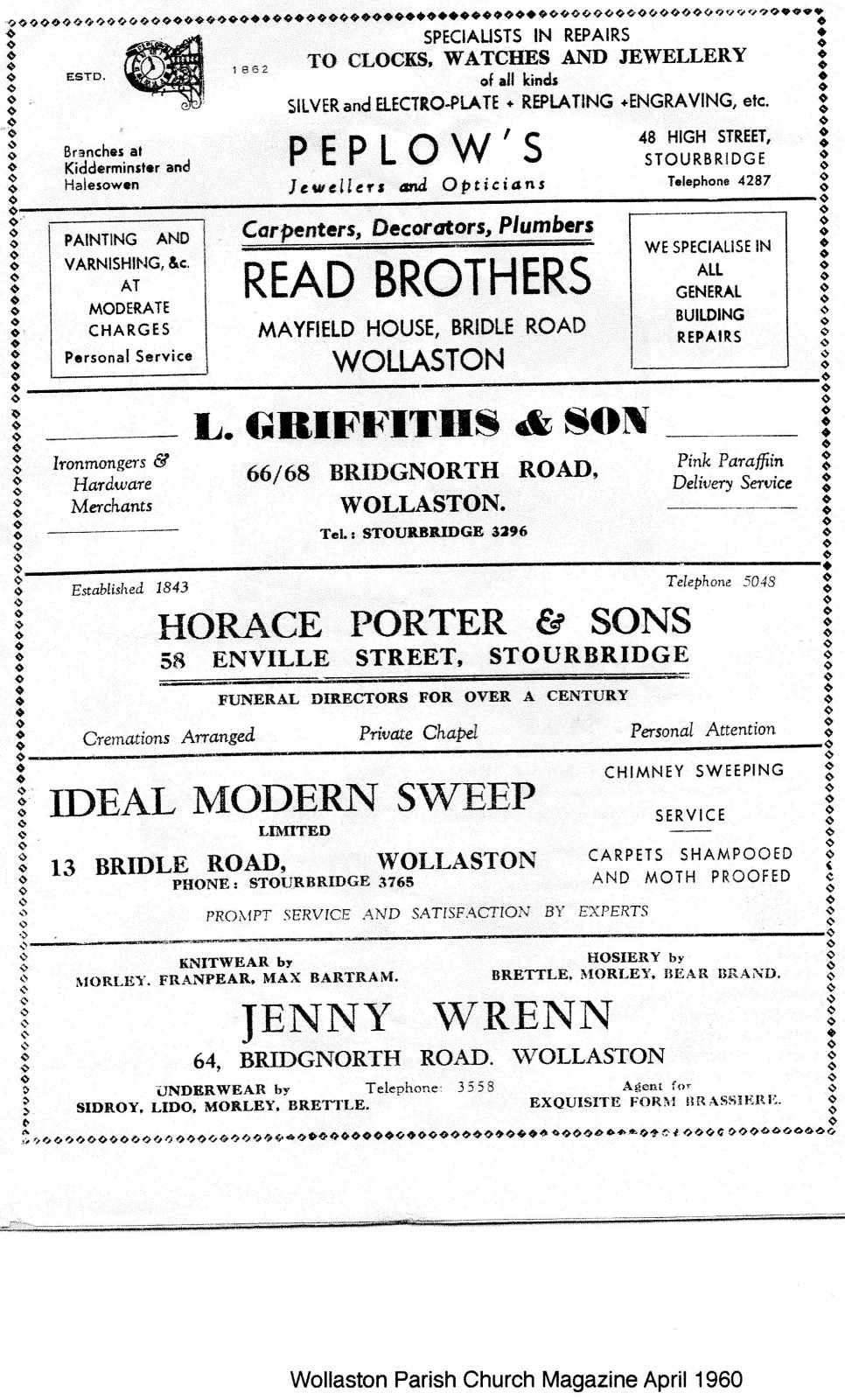
Advertisements from 1960
1960s
A copy of the Parish Magazine for April 1960 carried 24 advertisements for local shops and businesses in Wollaston and Stourbridge. The six shown here include two, an undertakers and the jewellers, which were in Stourbridge. Peplow’s is still in the same shop in Stourbridge High Street. The others include a chimney sweep who would have had plenty of work in the days when many houses still had open fires and it is interesting to note that he also offered carpet shampooing. The two shops in Bridgnorth Road were next door to each other.
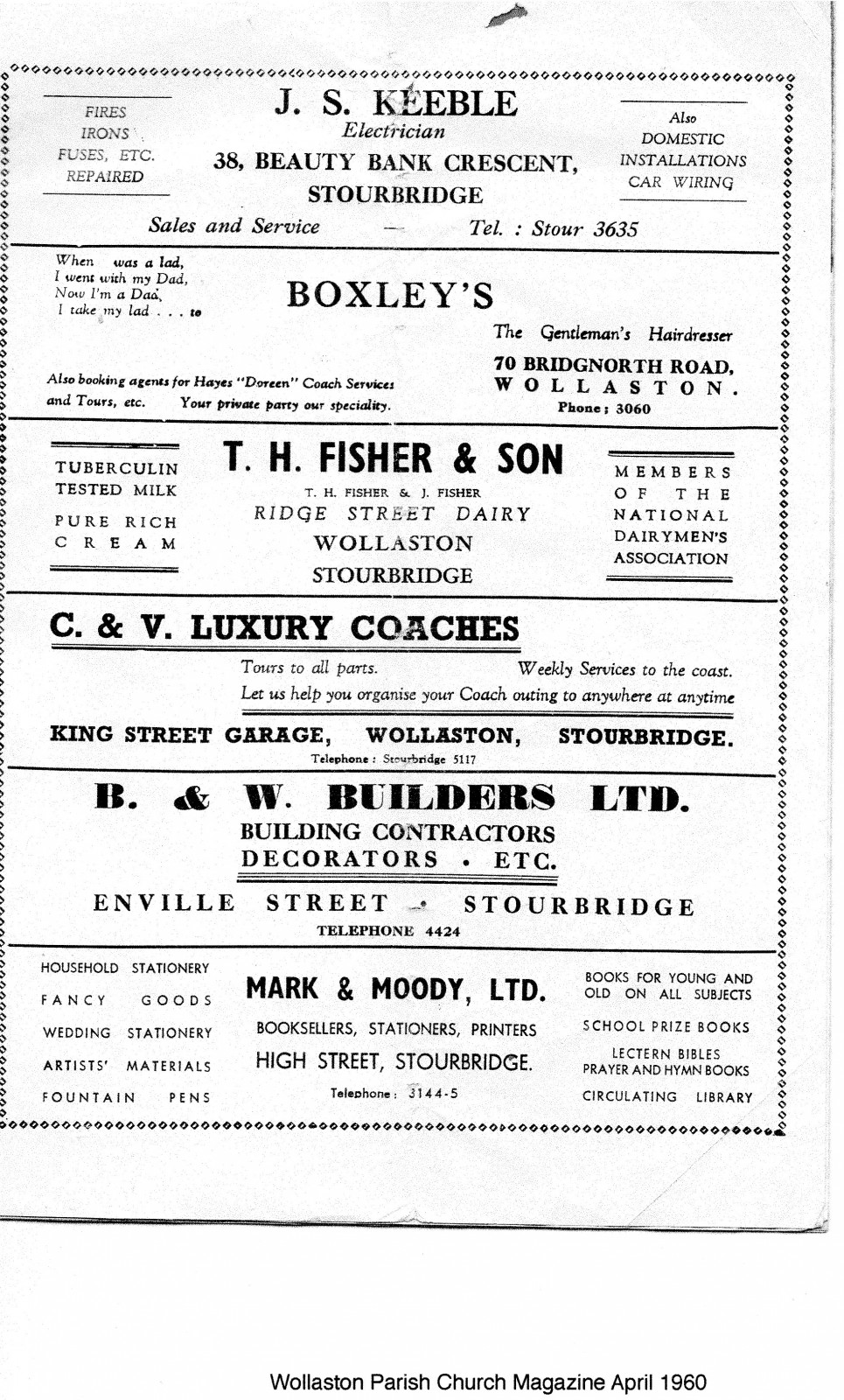
Parish Magazine 1960
1960s
In an old Parish Magazine dated April 1960 there were four pages of advertisements for local shops and businesses. Of the 24 adverts only seven were for addresses which were not in Wollaston. The rest give a good picture of shops you could visit in the village. They included some very long established ones and although some of the buildings remain the businesses are quite different. In this example J.S.Keeble came from Wollaston but his business was in Beauty Bank Crescent just over the Wollaston boundary. B & W Builders were in Enville Street, sections of which were in Wollaston. Mark & Moody was a long established outlet in Stourbridge which closed in the last years of the 20th century.
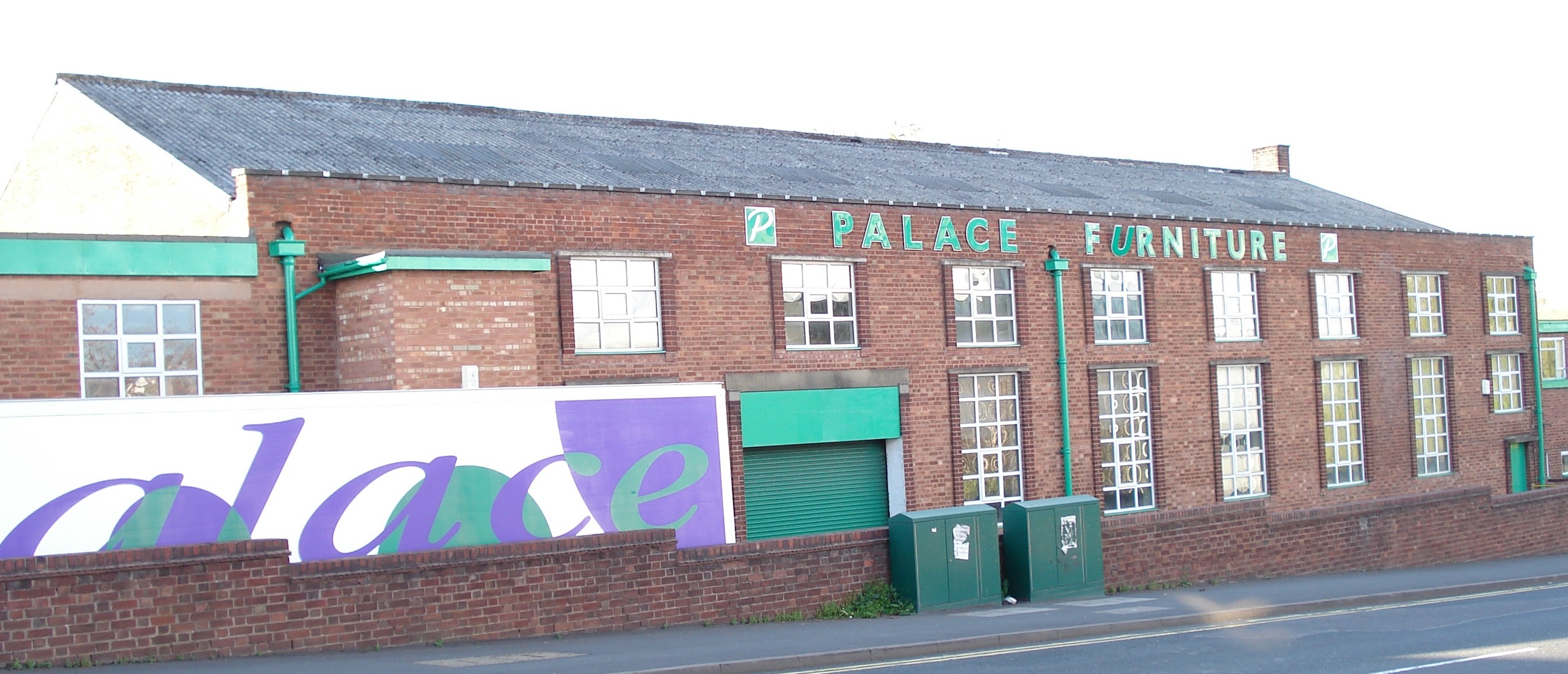
Palace Furniture
2010s
Stour House was built in 1957 for Farley Steel Industries. It changed hands in 1962 and again 10 years later when it became part of the BSR group who were established on the opposite side of High Street and where record changers had been manufactured. They had been a major employer in Wollaston and the surrounding area. The new property became Astec and lasted until about 1989. It is now occupied by Palace Furniture who make furniture for pub, restaurants and other public buildings.
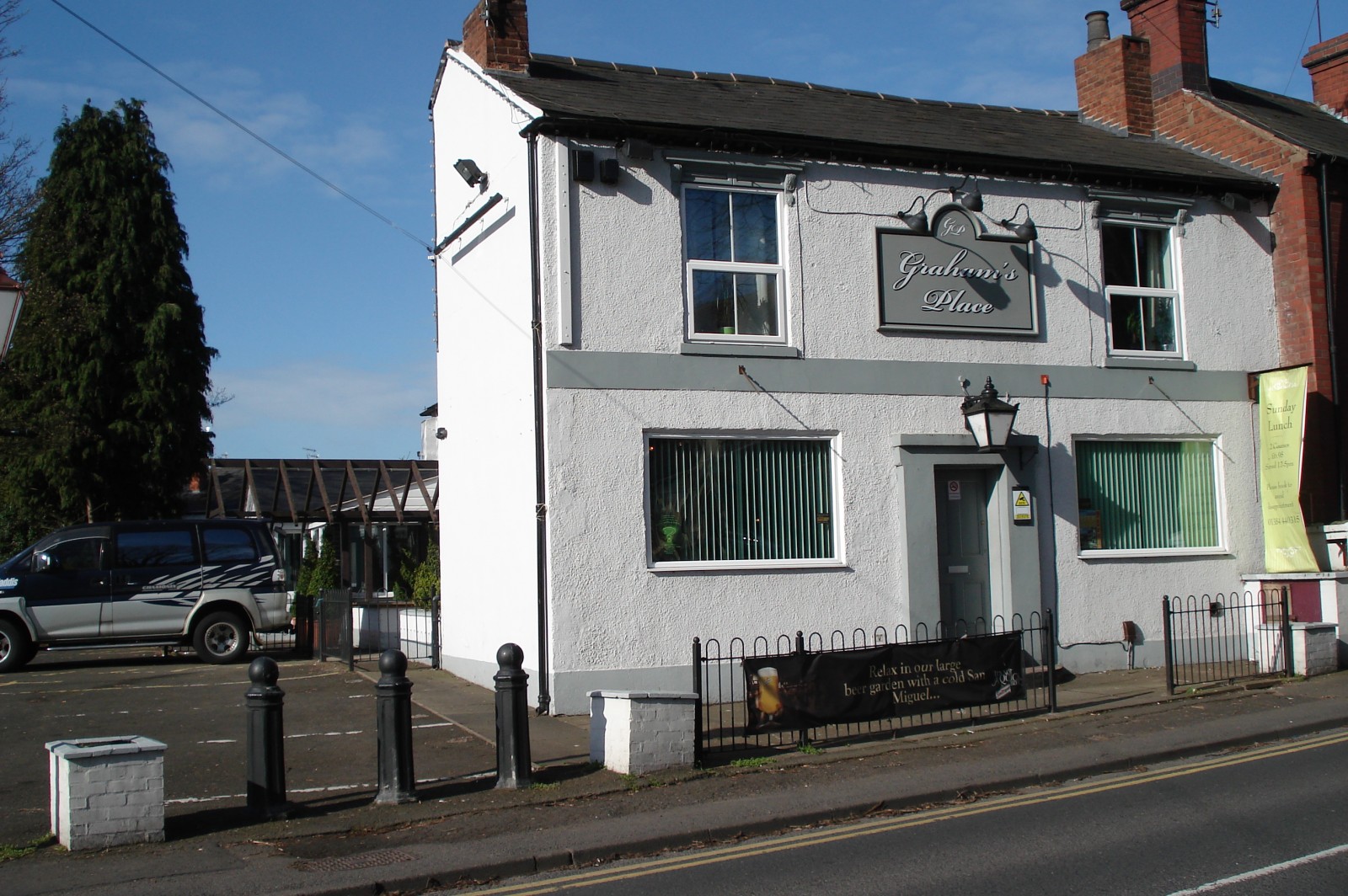
Graham’s Place
2010s
The Cottage Spring was open in 1851 when there was a bowling green and garden attached to the public house. Its position is in Bridgnorth Road just opposite St James’s Church. It was taken over by Graham Webster and renamed Graham’s Place in about 2009 and now includes a restaurant.
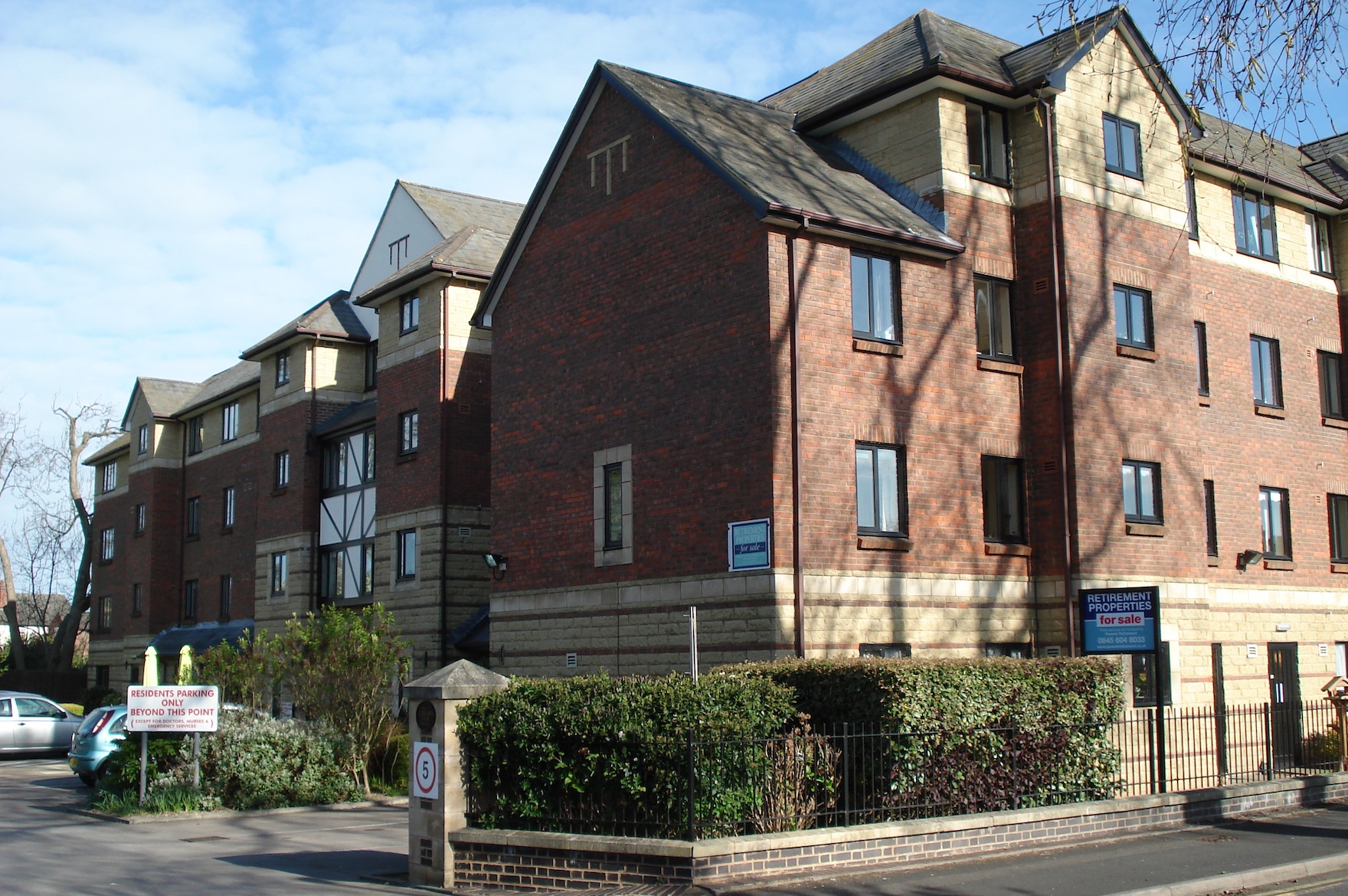
Liddiard Court
2010s
Built in 1993 Liddiard Court occupies the ground which was originally the playground area of Wollaston Schools. There are 50 flats offering accommodation for elderly, retired people in one and two bedroom flats. There is a communal lounge and activities are organised there for the occupants. There are guest facilities, a lift ,a laundry and garden. There are visiting hairdressers and chiropodists. Resident management staff and a community alarm system are also on site. The property was built by McCarthy & Stone Retirement Lifestyles and is managed by Peverel retirement.
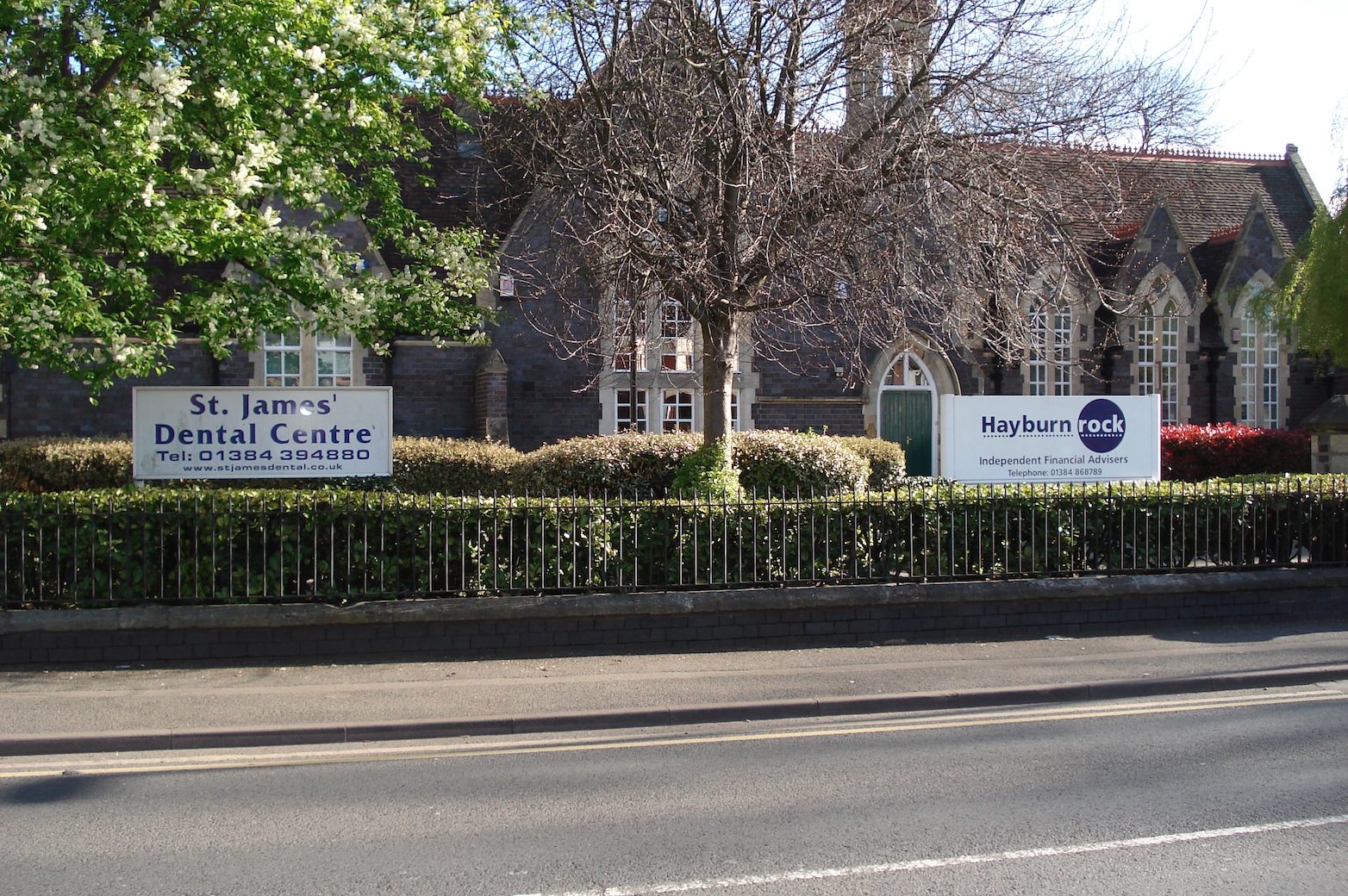
The old school building
2010s
After the sale of the village school building and the land behind it in the 1990s part of the school was demolished and the rest was adapted to provide commercial premises. The notice board shown here advertises a dentist’s and a firm of independent financial advisers. The building took on a new name - St James’s Court.
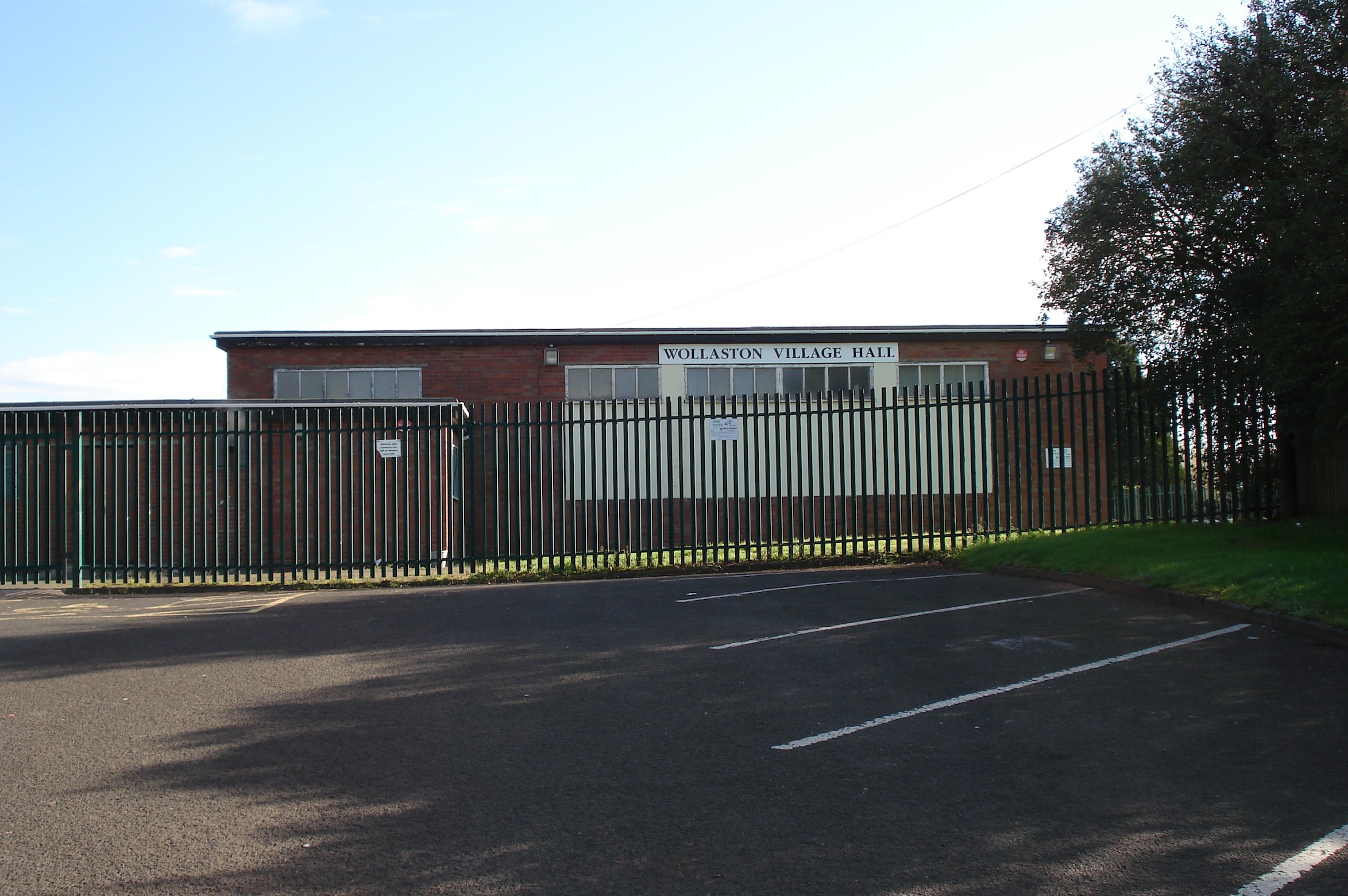
Wollaston Village Hall
2010s
During the 1960s & ‘70s many fund raising events were held on the Rec to build a centre to be used by the senior citizens of Wollaston. Councillor Alfred Allport was the driving force behind this project and over the ten years £12,000 was raised. It opened in 1973 but in the early years of the 21st Century it took on a new role. The wide ranging activities which now take place there are aimed at all ages and in 2000 the building was renamed Wollaston Village Hall.
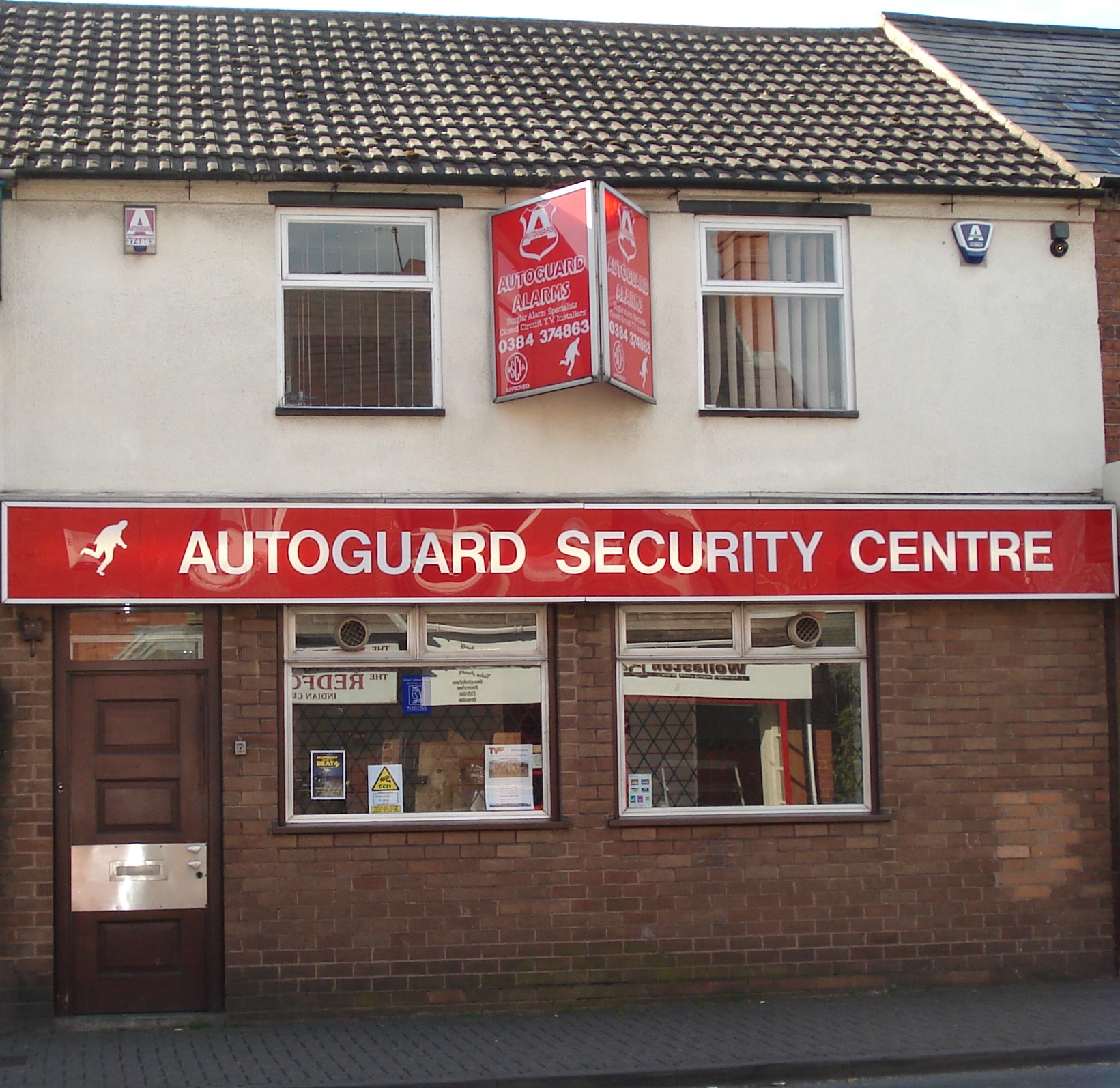
Autoguard in Bridgnorth Road
2010s
The premises now occupied by Autoguard was a branch of the Midland Bank which had opened in 1949 at 125 Bridgnorth Road. In 1991 it closed and the building was taken over in by a security firm offering among other devices burglar alarms.
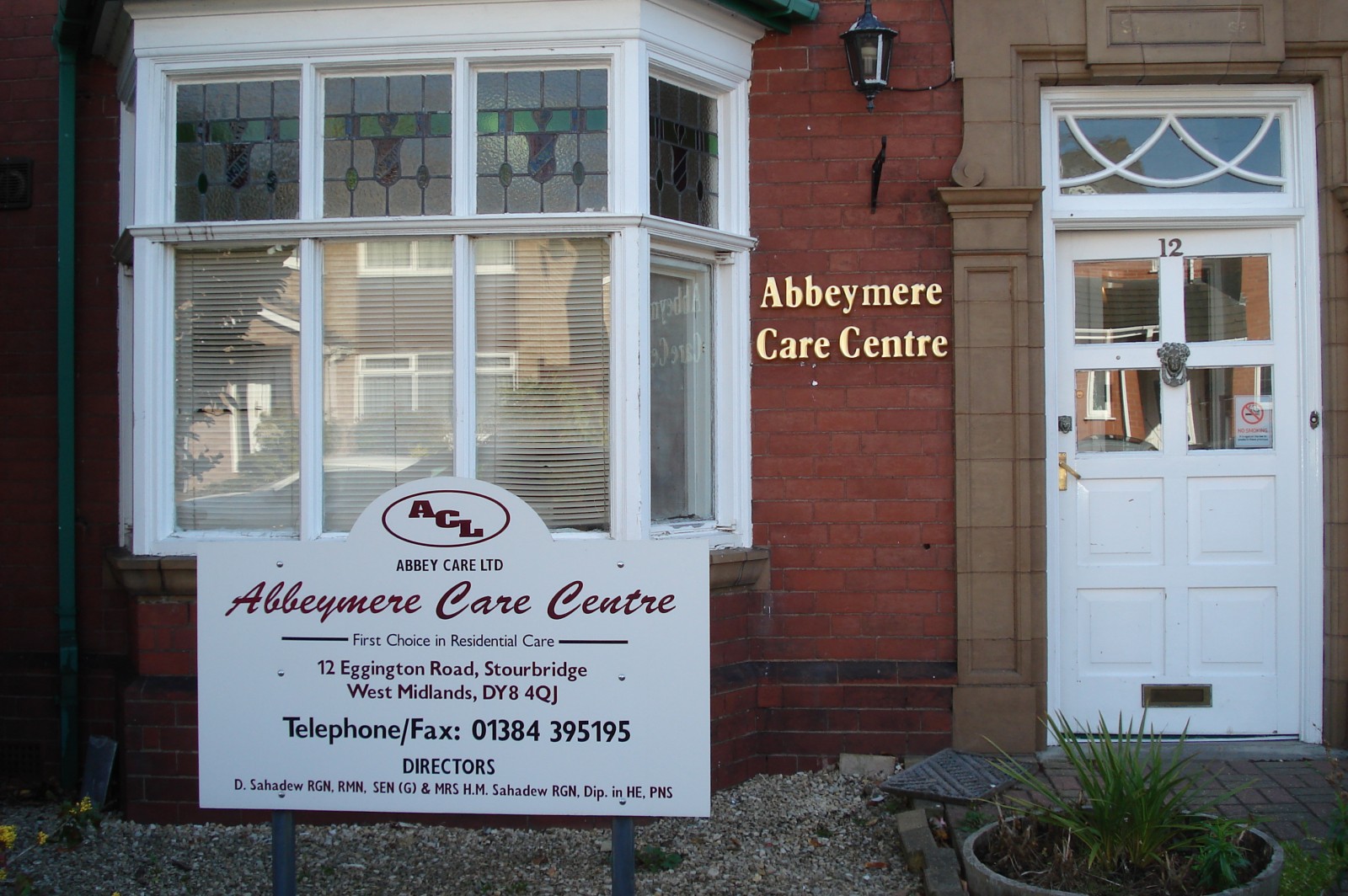
Abbeymere Care Centre
2010s
Abbeymere Care Centre offers accommodation for 18 residents in single rooms, 6 with ensuite. It was formerly called Strad House and was part of Karelink Ltd. It is now owned by Mr & Mrs D.Sahadew.
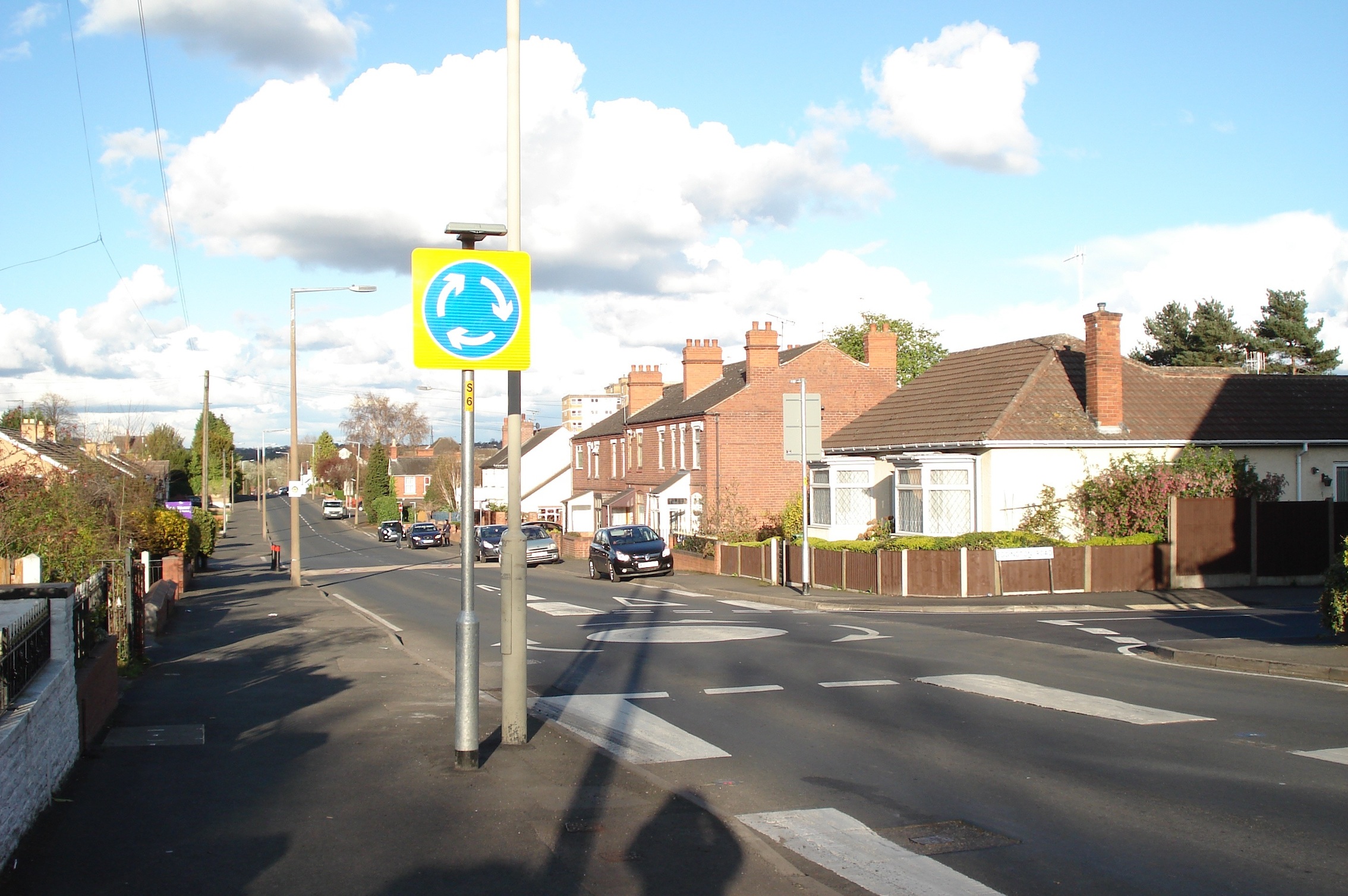
The new junction in Vicarage Road
2010s
A traffic calming measure was built in Vicarage Road in March 2012 at the junction with Eggington Road. The mini island was constructed and traffic now has to give way to traffic coming from the right. After this was built the long overdue resurfacing of Eggington Road was completed. At the same time a pedestrian refuge was installed at the other end of Eggington Road.
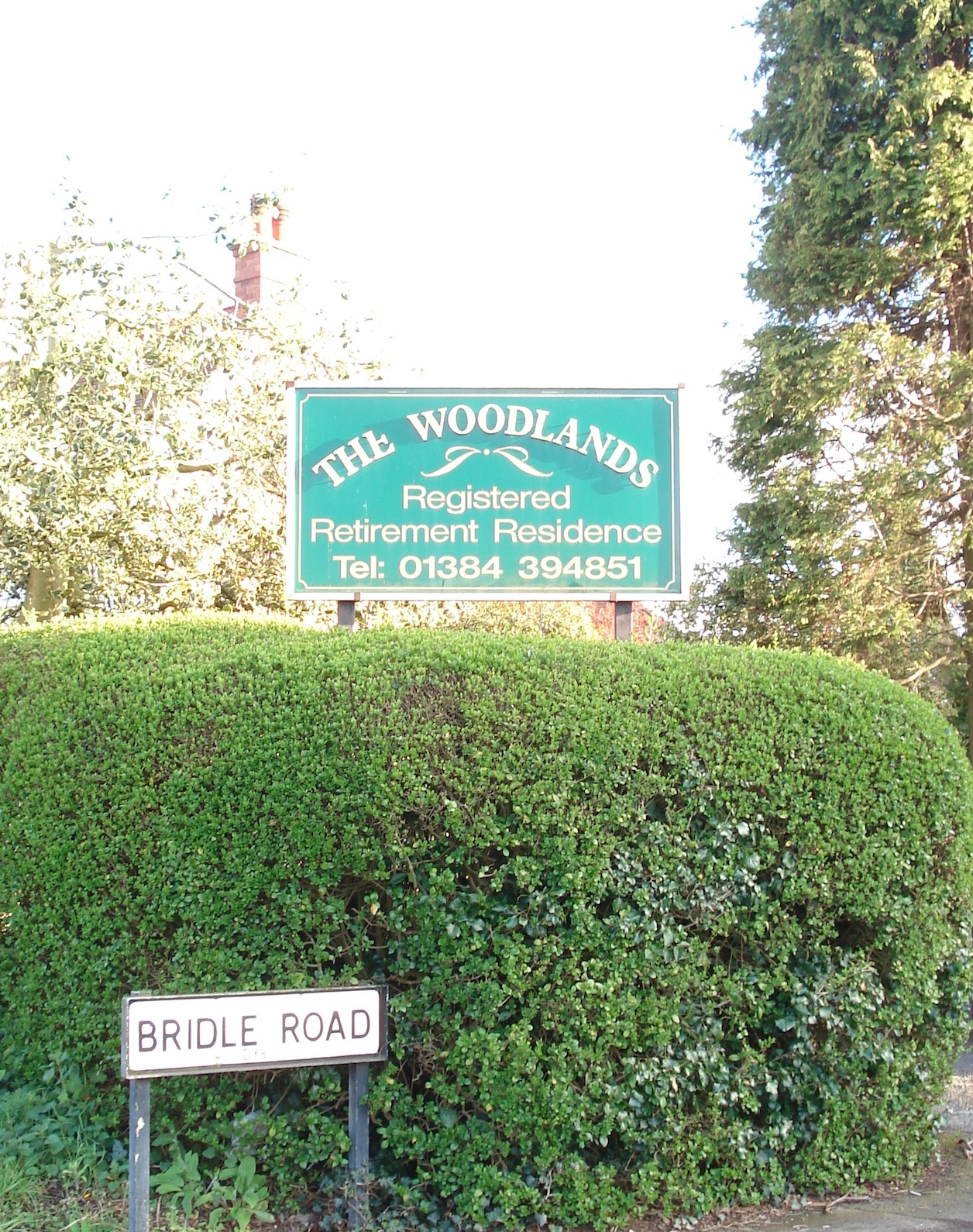
The Woodlands Retirement Home
2010s
The Woodlands was built in the early years of the 20th century and was converted into a retirement home with additional accommodation in the detached house which had been built in the garden of the older property. These were linked by a conservatory.

Rosemary Retirement Home
2010s
This is one of three retirement homes in Wollaston and was the home and surgery of Dr Michelson. After enlarging the building Mr & Mrs N.R. Smith opened the home. It offers accommodation for 23 residents, with 10 ensuite rooms and offers respite care as well as full time care for elderly residents.
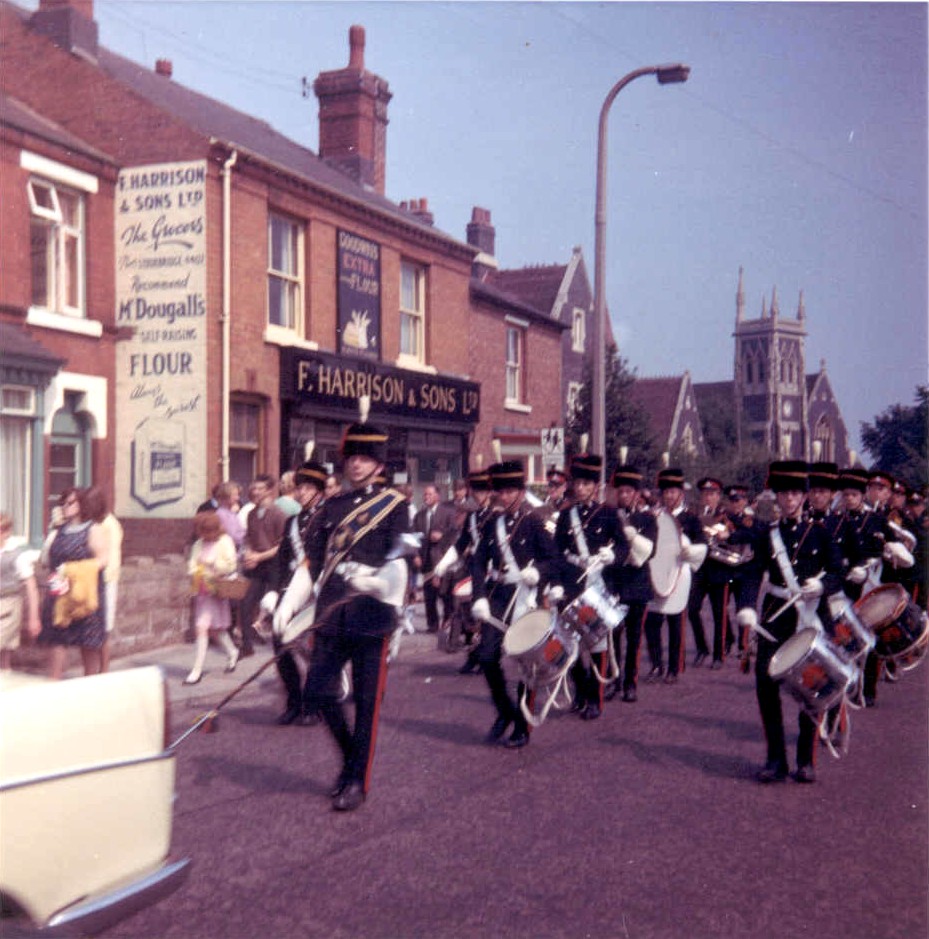
Carnival
1960s
There were many carnivals and parades held in Wollaston in the 1950s and ‘60s. Some were held to raise money for the building programme for a Senior Citizens’ Centre and some were part of a Stourbridge Carnival. This picture was taken in Bridgnorth Road with the parade passing Wollaston Garage and the grocery shop belonging to F. Harrison & Sons. This shop closed and is now Fletchers Wine Shop.
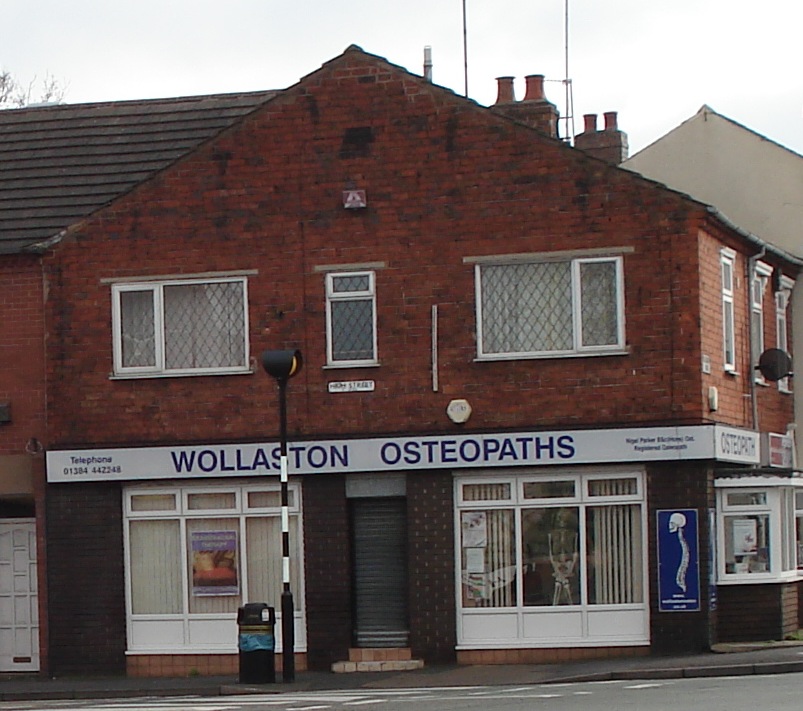
The Osteopaths
2010s
The Osteopaths is one of a number of businesses offering alternative medicine in Wollaston and is on tne corner of High Street and Bridgnorth Road. Previously the premises was a fishing tackle outlet.
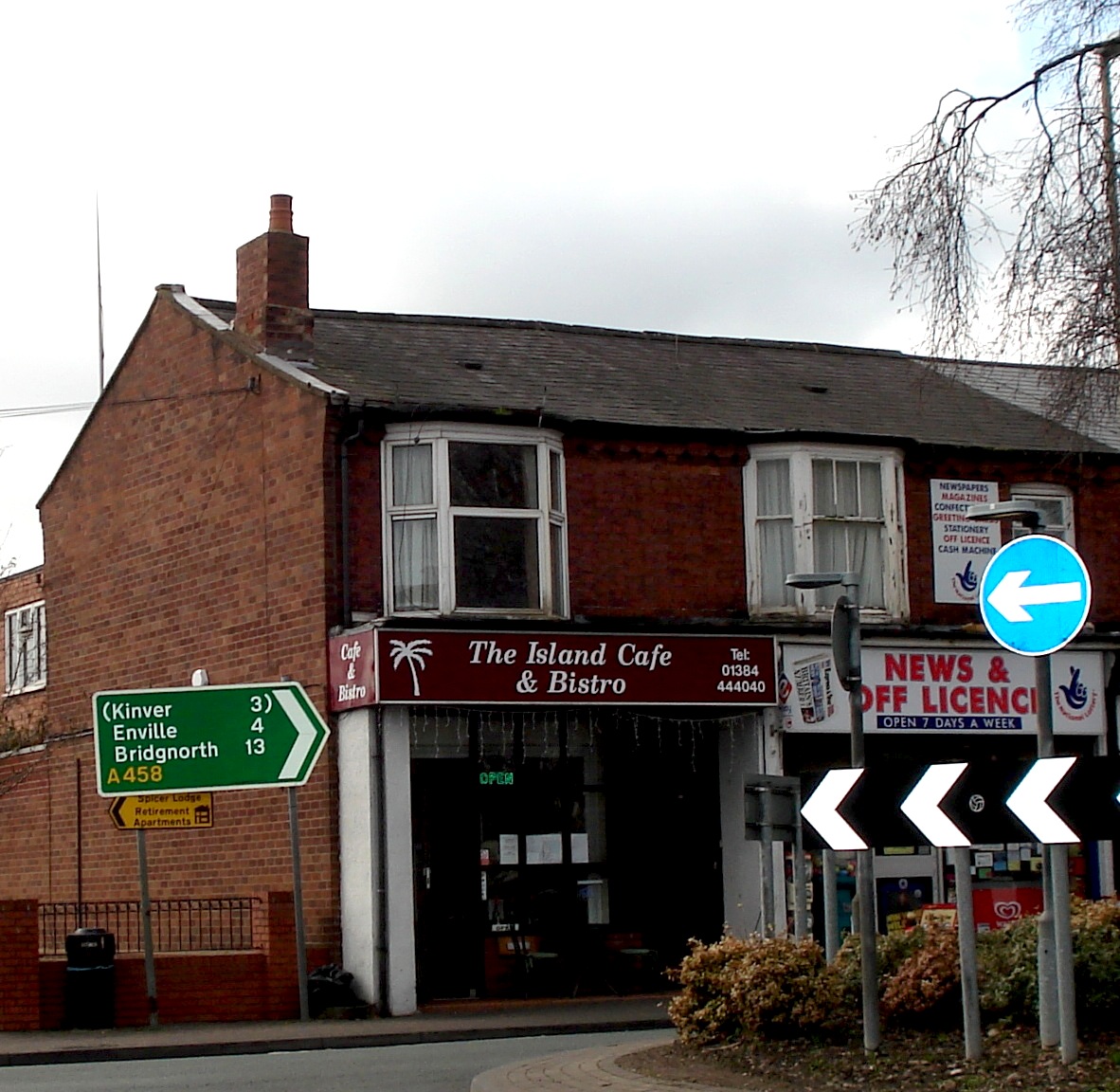
The Island Cafe
2010s
This property was once the end house in a terrace of small houses. Gradually all the houses have become shops and this one has traded as a greengrocers, Bytetech computer shop and now a cafe serving from early in the morning with breakfasts and throughout the day. Tables are served outside for customers who wish to smoke.
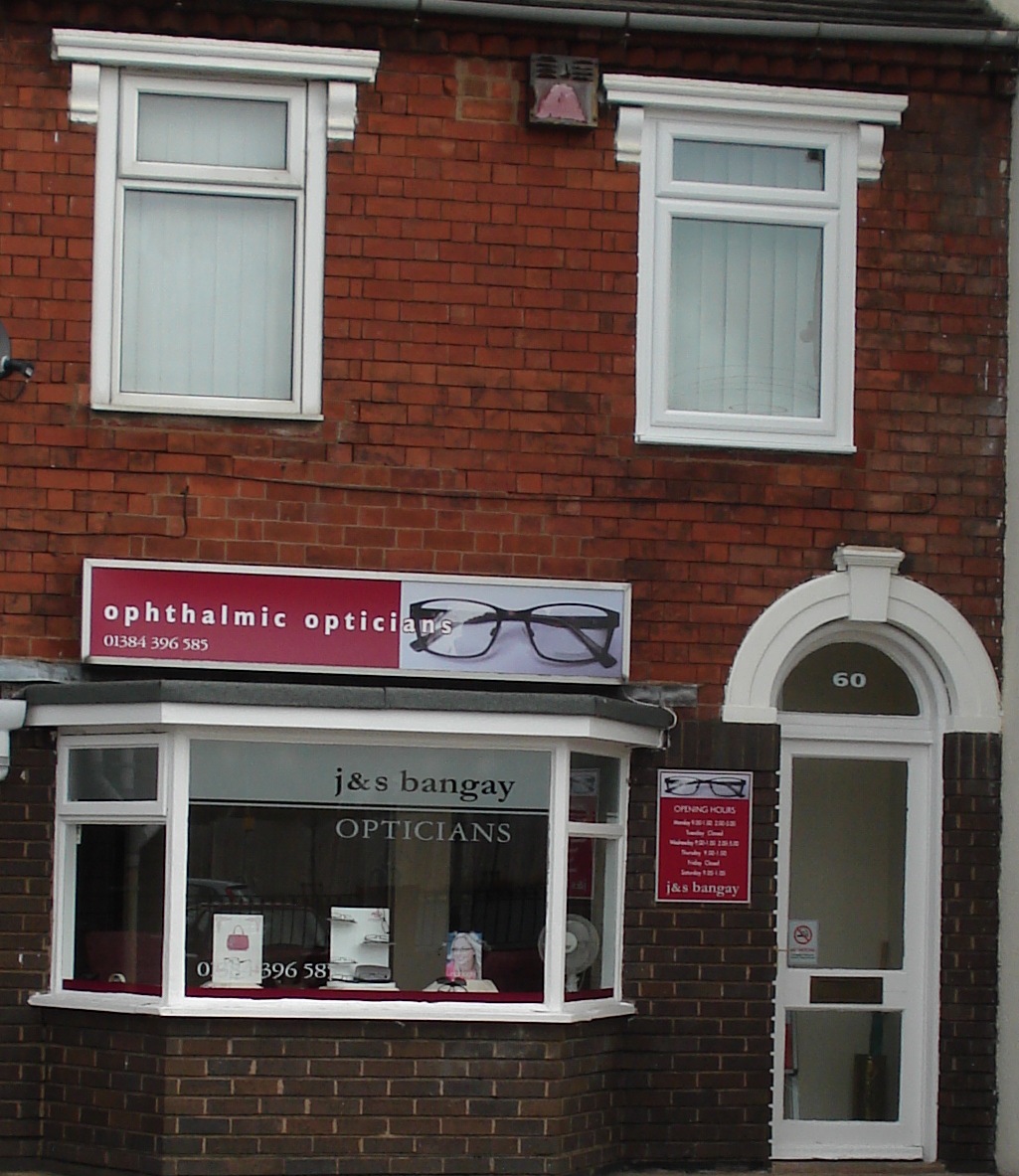
Ophthalmic Opticians
2010s
There has been an opticians in Bridgnorth Road for many years and L.A.Mayne, optometrist, was practising there since at least the 1990s. He retired in 2011 and the business now trades as j&s bangay. This is another branch of the medical professions which are very well represented in the village.

Compton Hospice Charity Shop
2000s
Charity shops have opened in most ‘High Streets’ in towns throughout the country. Th premises shown here were once a greengrocery shop on the corner of Cobden Street and Bridgnorth Road. It was opened in the first decade of the 21st century and supports the Compton Hospice in Wolverhampton.
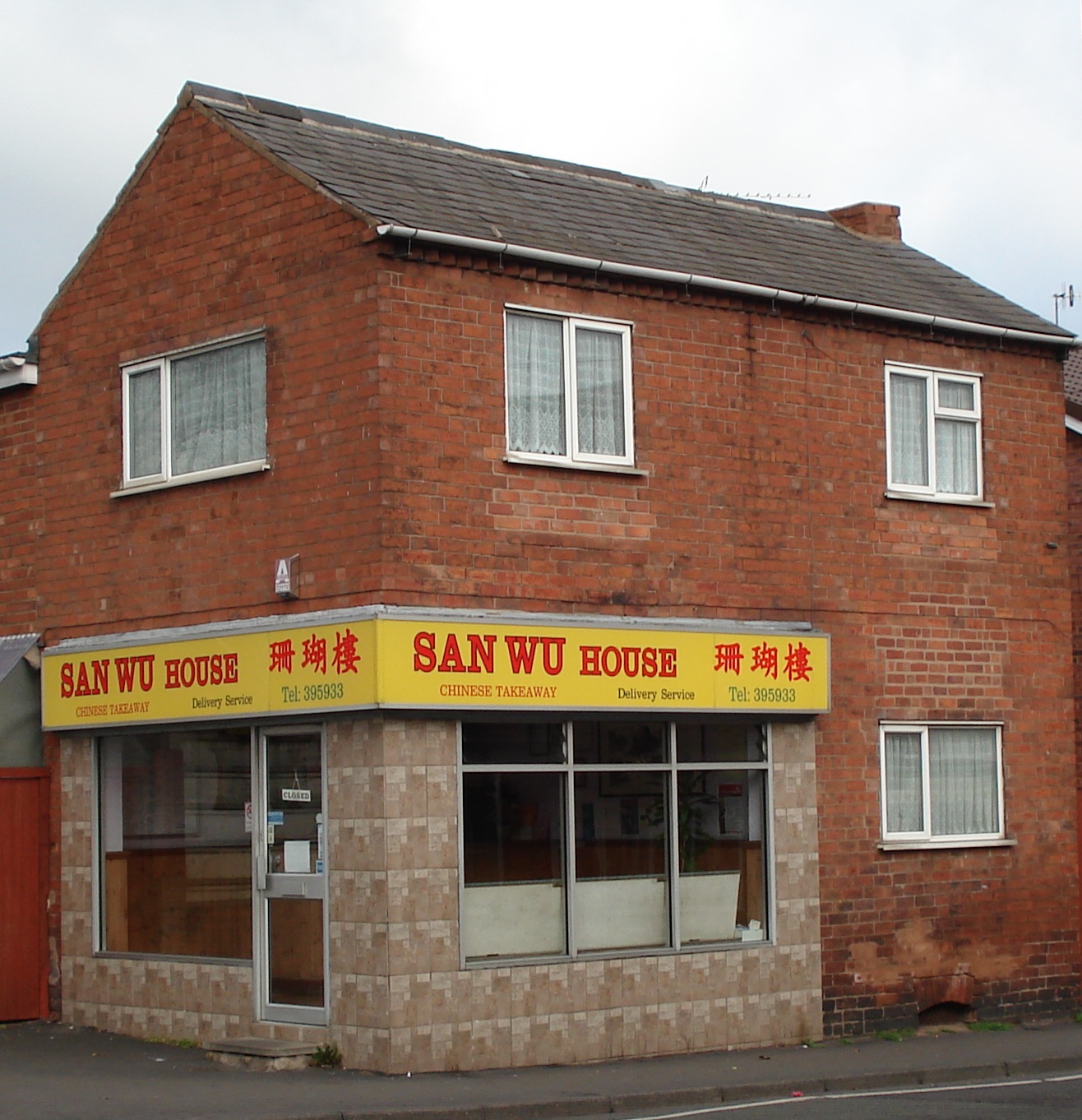
The San Wu Chinese takeaway
2000s
There are now two Chinese takeaways in Wollaston. The first one was San Wu which occupies the property at the corner of High Street and Meriden Avenue. It opened in 1982 and was completely refurbished in 2003. The building has previously housed a fish and chip shop and a dry cleaners. The second one to open is the Happy House on Bridgnorth Road where it occupies the former Allen Decorators premises.
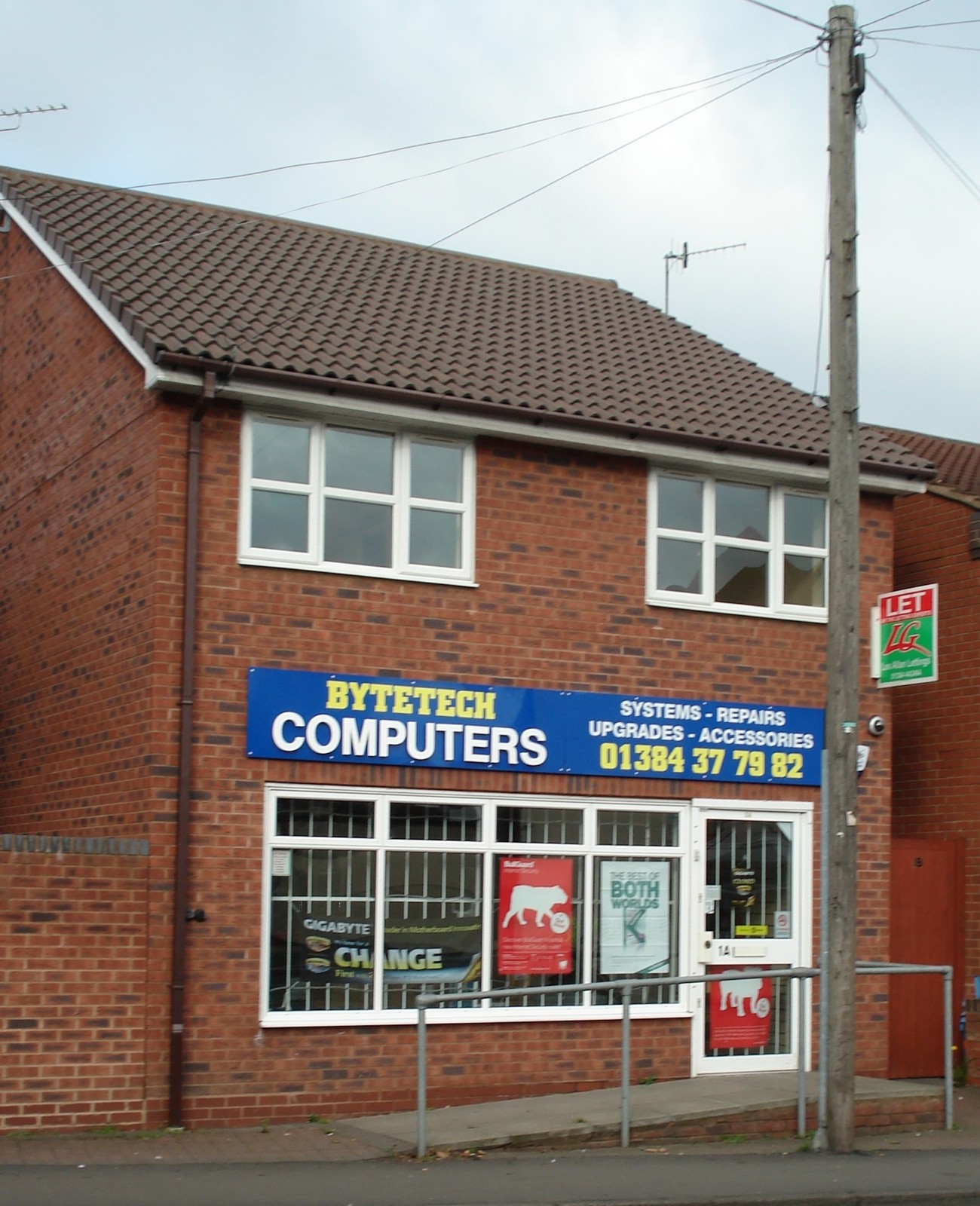
Bytetech
2000s
In the 21st century computers and suppliers of materials for use on computers have become a familiar sight in many parts of the area. Many are large outlets such as those at Merry Hill shopping complex but in Wollaston a small privately owned shop has opened in the premises which were formerly the Party Shop in the small development next to Chinese takeaway at the village end of High Street.
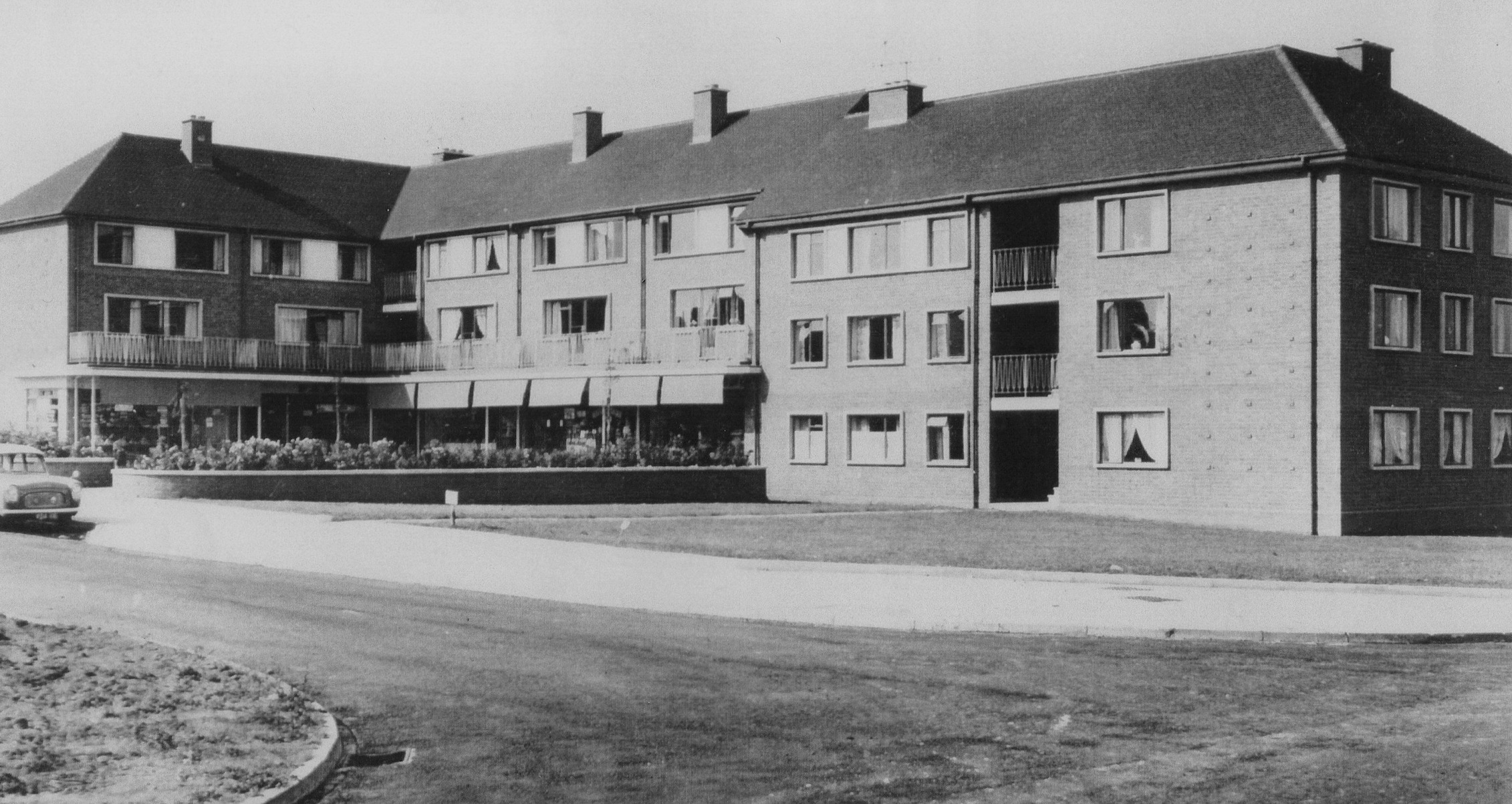
Wollaston Farm Estate
1950s
Plans for a housing development on Wollaston Farm were first discussed by Stourbridge Council in the 1930s. The war meant that there was a delay in planning and construction until the 1950s. In August 1952 the plans were finally approved and building began in 1952. Building was planned in stages and the shops and flats shown here were completed by May 1954. The main road which ran round the boundary of the estate was named The Kingsway and over 600 houses were built. This photo shows the row of shops just below Meadow Park Infants’ School, which opened in 1959, now St James’s Primary School.
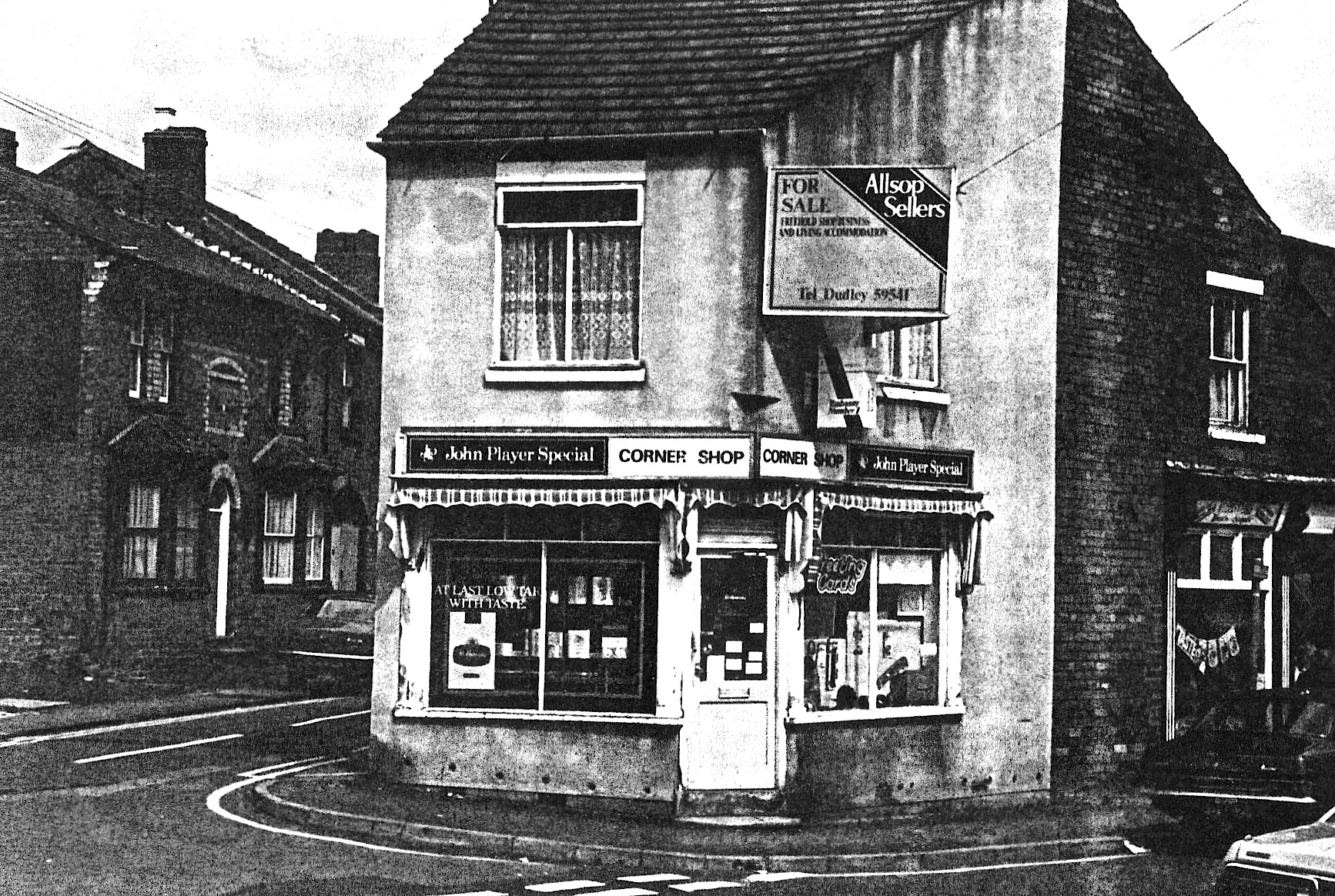
Wood Street Corner shop
1970s
This small shop on the corner of Wood Street and High Street sold sweets and tobacco products. It was bought by the green grocery shop next door belonging to the Webster family and is now part of their enlarged shop, a photo of which can also be found on this web site.
The public house, The Rifleman’s Arms, can just be seen on the other side of Wood Street. This was closed in 1978 and became a private house.
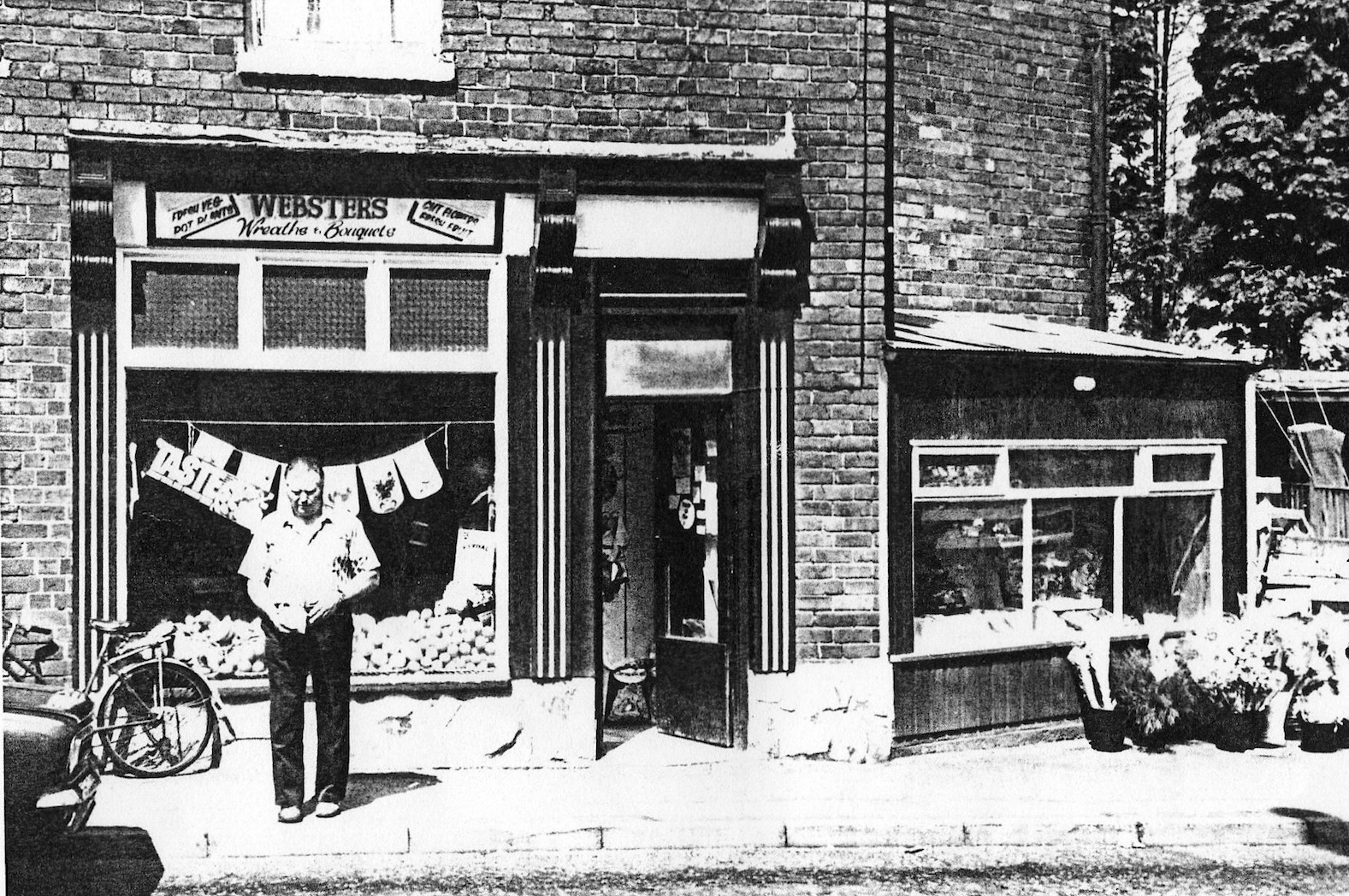
The original Webster’s shop
1960s
The building shown here was how the first greengrocery shop looked when it was opened by Mr & Mrs Webster in the 1960s. The original building was much smaller than it is in the 21st century and is still run by the second and third generations of the family.
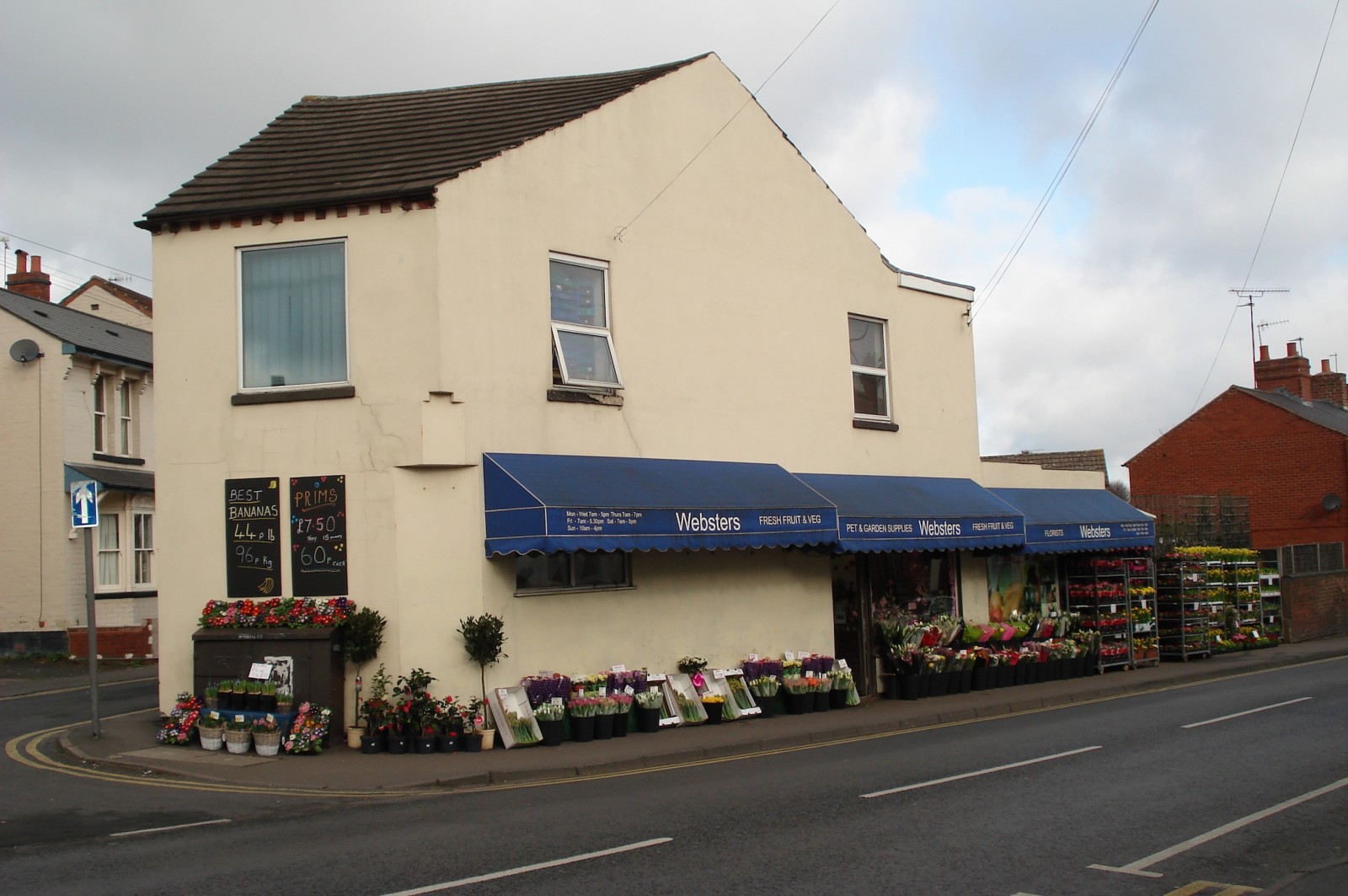
Websters shop
2010s
Mr & Mrs Webster opened their small greengrocery shop in 1967 and it is still run by the same family, now with the second and third generation. Originally the shop was only a small building and the shop on the corner of High Street and Wood Street was a sweetshop and tobacconist. The range of produce has increased greatly since more space was available and it now sells cut flowers, plants, fertilisers and other garden needs, pet foods and wild bird food. The display outside is colourful as can be seen in this photograph.
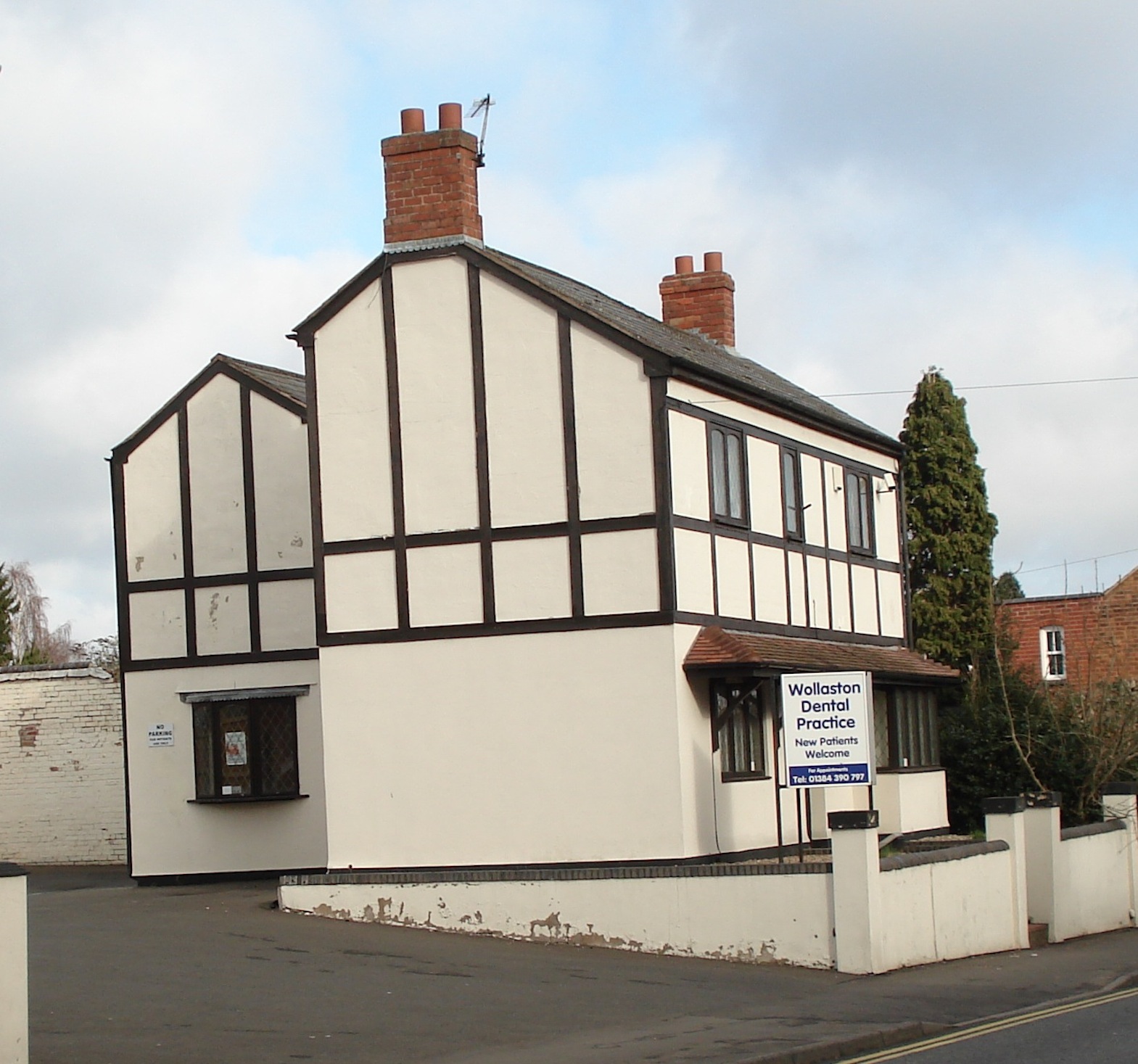
Wollaston Dental Practice
2010s
There are now three dental practices in Wollaston. This one was adapted from a house in High Street and the garden became a car park. They offer both private and NHS dentistry.
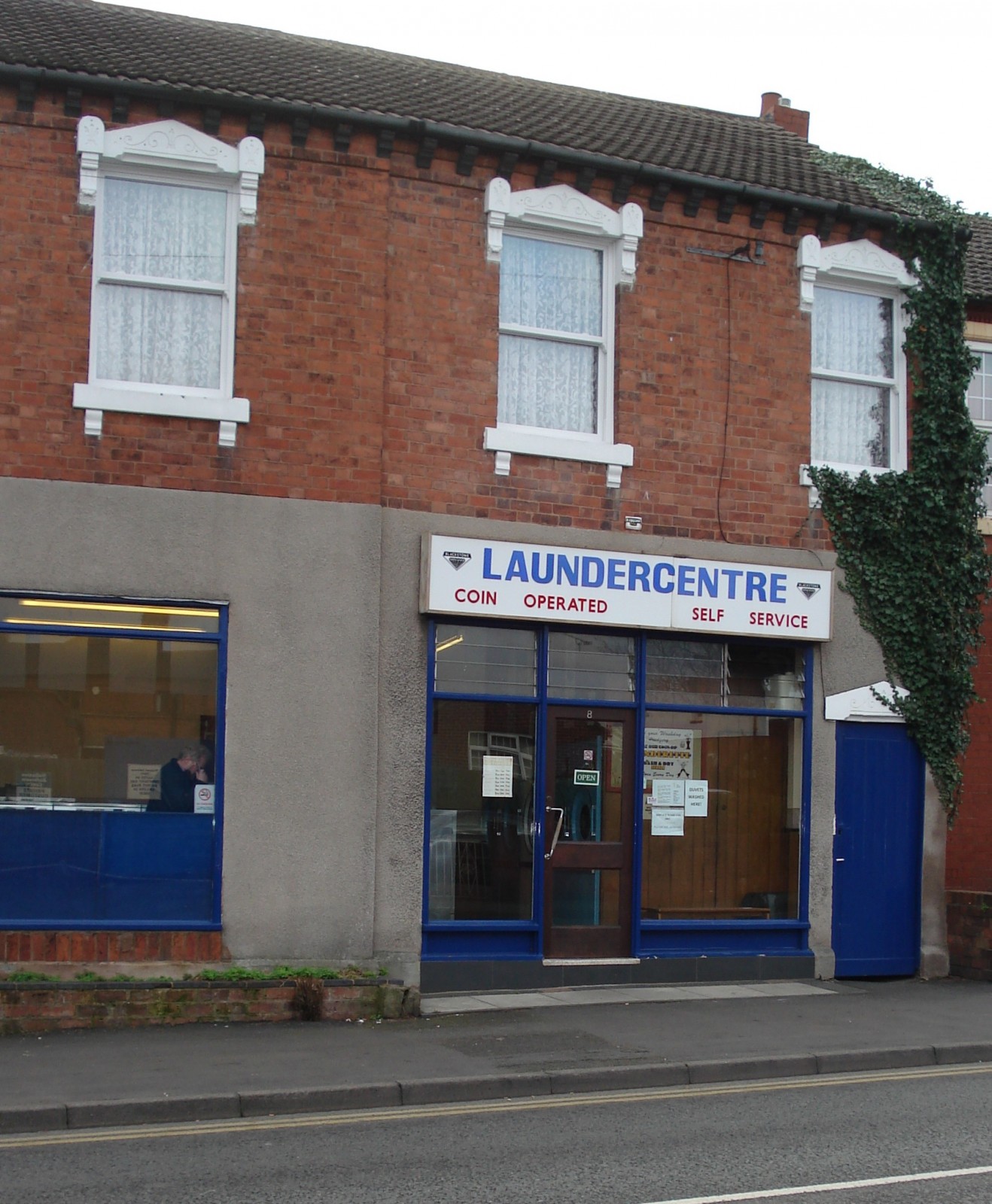
The Launder Centre
2010s
There were two houses on this site which have been adapted as a Launder Centre. For many Wollaston inhabitants of the past this business would be unfamiliar. When most washing was undertaken at home before electrical washing machines and dryers were common, the weekly wash was hard work. Today if you haven’t the space for a modern washing machine or dryer, a facility like this makes light work of the washing.
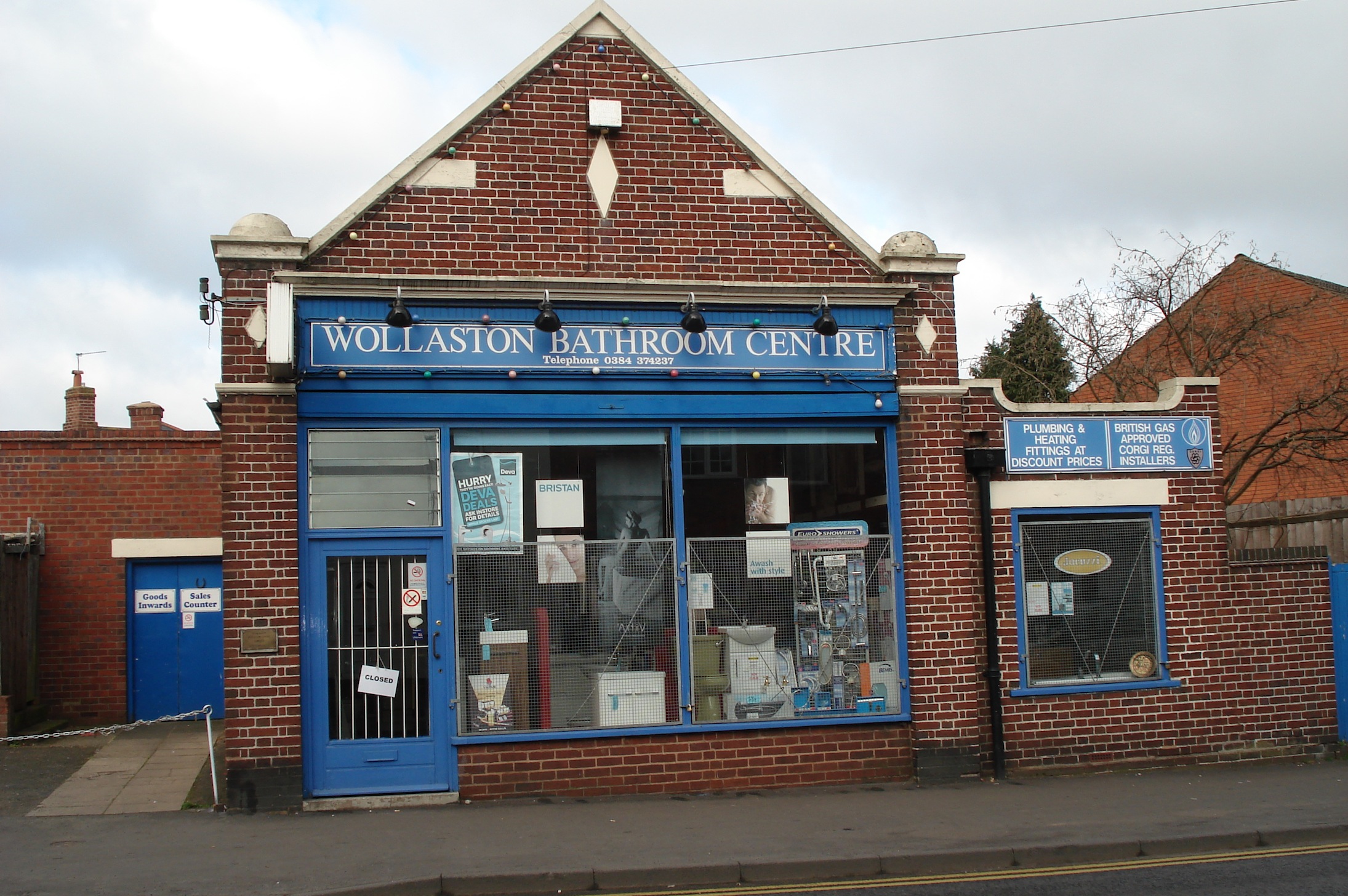
Wollaston Bathroom Centre
2010s
The building was originally built as a Co-op grocery shop. For many years it traded as Audnam Plumbing but is now called Wollaston Bathroom Centre. As well as offering bathroom designs, surveys and supplying the bathroom furniture there are qualified plumbers who can carry out the installation and other plumbing services as well as offering service for central heating boilers.
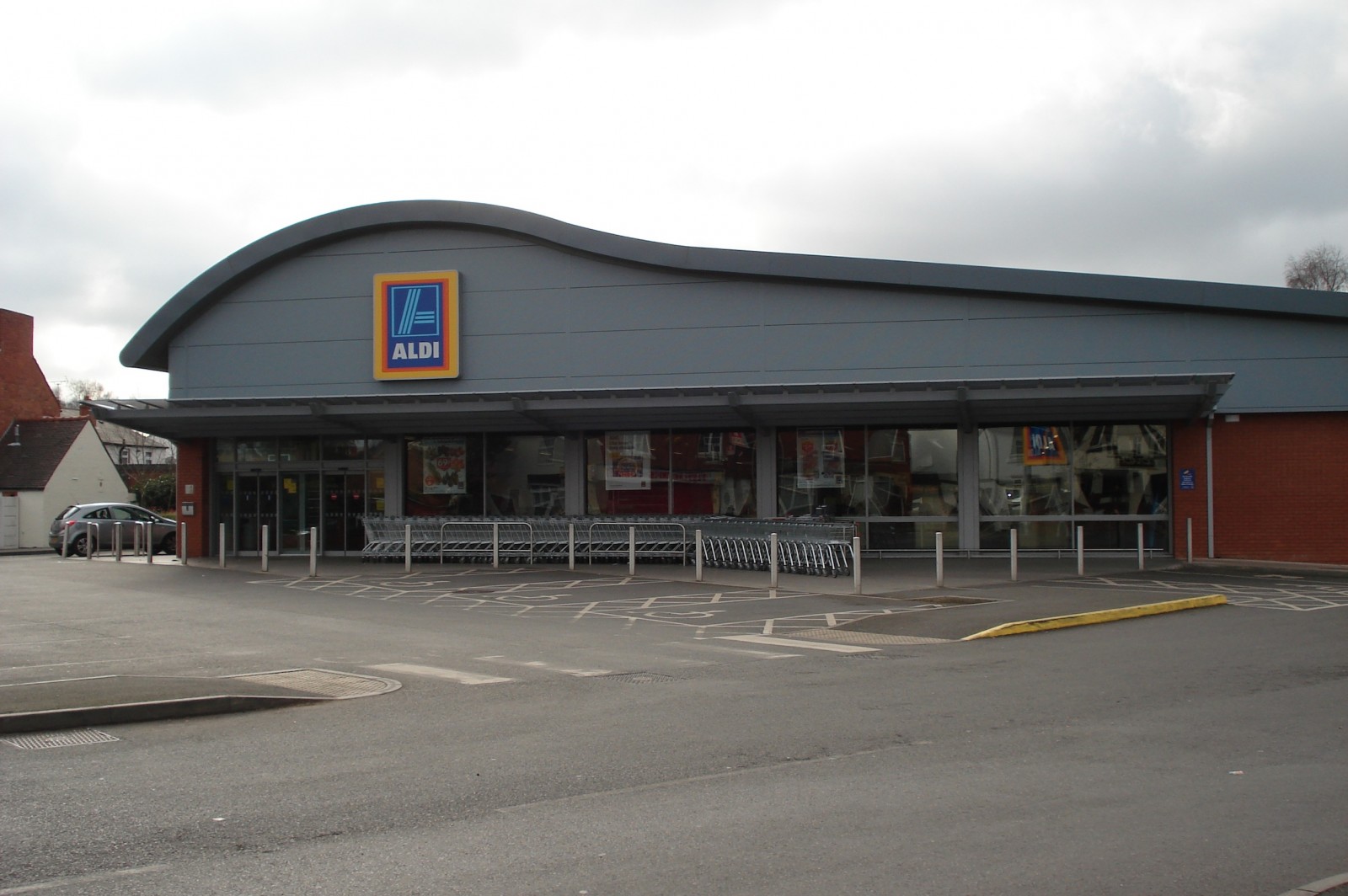
ALDI
2000s
When Wollaston Garage closed the land was cleared and a new supermarket was built with a car park in front and to the side. It is busy with many shoppers coming by car from other parts of Stourbridge as well as many people who live nearer walking there. It has proved a useful addition to the shopping area for the people who live in the block of retirement flats just across the other side of the road. It offers a wide range of groceries with special offers of non-food items available on Thursdays and Sundays and for those shoppers who have internet access the special offers can by downloaded.
.jpg)
Wollaston Garage
1980s
Wollaston Garage expanded over the years until it was a major landmark in the village. In the late 1920s it became an agent for Bedford and Dodge trucks and by the early 1930s the firm was selling Morris and Wolsley cars and Morris commercial vehicles. During the war the main activity was repair and maintenance of cars and commercial vehicles. In 1977 it became a main dealership for British Leyland cars but this was terminated in 1982. In 1984 they held the franchise for Vauxhall cars. Repairs, MOTs and servicing remained an important part of the business. Information about the founder and owner of the business, Eric Heynes, is found on another item about the garage. Eric’s sons, Paul and John, joined the company in the 1950s and their sister, Mary, also joined them as did members of the next generation. Eventually it became difficult to compete with the large petrol stations and the garage finally closed early in the 21st century. The site was acquired by the German supermarket chain, ALDI, and there is a picture of the building which is now on the site.
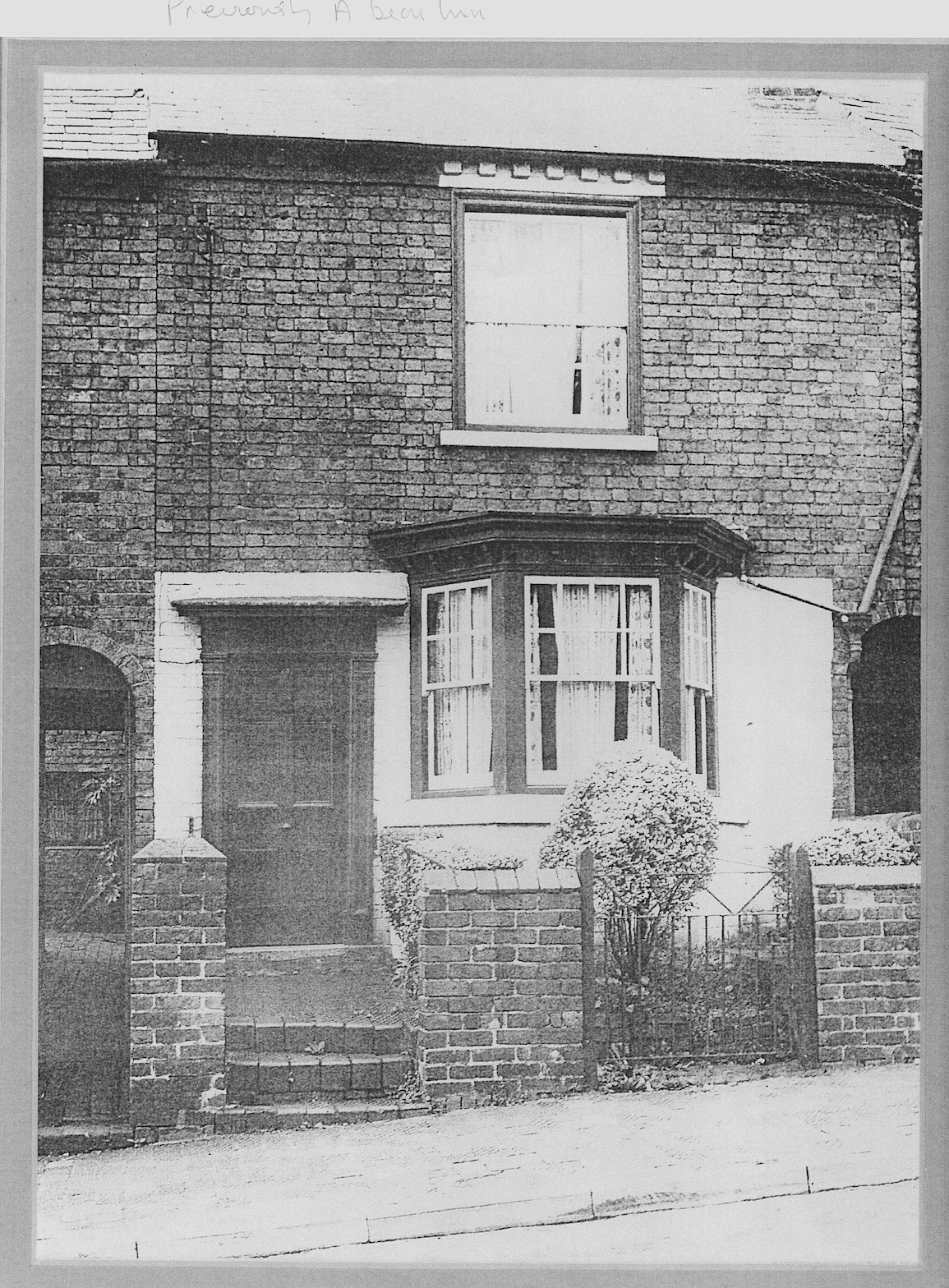
23 Bridgnorth Road
1920s
The Albion had been a public house from 1841 when the address was 23 Withy Bank and was one of the properties on what is now Bridgnorth Road, opposite Wollaston Village Hall, formerly Wollaston Senior Citizens Centre. On 31st January 1921 it ceased trading and became a private house. In 1975 the row of houses was demolished and a development of modern houses, standing well back from the road, was built.
.jpg)
Wollaston Garage
1930s
The garage was operated by Percy Smart of Kidderminster where two petrol hand pumps were used. The original garage went into liquidation in 1924 and the premises were bought by Eric Heynes. During the Great War he had served as a despatch rider and on his return to civilian life he became an engineer. He began trading as a vehicle repair shop and taxi service. For ten years he and his wife lived above the shop before moving to Wood Street. Eric took a roll in the community and served as a Stourbridge councillor from 1938. He served as an alderman, a magistrate and a governor of Wollaston Schools and was chairman of the Stourbridge & District Water Board between 1946 and 1958.
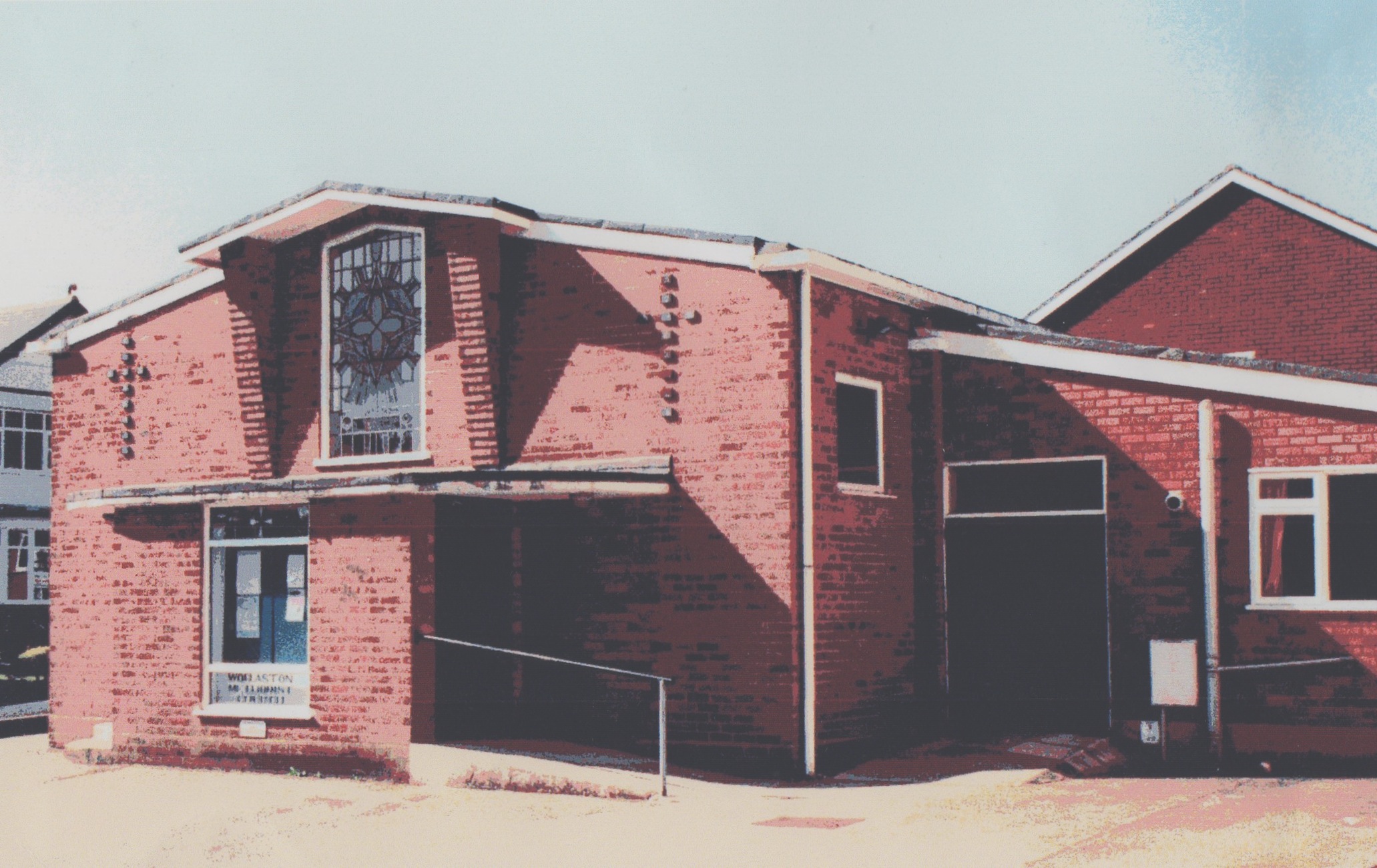
Wollaston Methodist Church
1960s
In 1960 a Trust Fund became available which enabled the trustees to demolish the original building, dating from 1891, and build a new one on the land. The original opening was onto Bright Street but the new one opened onto Cobden Street. Work began in 1960 and the opening service was held on 15th July 1961. A memorial window was set above the entrance porch and dedicated to the founders of the trust and inscribed:- “In affectionate memory of Frank Ingham and Kate Whitehouse Payne, who gave this house to the Glory of God.” The organ was dedicated on 10th September and the total cost was £7,500.
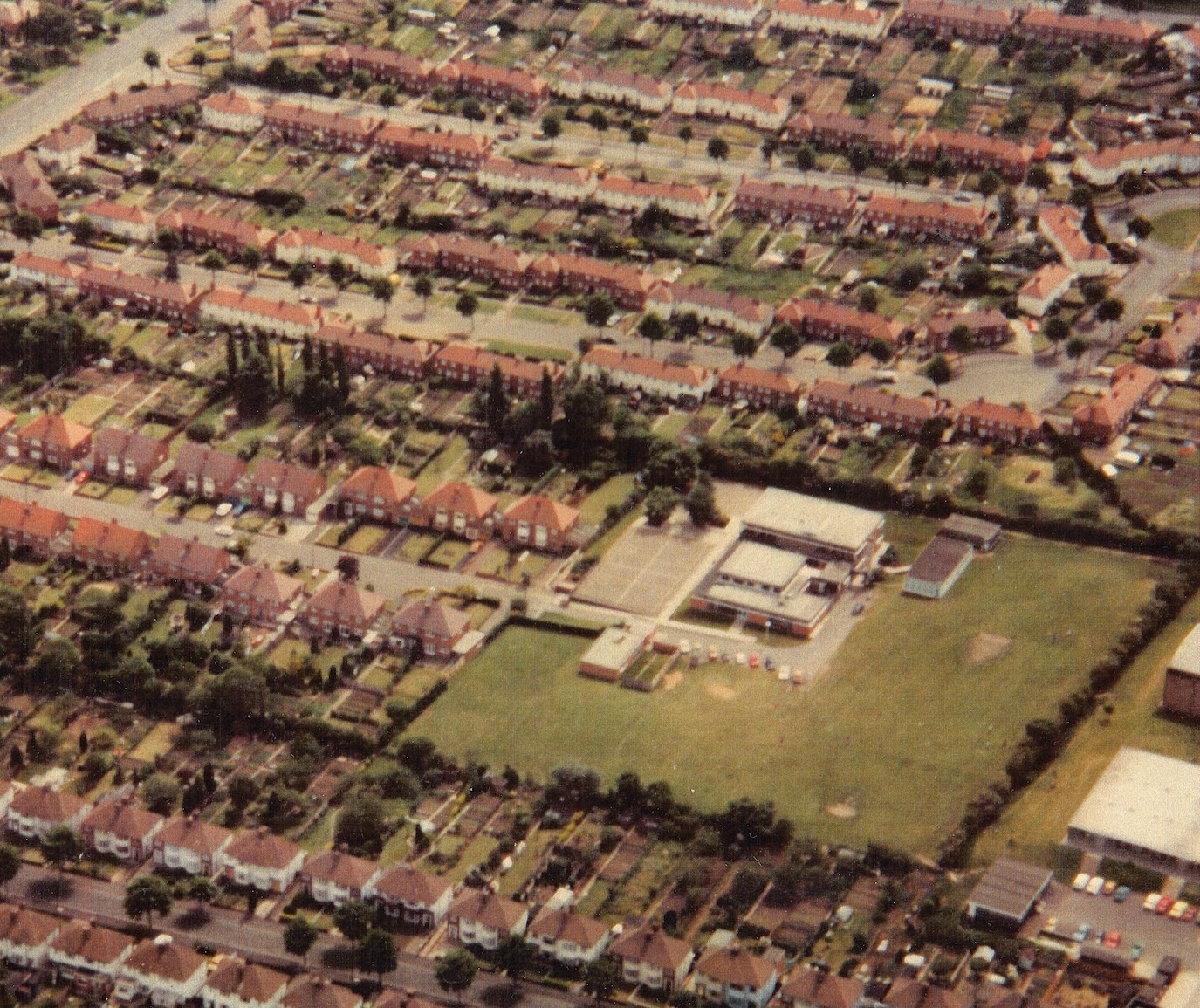
The Ridge Primary School
1960s
The Ridge Primary School was built in 1968 and provided education for children from 5 to 11. Prior to the opening the children from this area would have had to attend either Gig Mill or Meadow Park or the Junior School in the village. The building is at the top of Gregory Road and in the top left corner of the photo there is High Park Avenue and in the bottom right some of the buildings of what was then High Park Secondary School can be seen.
The first headteacher was Harold Hoyle who retired in 1975. He was succeeded by Mike Cruise who left in 1998. The next head was Grahame Robinson and when he left in 2003 Deb Hudson was appointed and is still in the post in 2012.
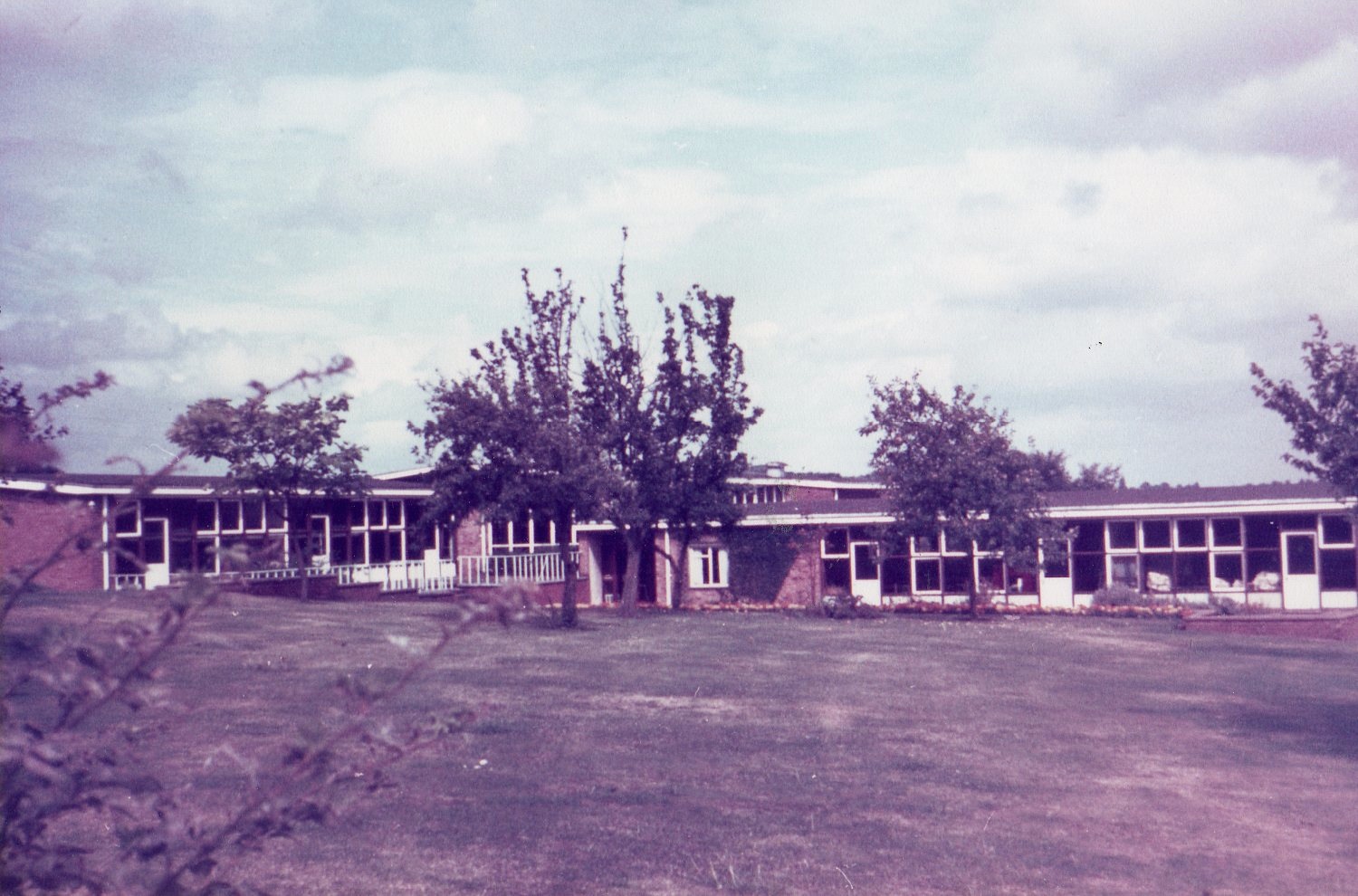
Meadow Park Infants’ School
1950s
The original school building next to St James’s Church was built for all children of school age. As the village grew it became obvious that the building was not adequate for the numbers. The older children, above the age of 11, left to attend secondary schools in September 1939. There was talk of building a new infants’ department on the ground the other side of the church but when Wollaston Farm Estate was built in the 1950s a site was chosen close to the homes where many families with young children would be living. The headmistress of the school, G Ruth Smith retired in 1959 and the first head of Meadow Park was Kathleen Corcoran who retired in 1980. Jeanette Stafford took over the post and remained head until 1984 when the junior school children moved to what was to become St James’s Church of England Primary School.
This photo shows the flat roof of the building which was replace with a pitched roof in the 1980s.
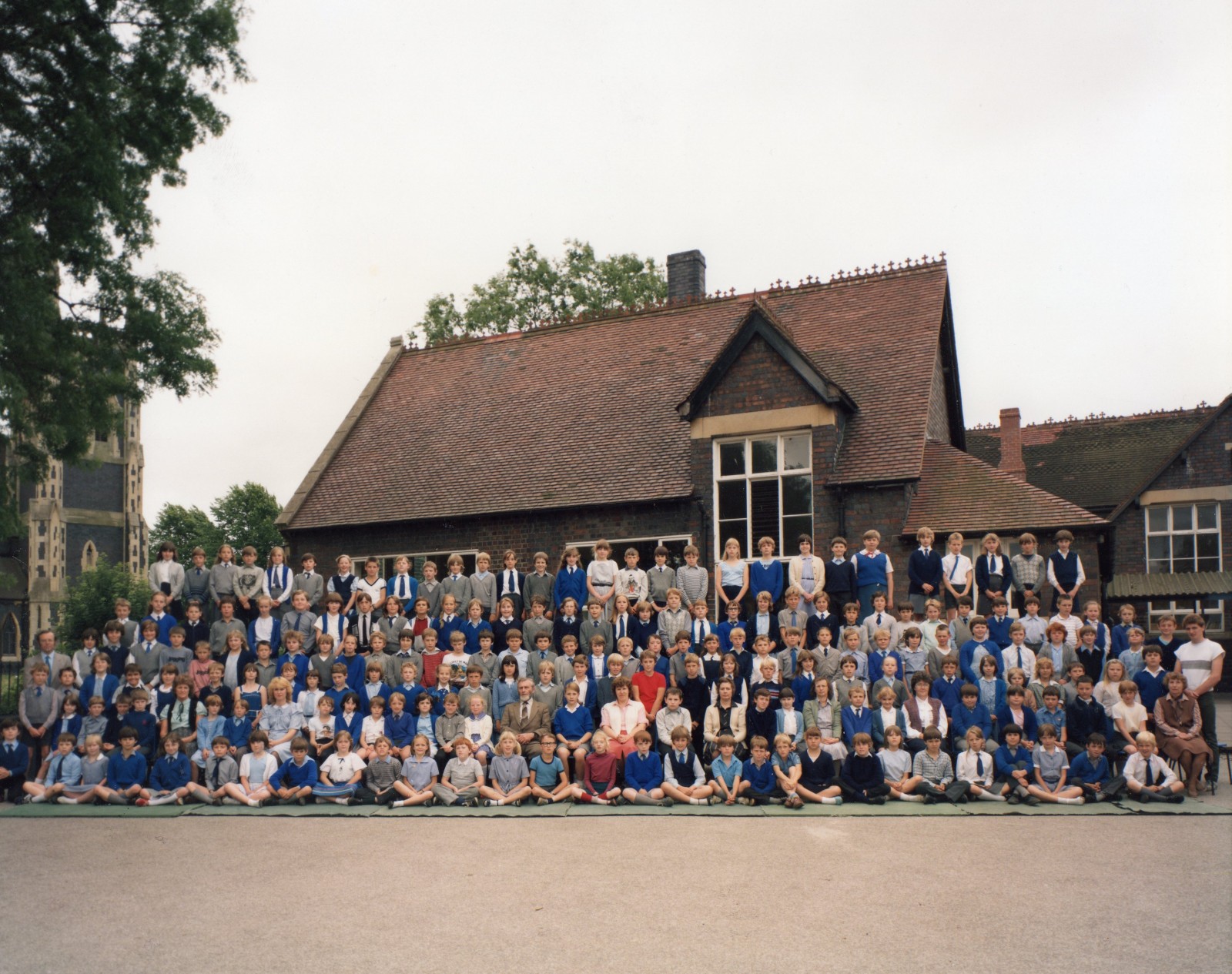
1984 - The Whole School
1980s
When the decision was made to close the original school building in the village the infants who were due to become juniors remained at the Meadow Park site. The additional buildings were not completed in time for a move of the rest of the older children and this photograph was taken in the playground of all the children still in the old school, together with the remaining teachers.
The photo was taken in front of the part of the building which had started life as the Infants’ School in 1859 and which was subsequently demolished to make way for Belfry Drive. This gave access to the housing development on what had been the school playing field, the proposed Church Hall and the retirement flats which were built on the old playground. St James’s C of E School became one in February 1985.
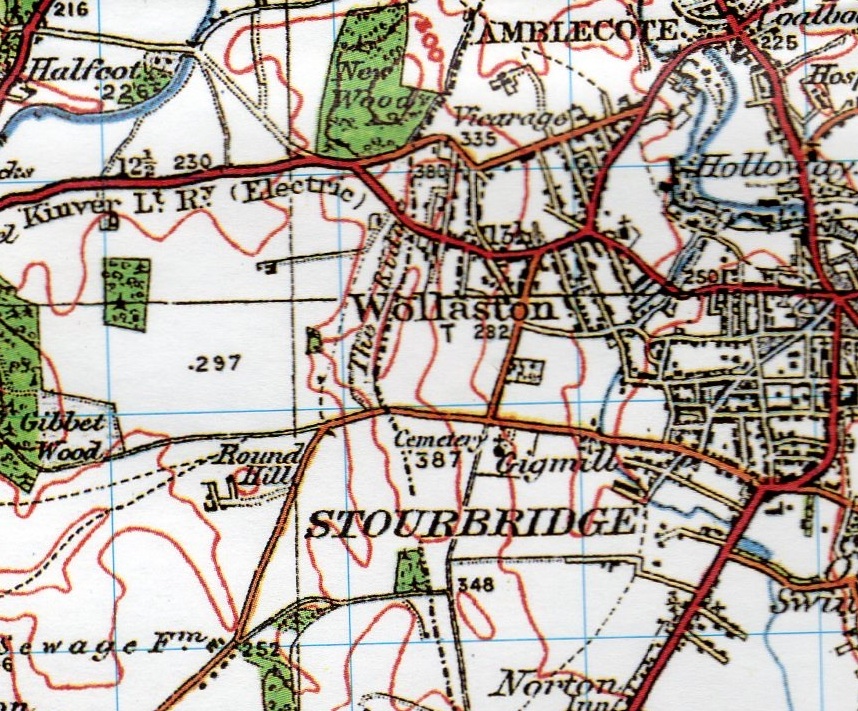
A map of Wollaston from 1921
1920s
The map shows the development of the village with many new roads constructed throughout the 19th century. The old turnpike road shown on the map of the 1830s is still the main route between Stourbridge and Bridgnorth and became the route for the Kinver Light Railway to Kinver in 1901. The site of Wollaston Hall is shown and it was still the home of Mary Roberts until her death in 1924.
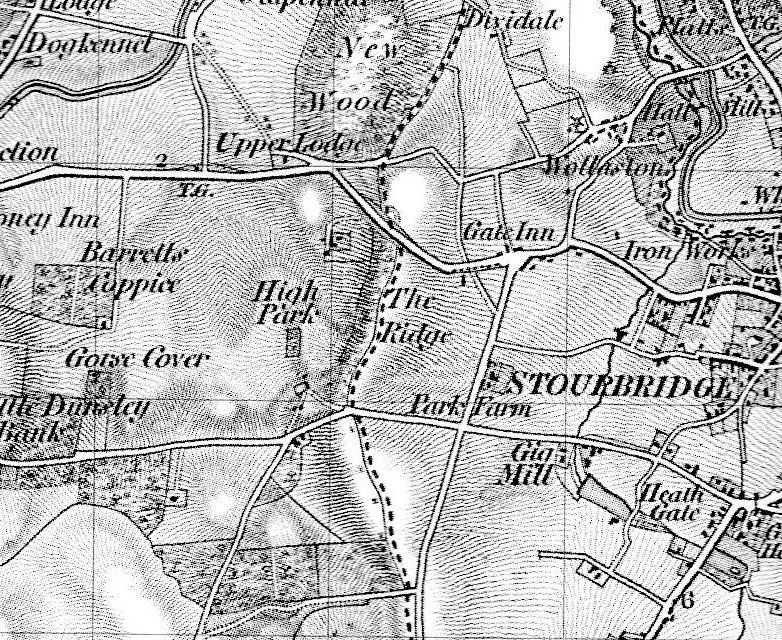
A map of Wollaston in the 1830s
1830s
This map, dating from the 1830s, shows the main roads including the turnpike road from Stourbridge to Bridgnorth. The Act which was for the making and maintaining the road was given Royal Assent on 11th April 1816. The main road through the village still follows the same route and the Gate Inn at the junction of what is now High Park Avenue was where payment would have been made to use the road. The public house at the junction is still called The Gate Hangs Well. What is now called Vicarage Road, renamed in the 1860s, has the symbol denoting the windmill where the Vicarage now stands. Wollaston Hall is also clearly marked as is the iron works which provided so much employment in Wollaston.
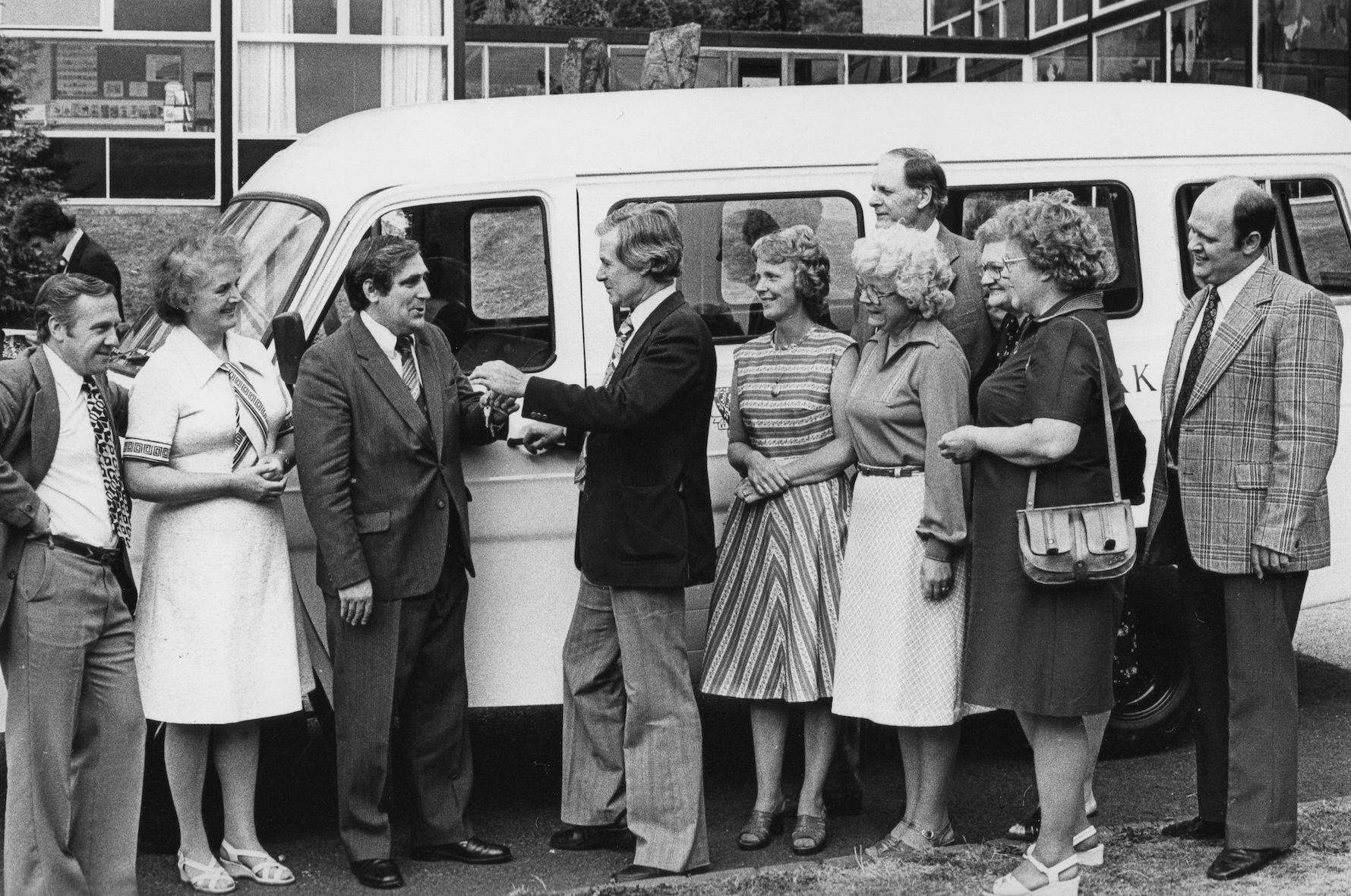
High Park School Mini bus
1970s
In July 1979 a new mini bus was presented to the school by the Parents’ Association. The photograph shows three members of staff, (from left to right) Gilly James, Mary Seaburn, deputy head and the head teacher, Ian Maddock, receiving the keys from Jeff Bishop, chair of the parents’ Association, with Janet Bishop standing next to him and members of the Committee.
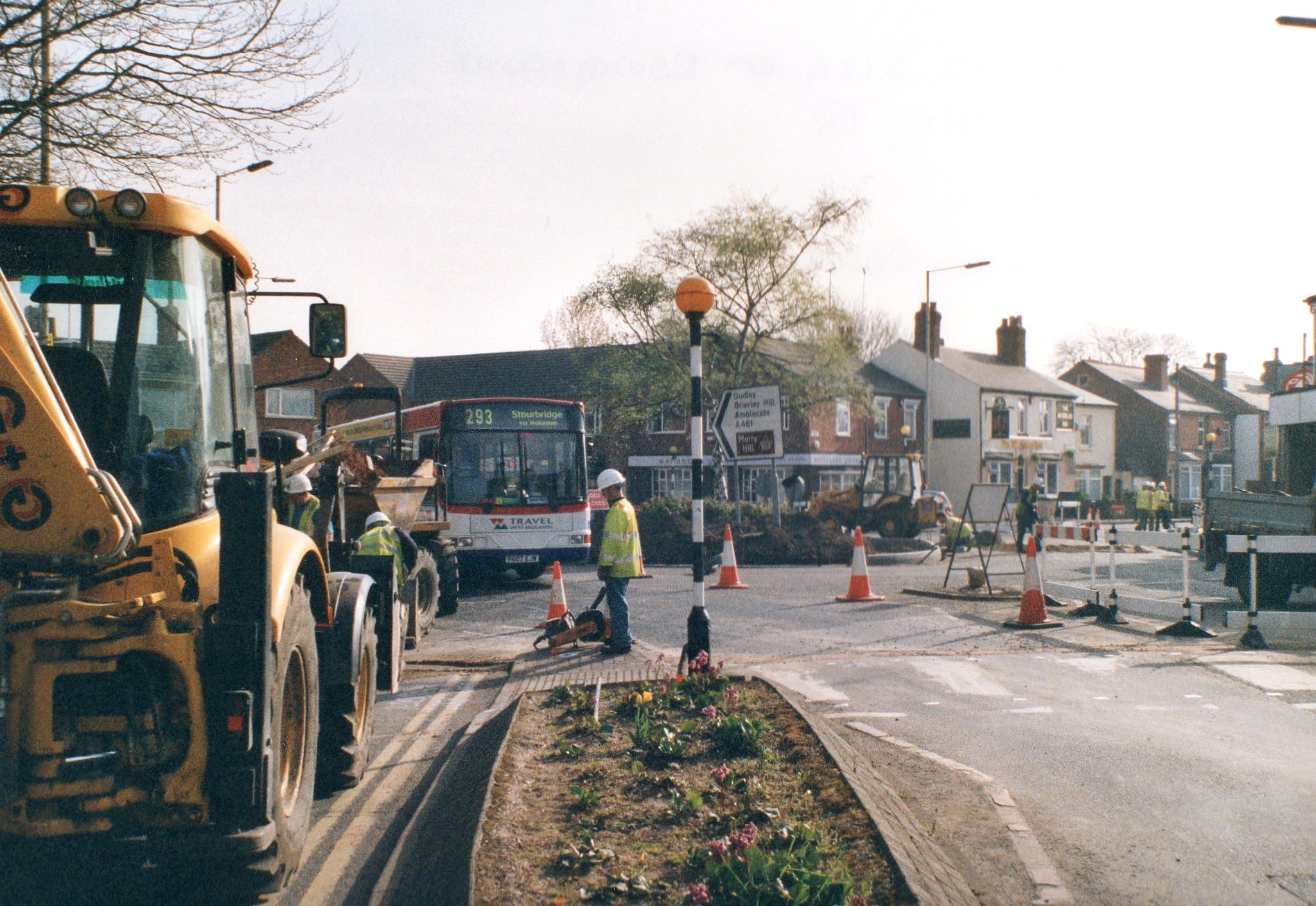
Roadworks at the traffic island
2000s
After the traffic island had been reduced in size the road was resurfaced. This meant that local traffic was diverted and the 293 bus to Stourbridge is negotiating the island from an unusual direction. The bus lay-by was out of action as the traffic from Stourton had been diverted down Vicarage Road.
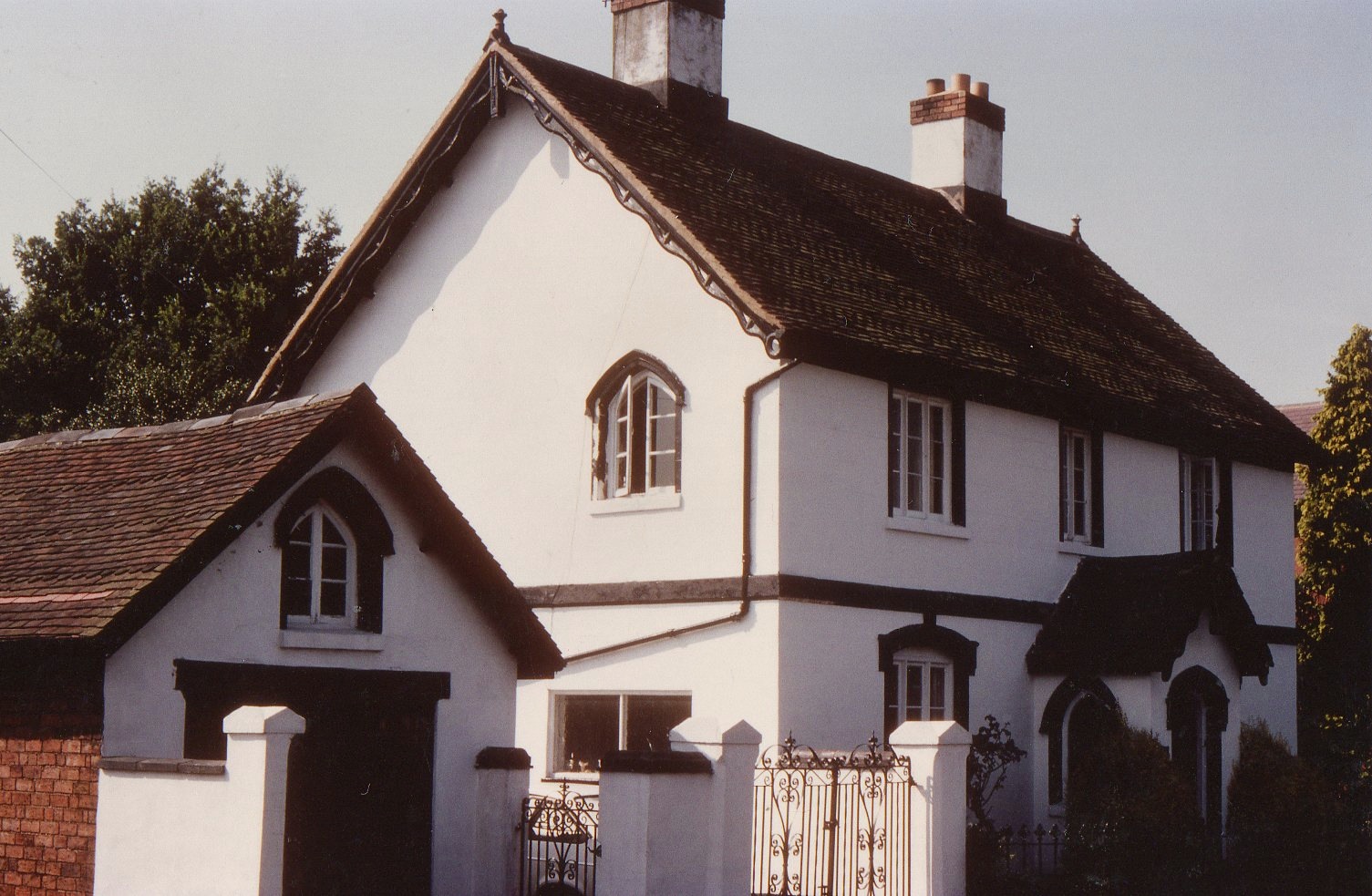
Elford House
1970s
This attractive house is in Bridle Road and when this photograph was taken in the 1970s the owners were a family called Noble. Pip Noble was a teacher at Wollaston Junior School. In a directory of 1940 the occupier was William Henry Whitehouse. The building in the forefront was used as a garage but in earlier times would probably have been a coach house. Previous occupants include a Mrs Robinson who lived there in the 1890s.
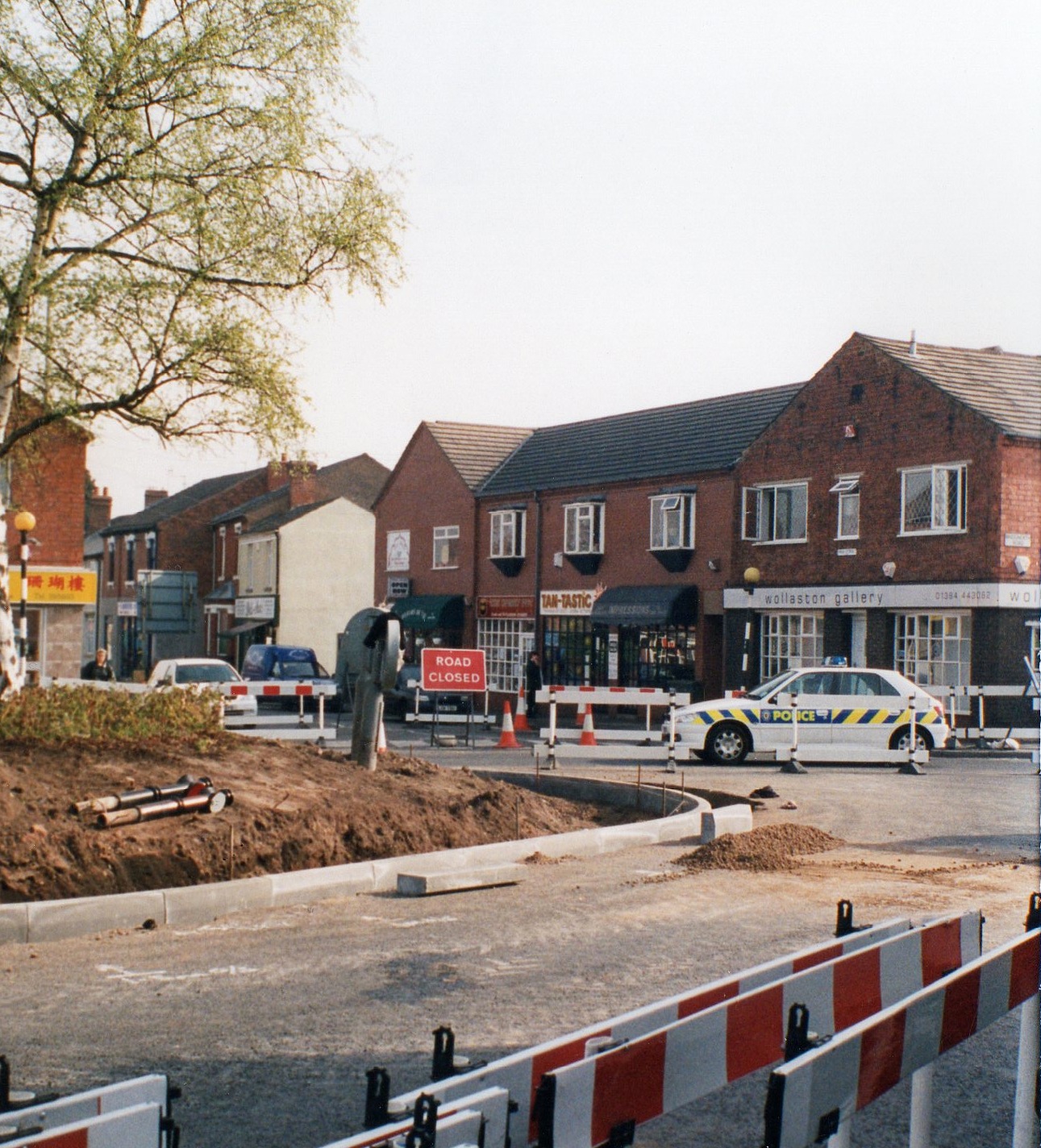
2003 roadworks
2000s
The traffic island at the junction of Bridgnorth Road and High Street was reduced in size in April 2003 prior to the road being resurfaced. On this occasion High Street was closed to traffic and a police car is just negotiating the turn. The row of shops replaced an earlier terrace of small houses although one remains just round the corner next to The Waterloo Inn.
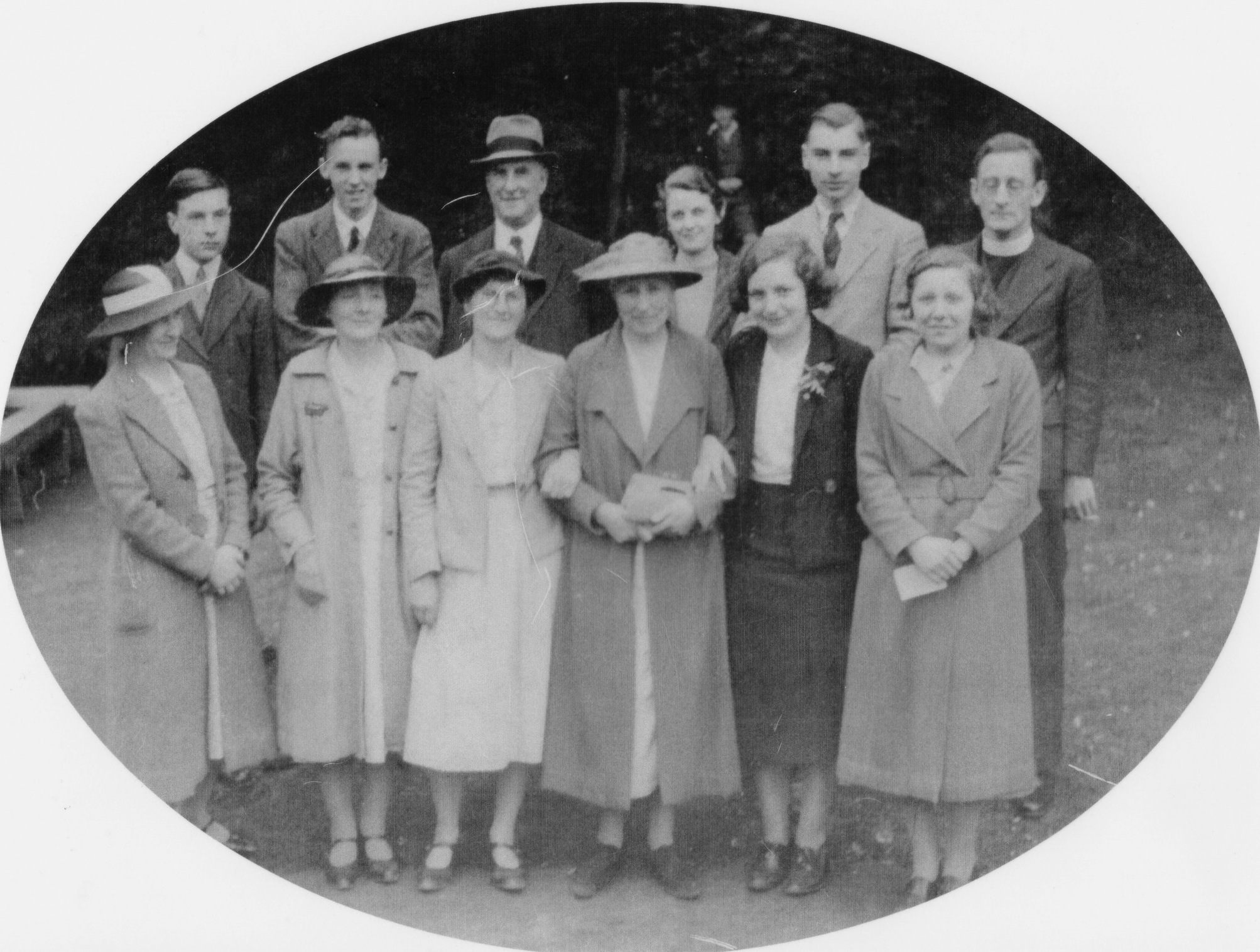
A group of parishioners of St James’s Church, 1939
1930s
This photograph was taken on 3rd August 1939 but the occasion is not known. The Vicar, Reg Bamber and his wife, fourth from the left, appear on it. Named people on the back row include: Dennis Willetts, Eric Brettle, Joe Pearson, (headmaster of the schools and churchwarden and Ralf Heaton.
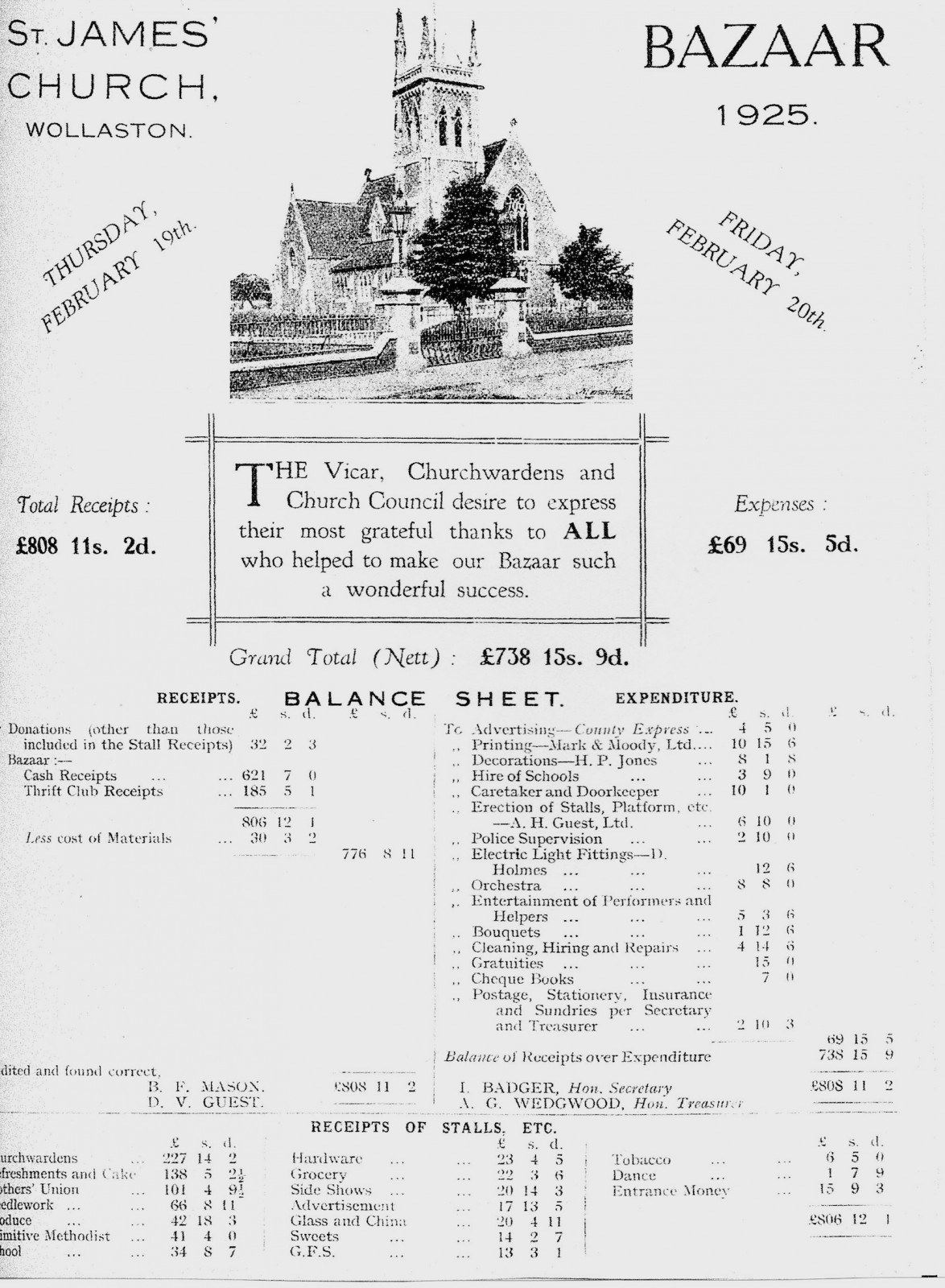
Church Bazaar 1925
1920s
There were many fund raising events held by St James’s Church when money was raised to improve the facilities at the church and for charity. The bazaar held in February 1925 was held to raise money to install electric lighting in the church and the work was completed at the end of 1924, before the bazaar was held. Fortunately the sum raised, £738 15s. 9d. was enough to pay for both the lighting and redecoration of the church.
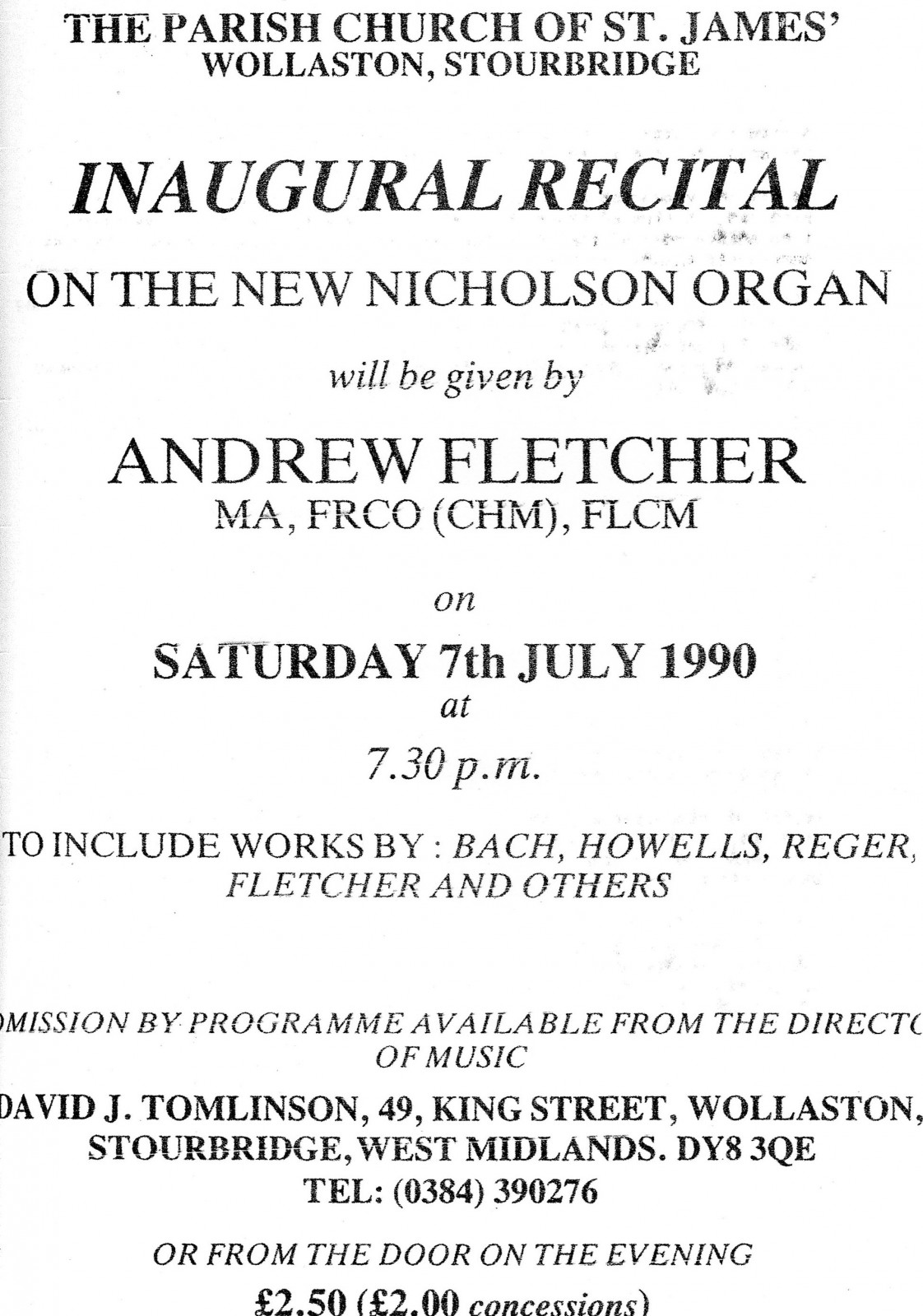
Recital on the new organ at St James’s Church
1990s
This advertisement for the concert appeared in the Parish Magazine in 1990. The organ had been completely refurbished and the concert was arranged by the church organist, David Tomlinson. The recital was given by Andrew Fletcher whose programme included music composed by him and took place on Saturday 7th July.
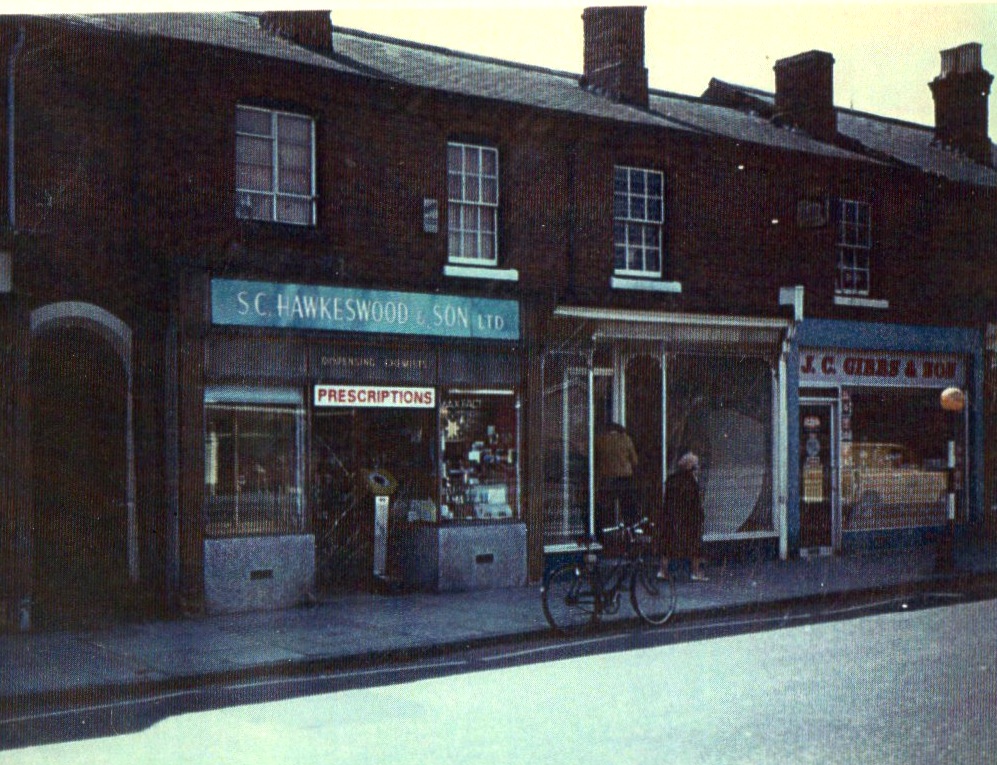
Hawkeswood’s enlarged shop
1970s
The local chemist’s shop belonged to Cecil Hawkeswood who opened his first business in 1928 in Bridgnorth Road. In the 1960s he was able to enlarge his premises when he bought the shop next door. This is a photograph of the new shop and next door but one to it is a small, independent grocery shop run by David Gibbs.
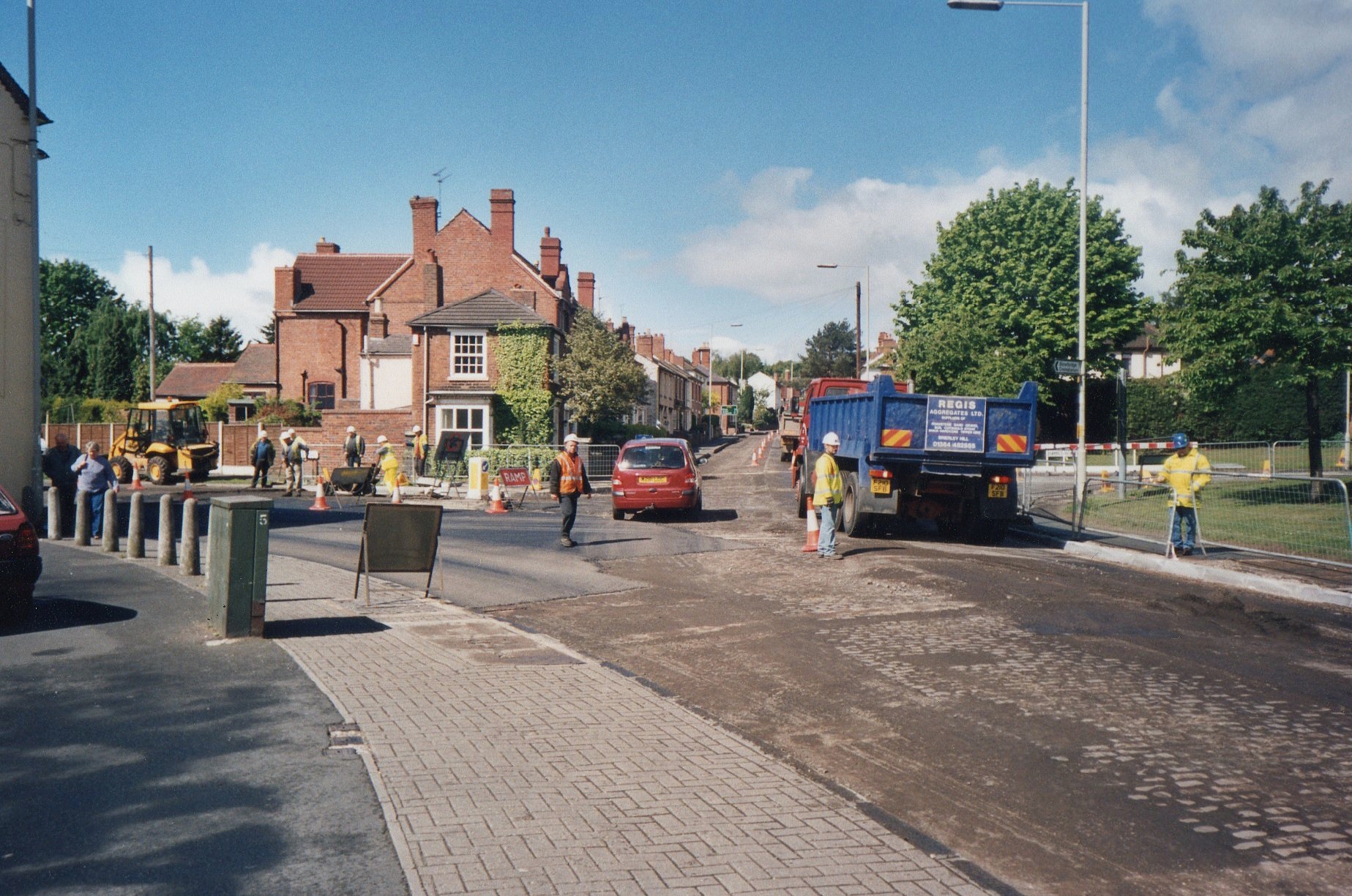
Road works - junction of High Park Avenue & Bridgnorth Road
2000s
Major roadworks took place in the village in May 2003. Traffic from Stourton to Stourbridge was diverted along Vicarage Road and the only traffic allowed was going towards the Ridge. It is clear that the cobbles which formed the base of the original road were still beneath the tarmac surface. The contractors for Dudley M.B.C. were Wrekin Construction from Telford. The house in the centre of the picture, on the corner of High Park Avenue and Bridgnorth Road, looks as though it was originally a toll house.
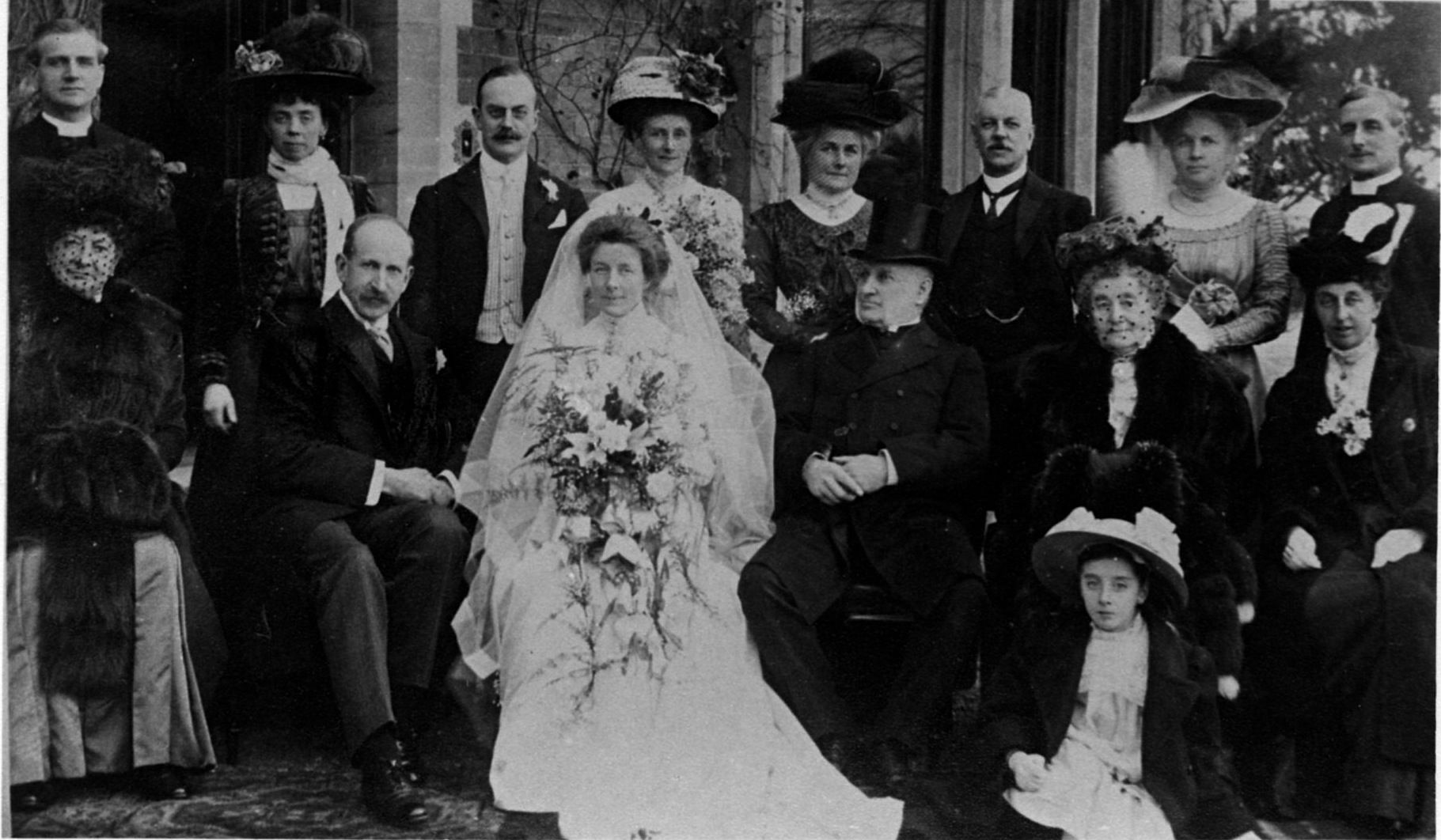
The wedding of Mabel Gilbanks
1910s
Rebecca F.M. Gilbanks, always known by her third name - Mabel, was married at St James’s Church on 27th January 1910. Her husband was William Robinson and seen in this wedding photograph are the bride and groom with George Gilbanks sitting next to his daughter. Both his sons are standing , George Ernest far left and William Foster far right. The girl seated in front was possibly William’s daughter and behind the bride stands one of her sisters, possibly Catherine Spurgin, known as Katie. Mabel was well known as one of the first lady bellringers in Worcestershire and a special peal was rung in honour of this occasion.
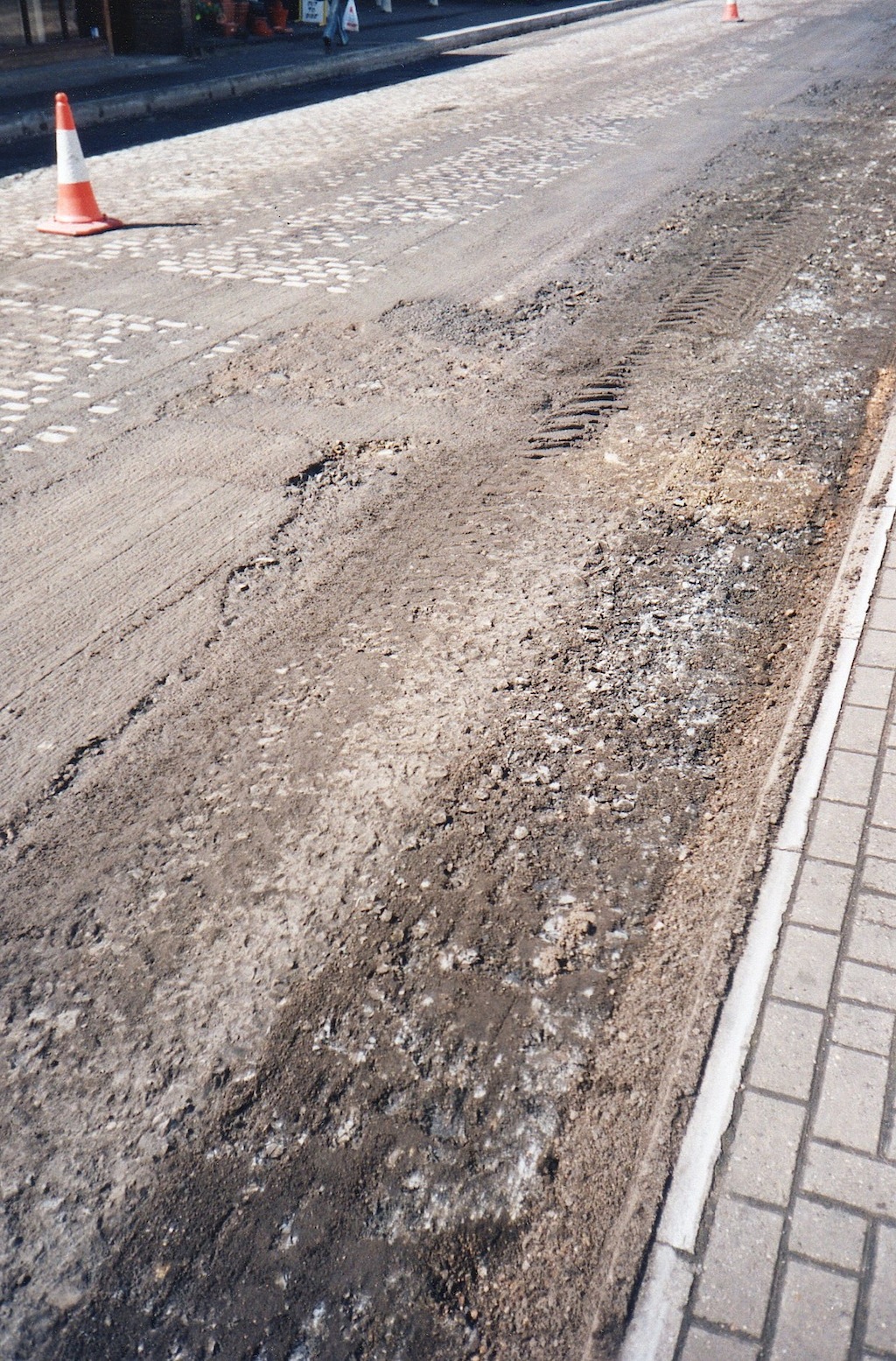
Roadworks in 2003
2000s
The earlier road was cobbled and when the roadworks took place in 2003 in Bridgnorth Road they were uncovered. It was also possible to see where the tram lines had been laid for the Kinver Light Railway.
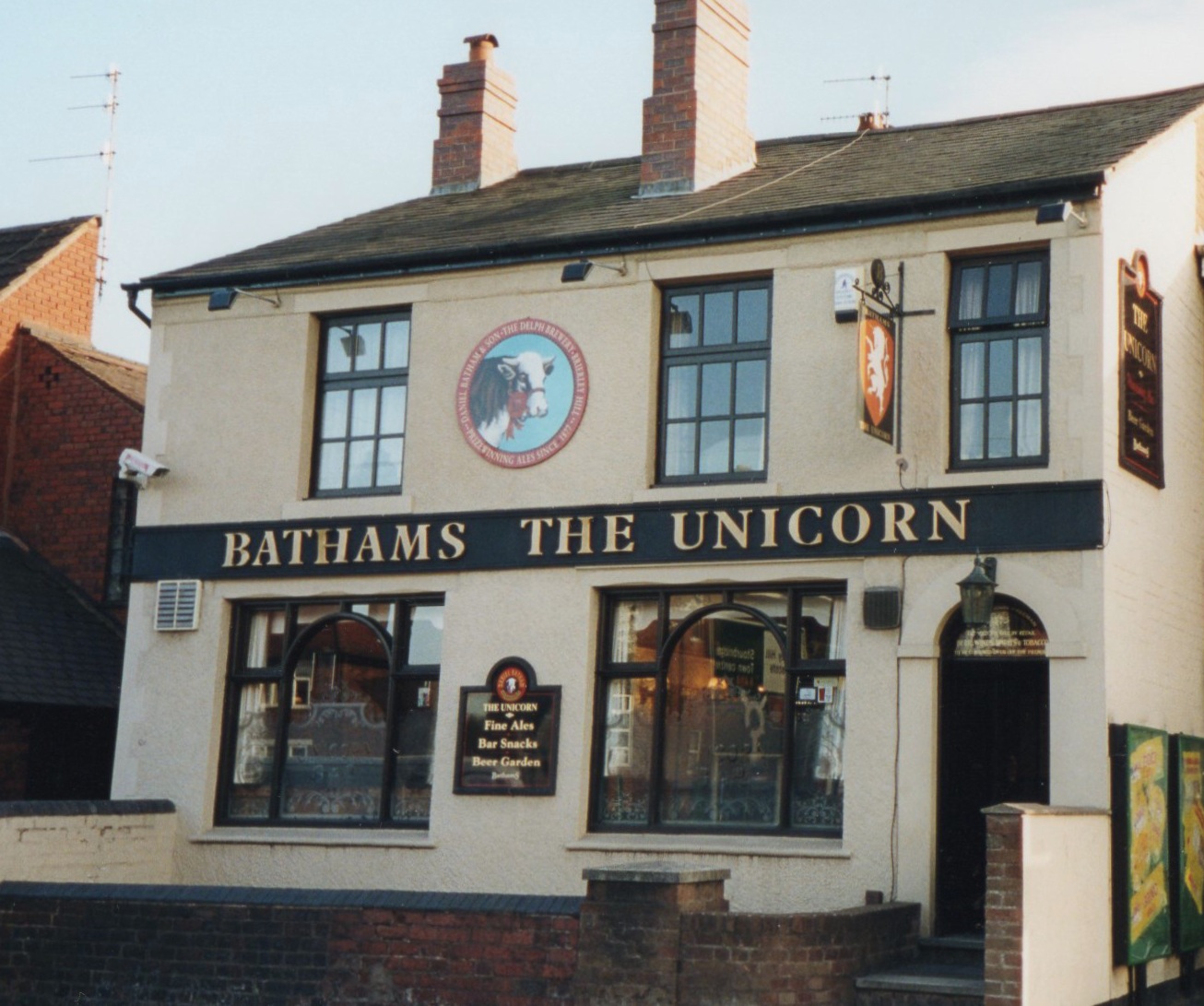
The Unicorn Inn
2000s
In an earlier photograph of The Unicorn it showed the brewhouse to the left of the building and a horse and cart in front. The original building had only two upper storey widows and this more recent picture shows the extension which was built in 1990s. The property is 145 Bridgnorth Road and it was named in a directory of 1865. A beer house, consisting of one room is mentioned after 1861 and beer was brewed there until 1963. The Billingham family took over the license in 1912 and successive members of the family kept The Unicorn until the death of Eric Billingham in 1992.
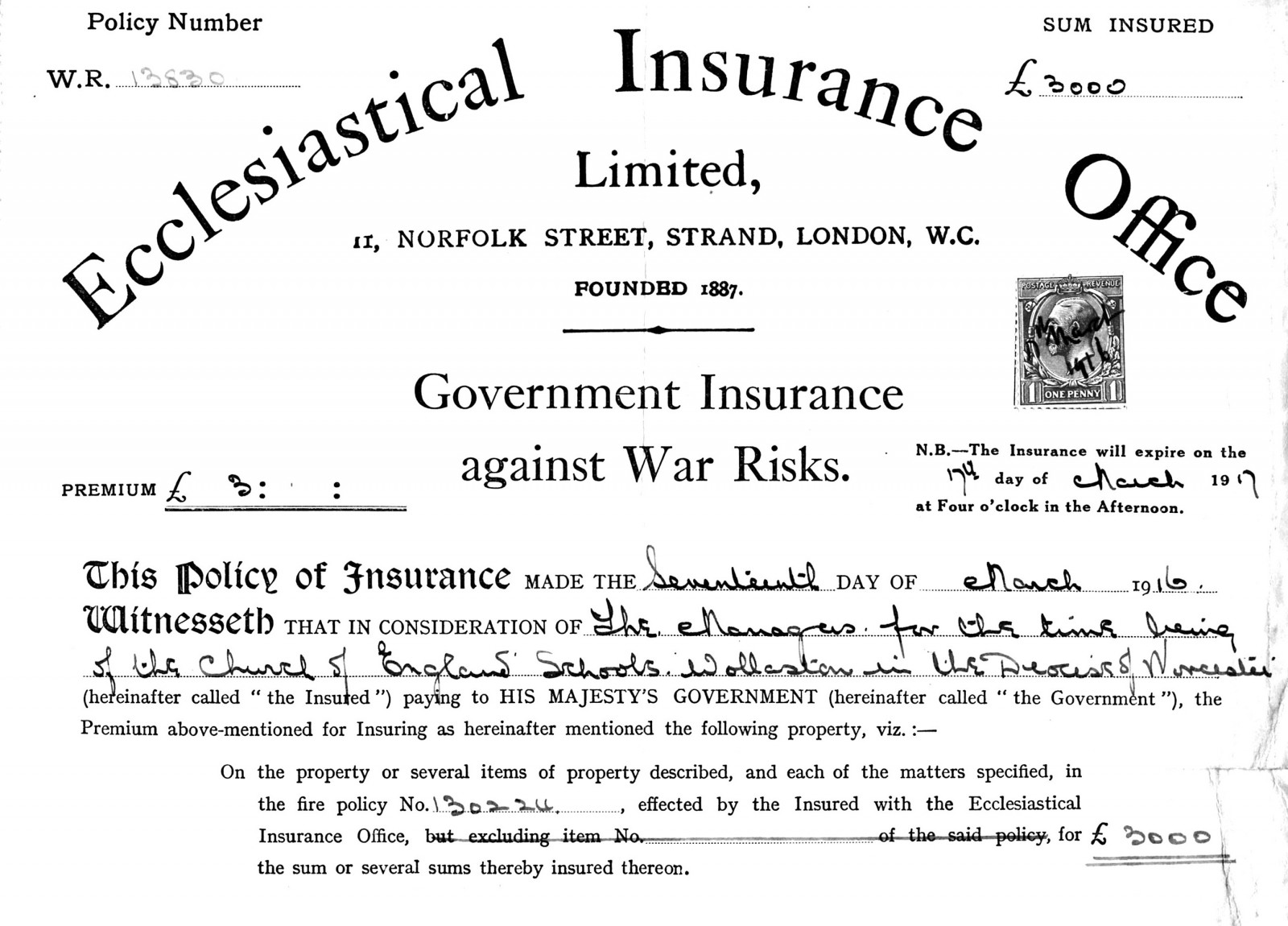
Insurance was taken out in 1917
1910s
An Insurance Policy, dated 17th March 1917, was taken out by the Managers of the Wollaston Schools against the school or any part of it: ” being destroyed or damaged by aerial craft (hostile or otherwise) or Shots, Shells, Bombs or Missiles.” This cost £3:0s:0d and the sum insured was £3,000.
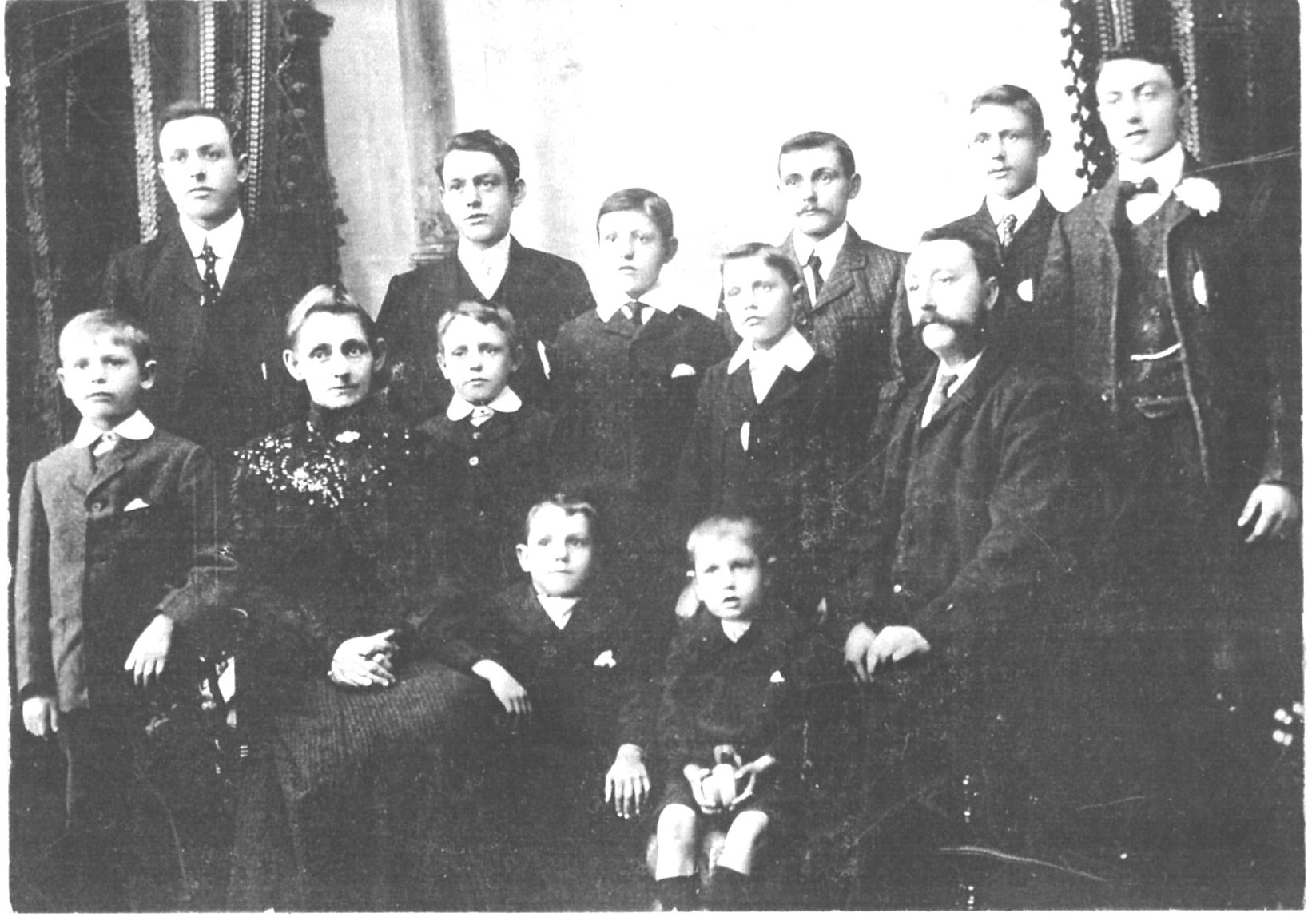
The Jenkins Family.
1900s
One of the largest families in Wollaston was the Jenkins family who came to Wollaston from Dennis Park in about 1895. The father John, was a glass engraver who was born in Brierley Hill. Of their 11 sons, two - Joseph and Edward - were twins, and seven of them were pupils at Wollaston Infants’ and Boys’ Schools. In 1915 all but one of them enlisted in the armed forces and two of them, Fred and Joseph, were killed in the Great War. They lived in Vicarage Road and in the electoral roll of 1925 John and his wife, Ann, were living at 4 Vicarage Road with two of their sons and another son, Frank and his wife lived at 19 Vicarage Road.
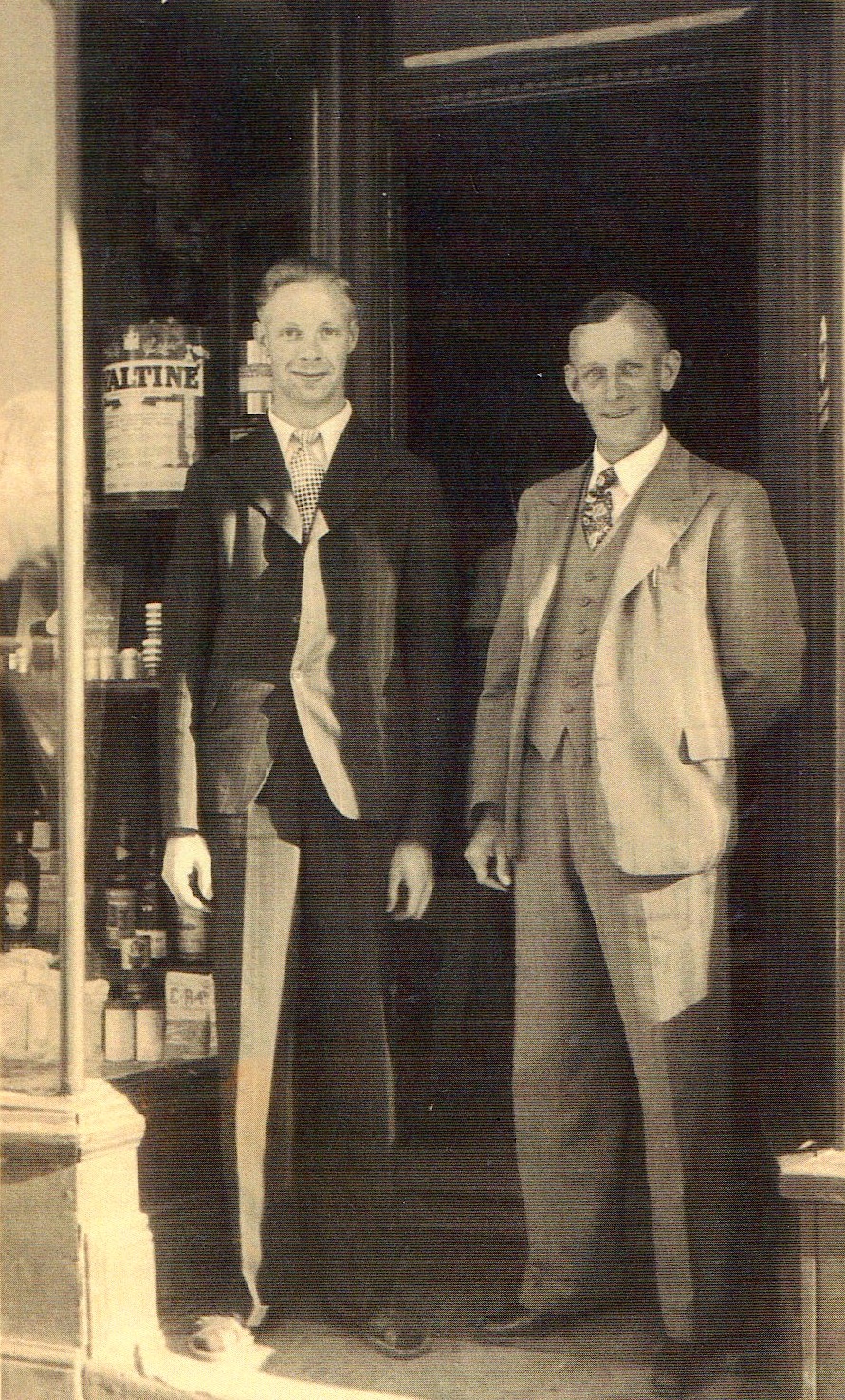
Cecil & Bob Hawkeswood
1950s
Cecil Hawkeswood, seen here on the right, came from Quarry Bank and qualified as a pharmacist in 1921. He came to Wollaston in 1928 and opened his shop in Bridgnorth Road. He eventually built up a chain of six chemist’s shops in Stourbridge. He and his family lived over the premises until 1938 when they moved into a house at the bottom of Meriden Avenue, almost opposite the shop. In the 1960s he bought the premises next door and the enlarged shop and his first one can both be seen on this site. In this photograph he is seen with his son, Bob, who carried on the business after his father’s death in 1984. He retired in 1988.
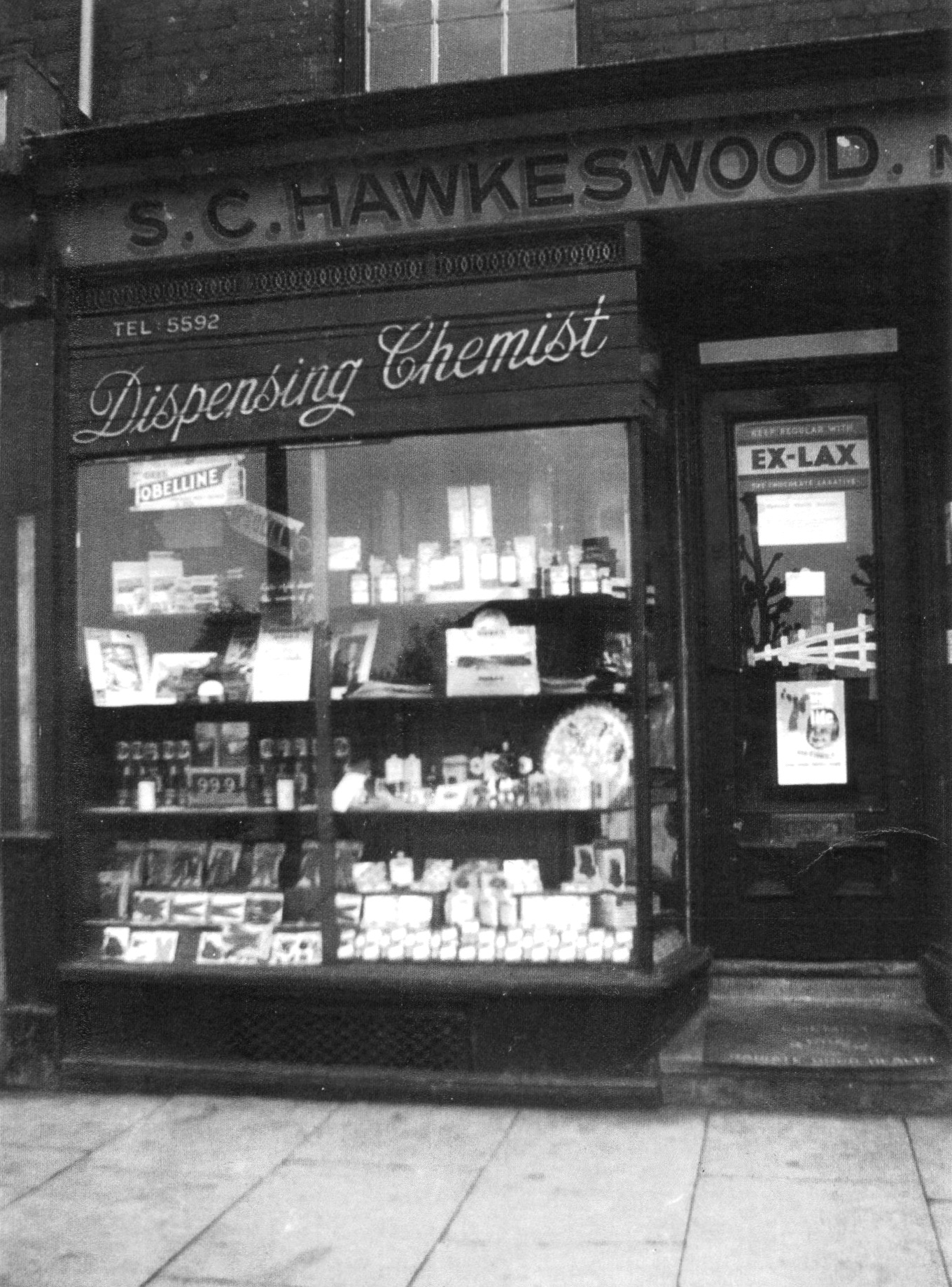
Hawkeswood’s Chemist’s Shop
1950s
Cecil Hawkeswood lived in a house at the bottom of Meriden Avenue opposite his shop in Bridgnorth Road. He and his son had six branches, one in Market Street in Stourbridge, and his shops provided a service or 50 years.
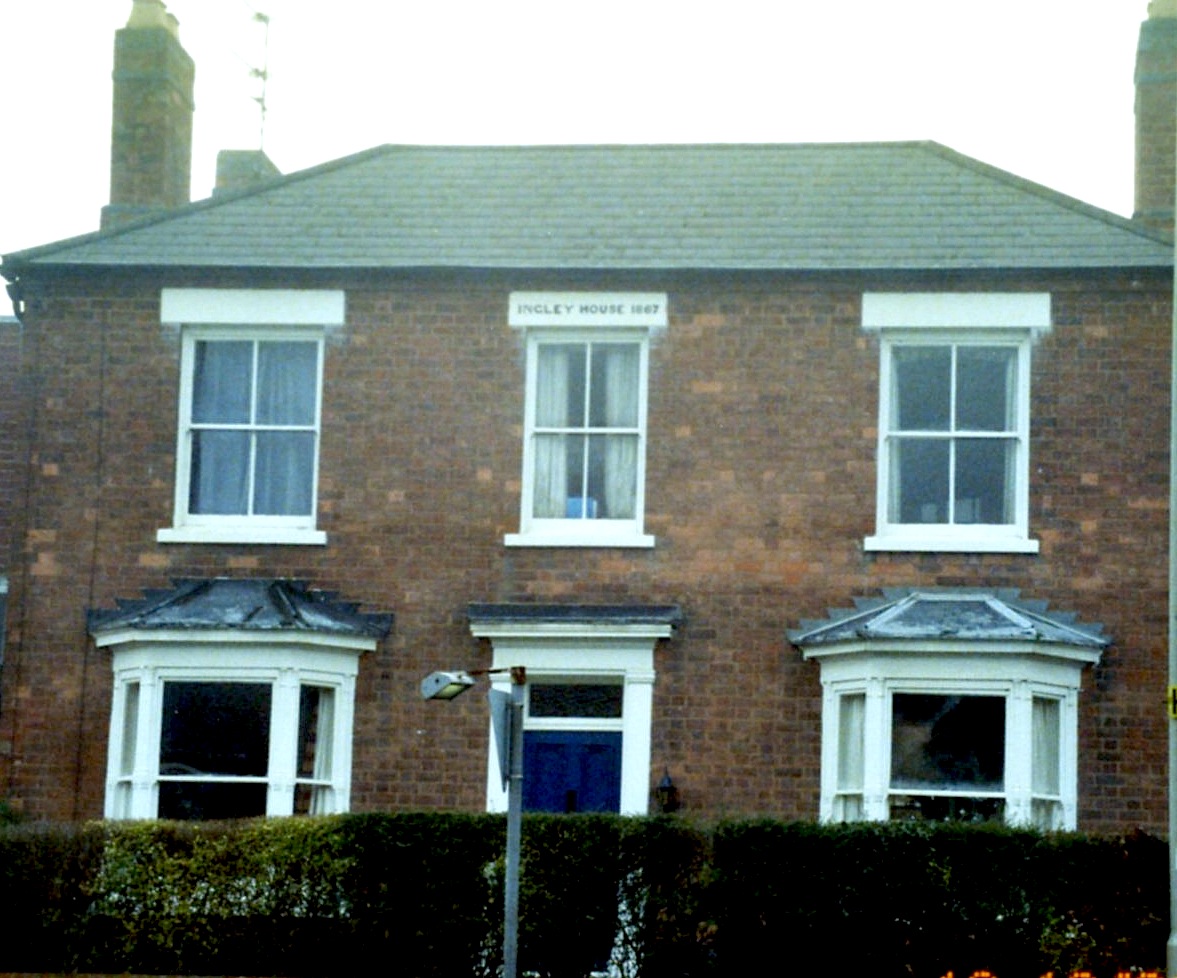
Ingley House
1970s
Ingley House is interesting because it has the date, 1867, and name above the upstairs window. One of the first families living there had the surname Ingley. In the 1890s a Mrs Malpass lived there.
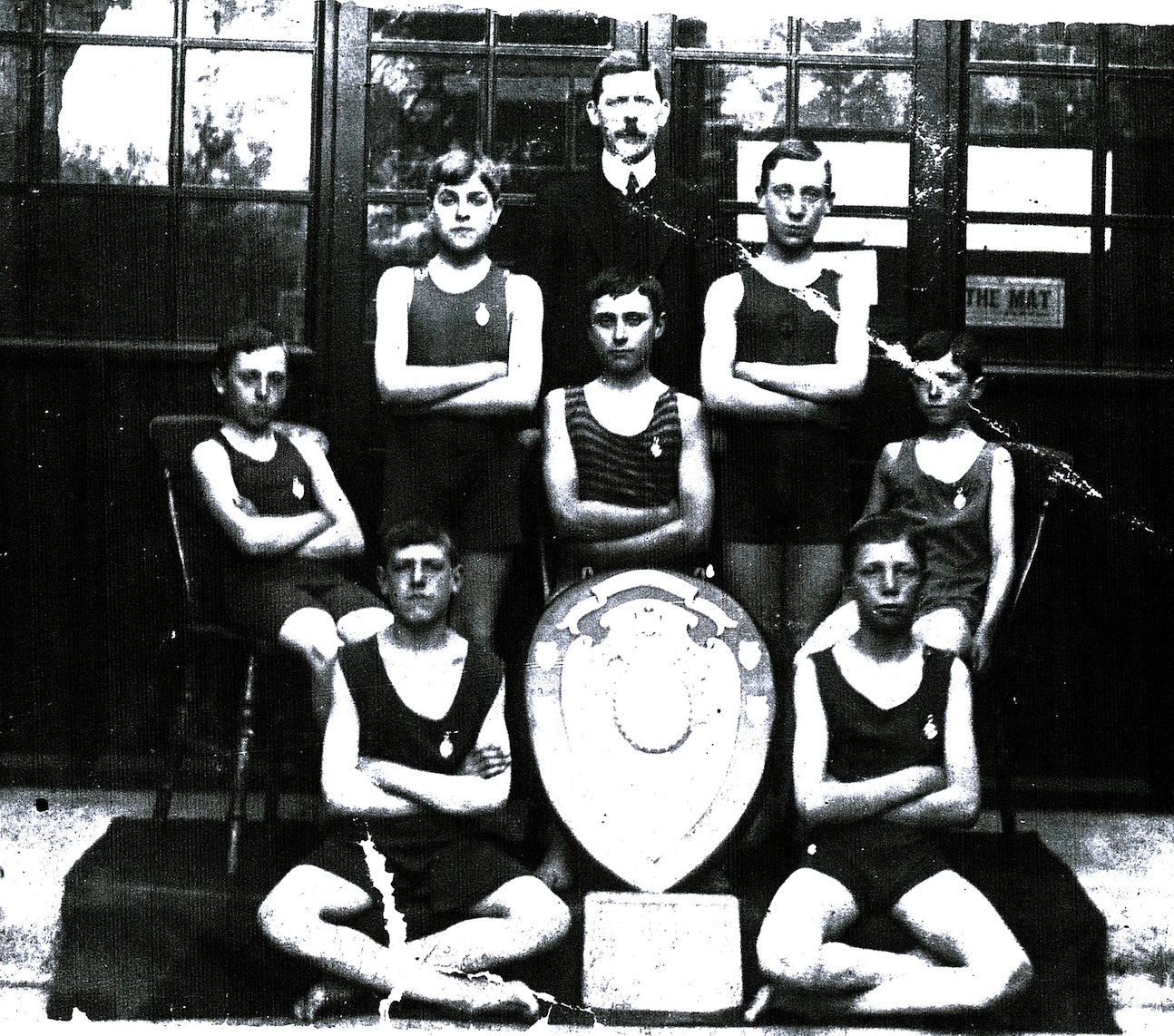
Boys’ School swimming team 1912
1910s
This is a photograph of the successful swimming team from the Boys’ School in 1912. Local schools took part in regular competitions called the Flying Squadron Swimming Competition. Here the boys in the team are shown with the trophy and the headmaster, George Whitmore stands behind them. Among the boys named were Percy Jones, Harry Noke, Percy Richards, Victor Pratt and Keith Palfrey. On 21st June the headmaster wrote in the log-book: “The team was again successful beating St John’s School. This makes the third successive win.” The shield was brought into the school on 11th October.
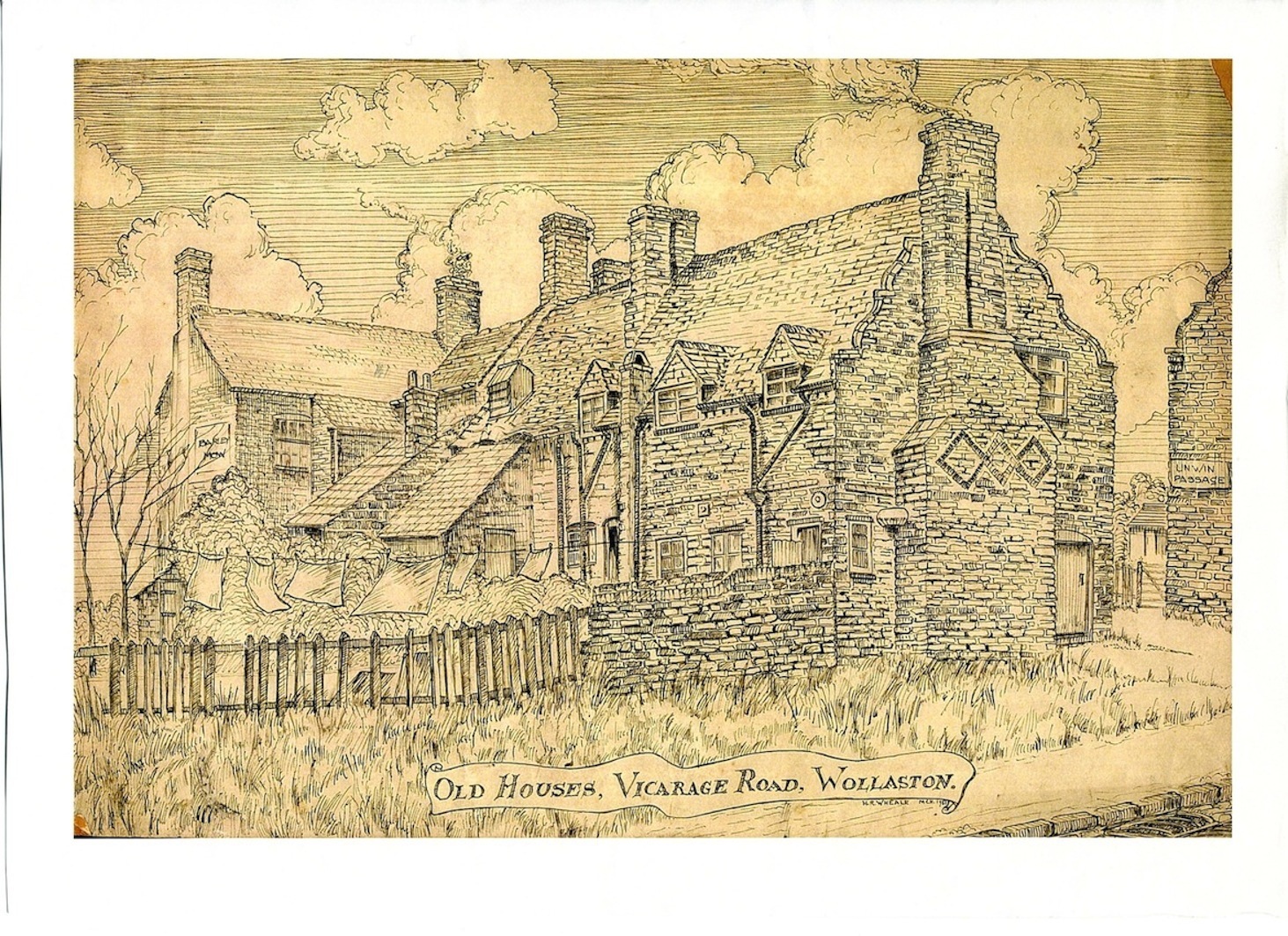
Houses in Vicarage Road
1920s
A drawing of houses in Vicarage Road shows the backs of the row.
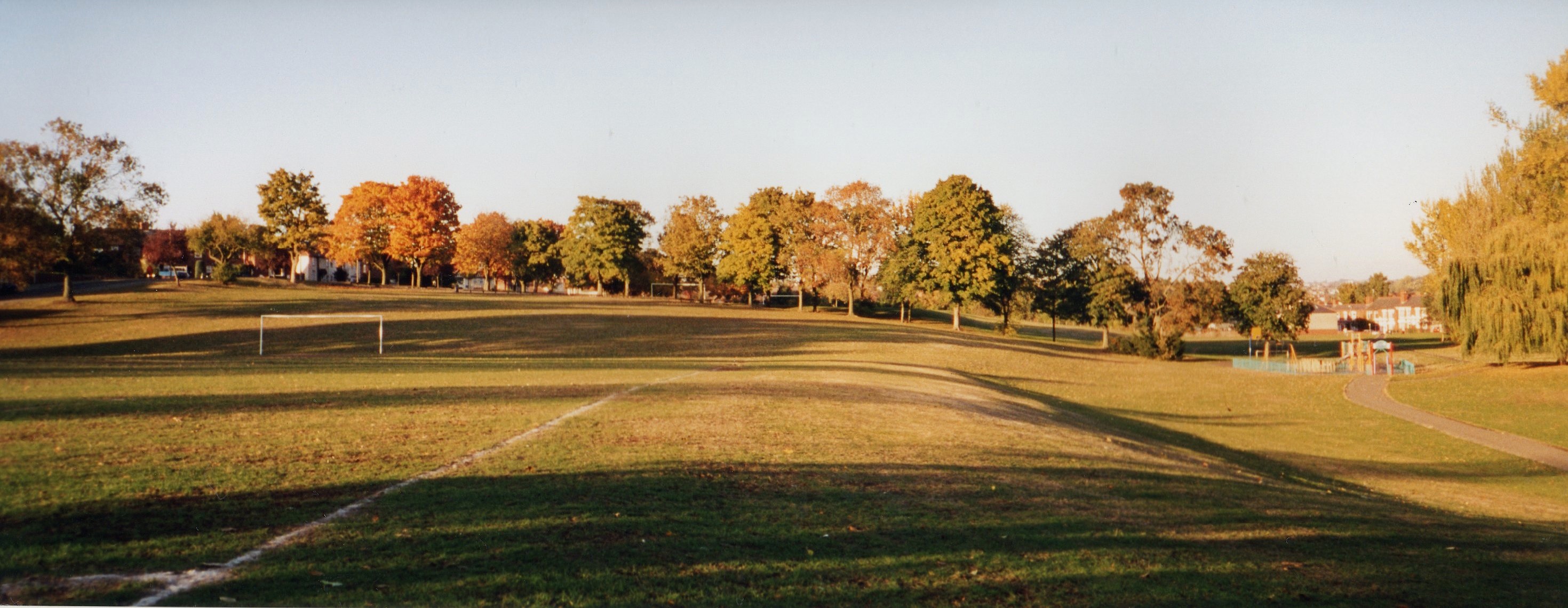
Swan Pool Park
2000s
Although there is no longer a pool in the park, its name is still used. When the pool was filled in a playground for young children was built and now contains climbing frames. There are football pitches in the park which are used regularly at week ends for matches.
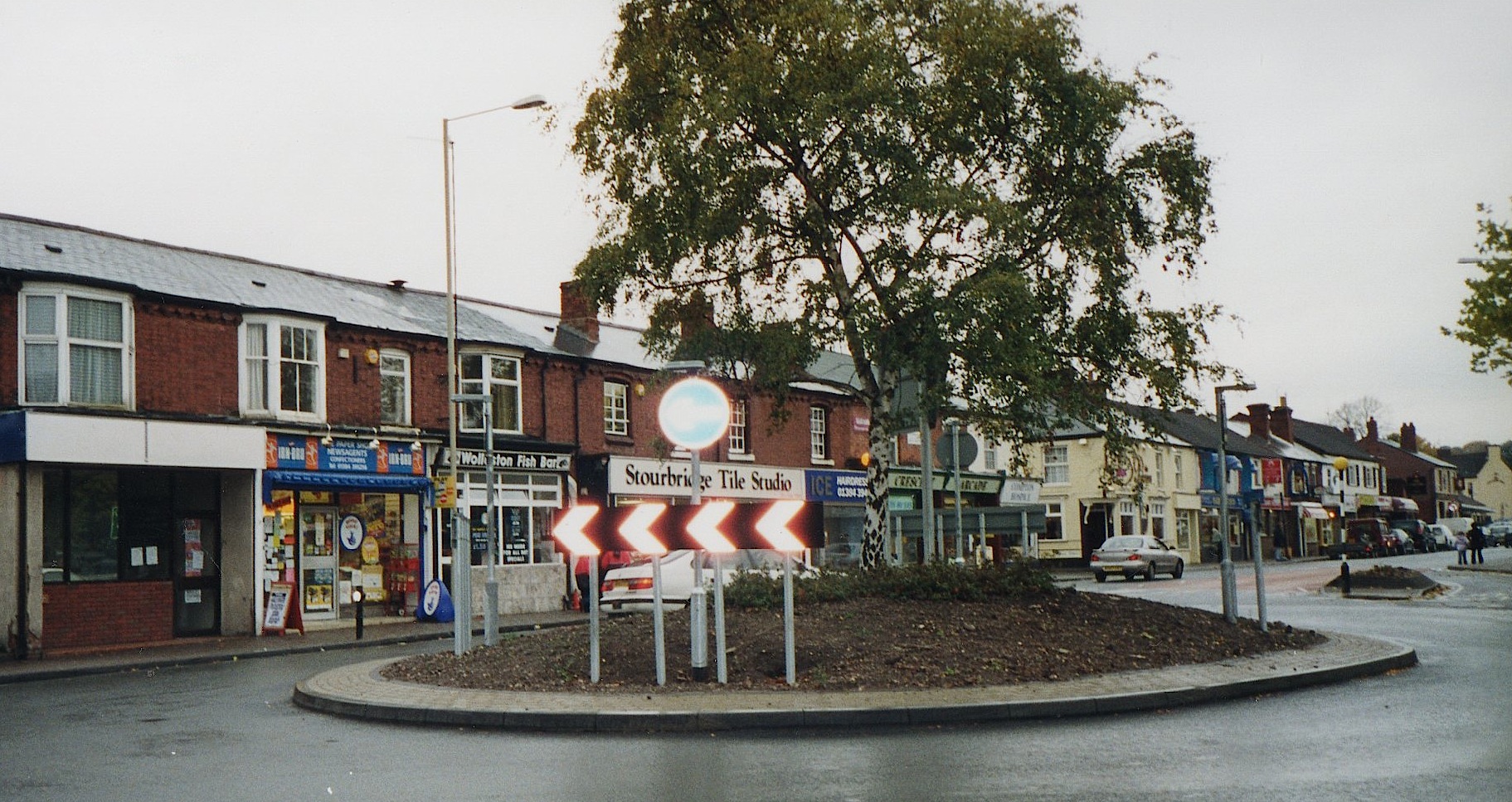
The junction of Bridgnorth Road and High Street
2000s
The traffic island stands at the junction of Bridgnorth Road and High Street. In the row of shops the Stourbridge Tile Studio has gone and the premises now house a charity shop belonging to Mary Stevens Hospice.
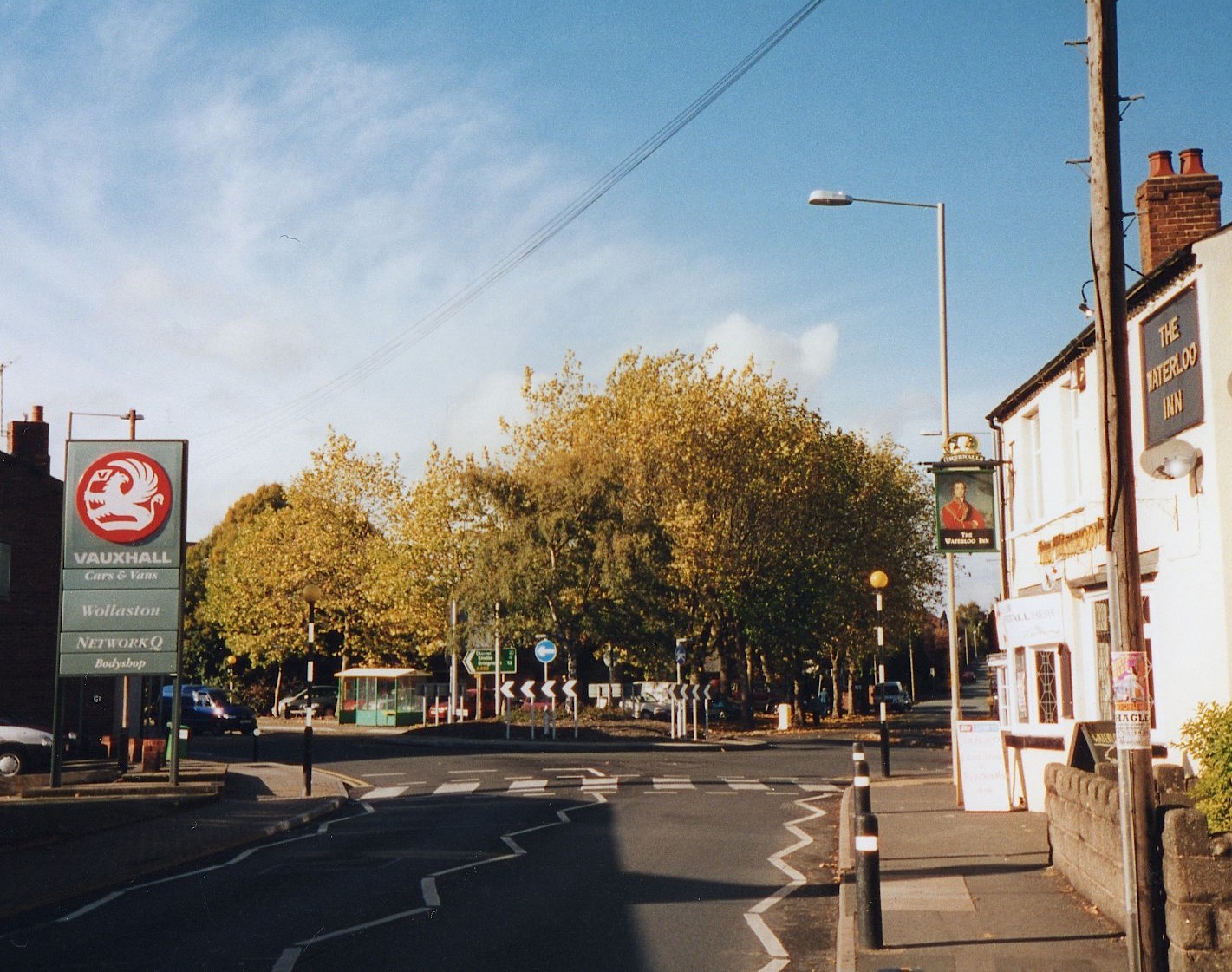
The traffic island and Bridgnorth Road.
2000s
This photograph taken in 2003 shows the sign in front of Wollaston Garage on the left indicating the make of cars which they sold. On the left is The Waterloo Inn with the sign showing the Duke of Wellington hanging outside. Unfortunately when the public house closed and the premises became an Indian restaurant the sign was lost. The traffic island is the junction between Bridgnorth Road, High Street and Meriden Avenue.
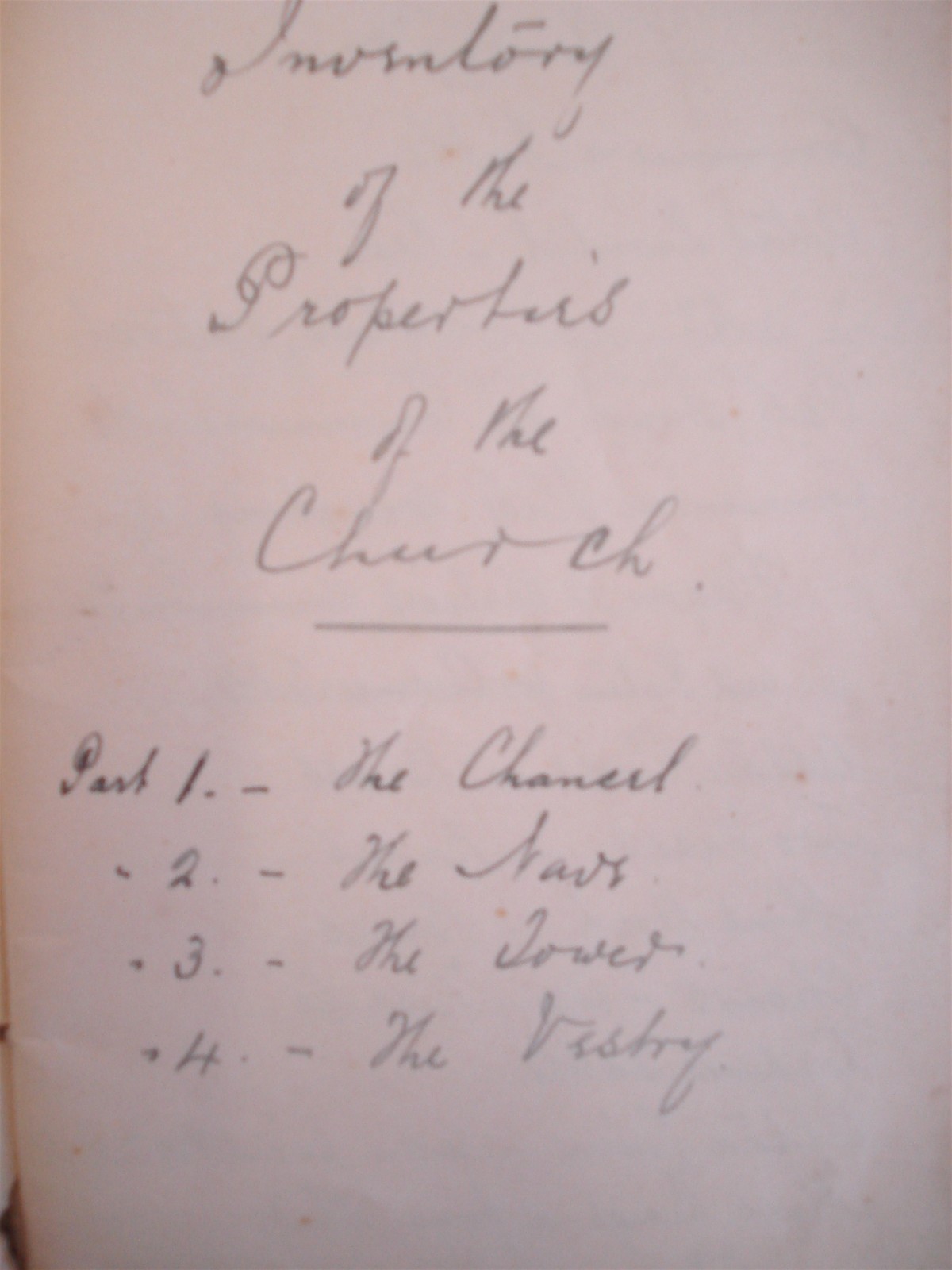
An Inventory at St James’s Church
1910s
Dudley Archives holds some documents belonging to St James’s Church. Among them is a detailed list of the furniture and other items connected with the services and church activities. This photograph is of the cover of the document titled ‘Inventory of the Properties of the Church’.
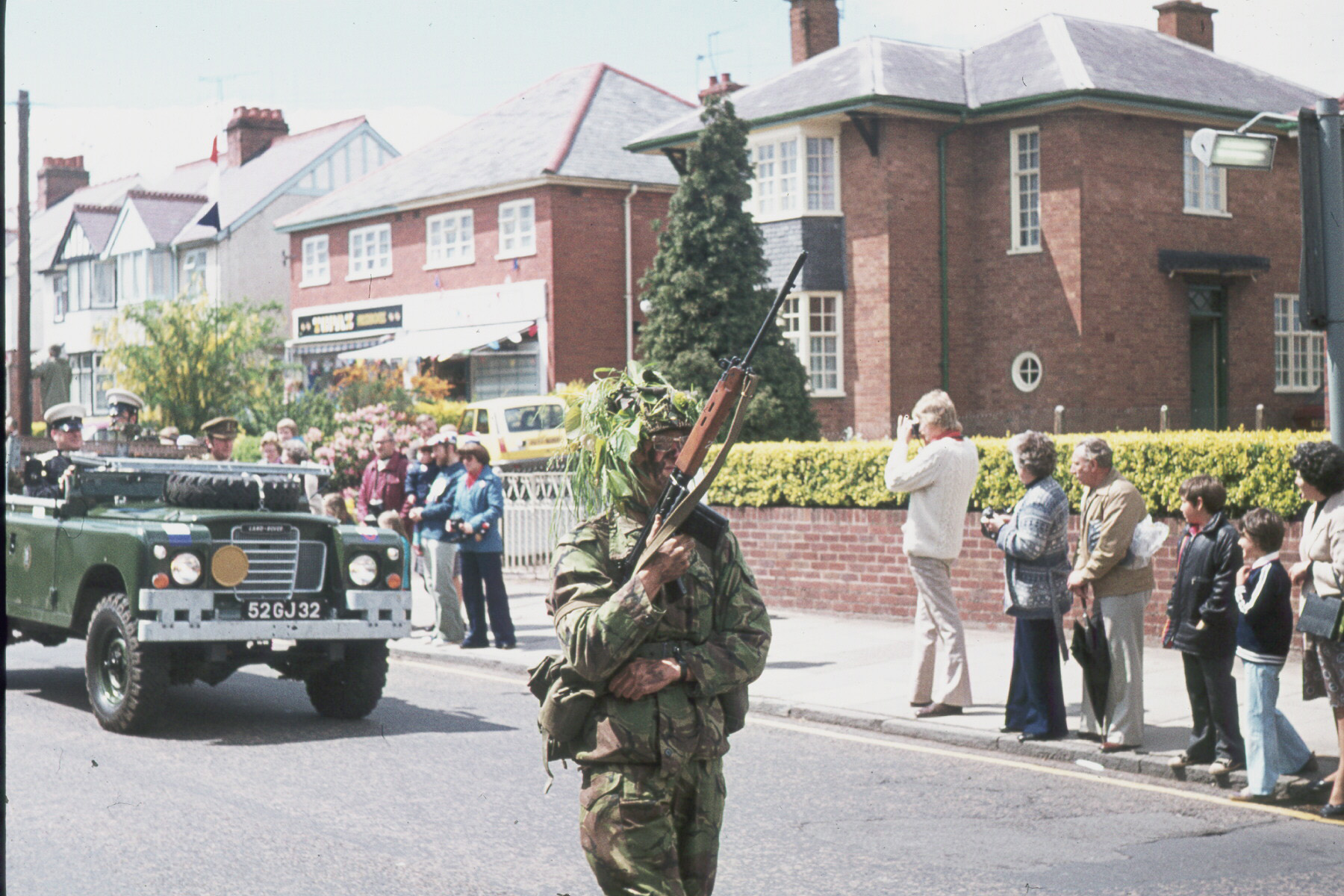
Queen’s Silver Jubilee Parade - Bridgnorth Road - June 1977
1970s
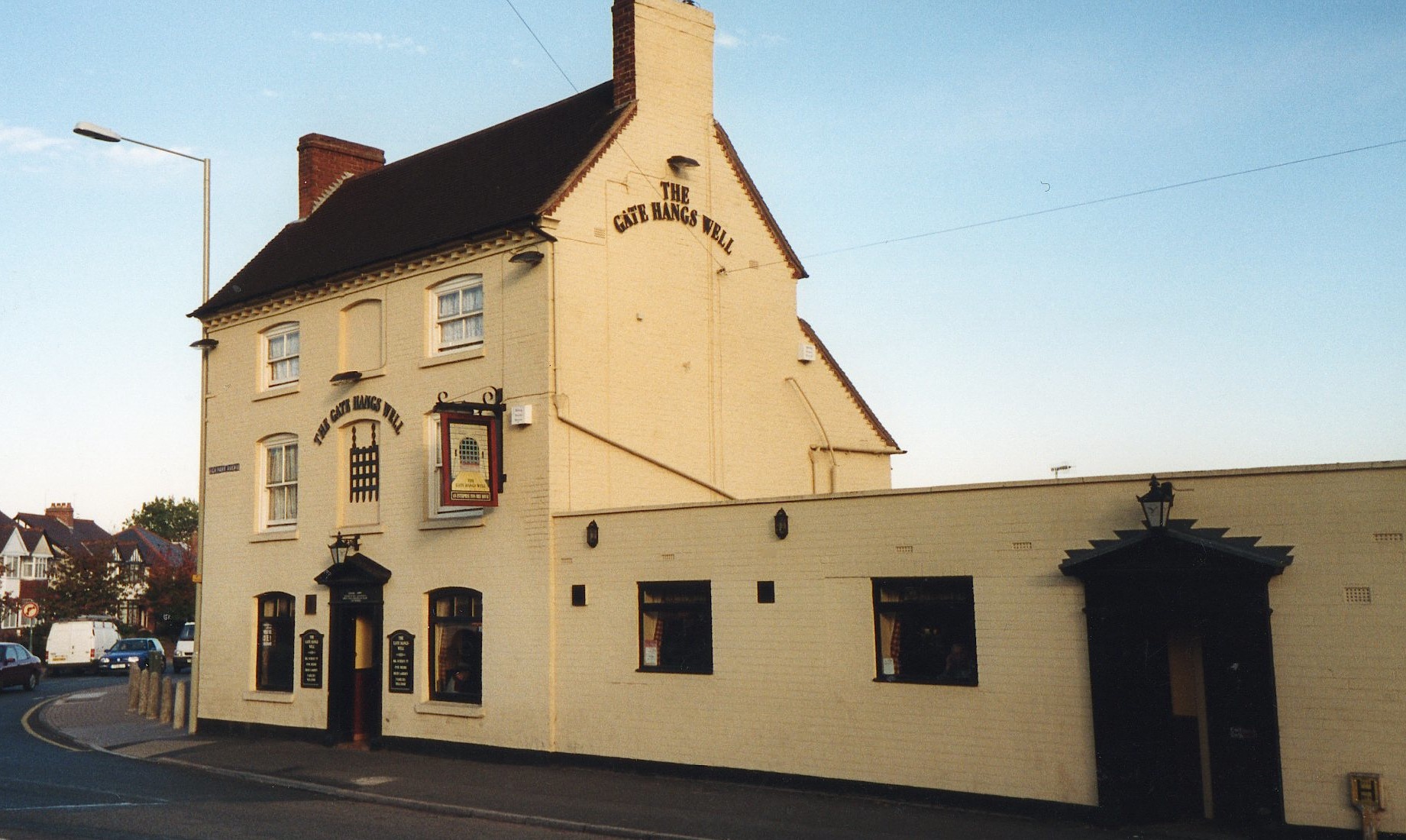
The Gate Hangs Well
2000s
A different view of The Gate Hangs Well was taken from the opposite side of High Park Avenue. The original public house had a large garden and bowling green where many games took place until the area became a car park. The licensee in 1940 was Charles Bartlett and the earliest recorded one was James Giles in 1827. The 1850s saw two licensees, William Cox and James Wood. In 1876 there was Henry Morris and 20 years later Henry Nickless, junior, was the publican.
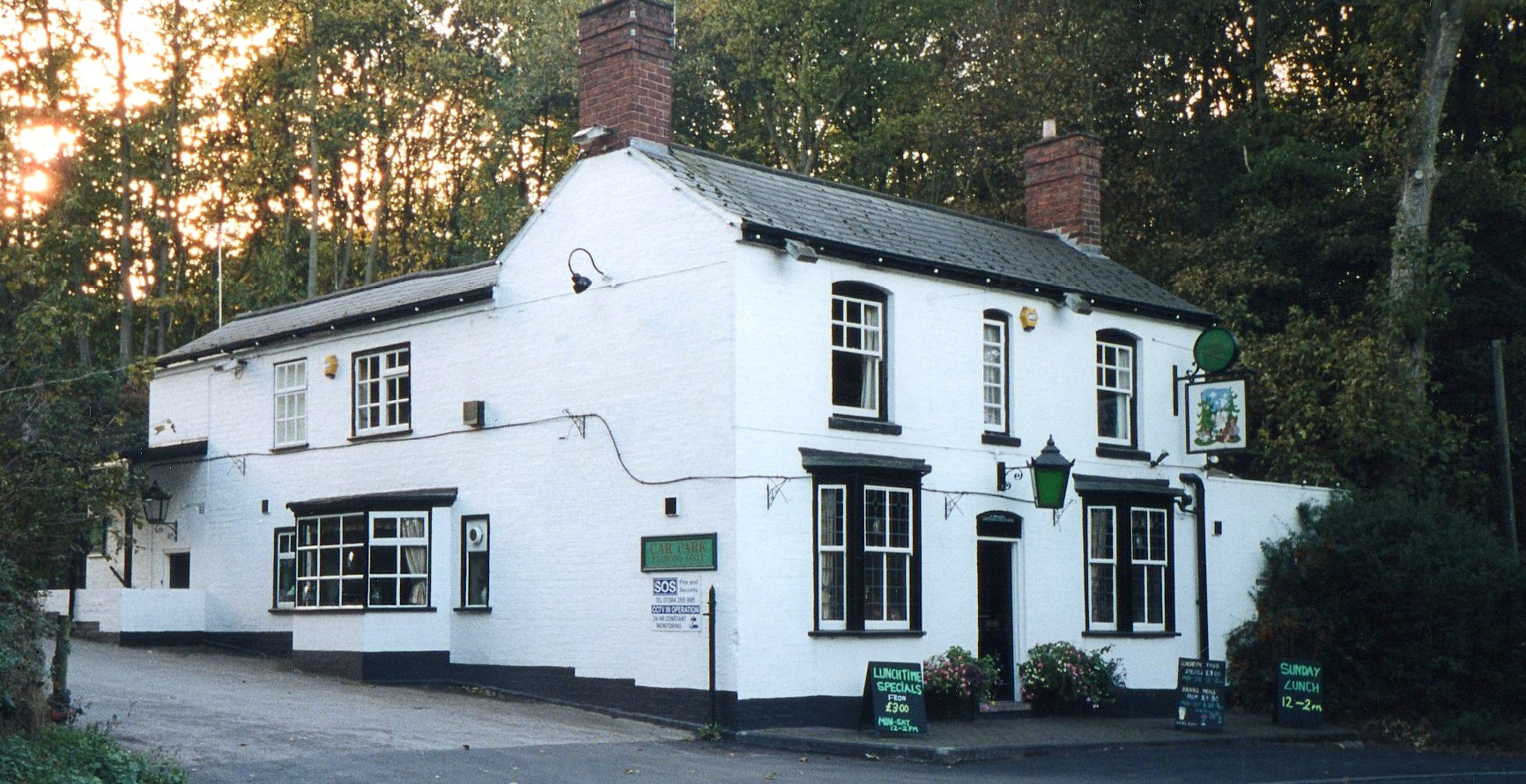
The Foresters Arms
2000s
The Foresters Arms is just inside Wollaston as the county boundary between Worcestershire and Staffordshire is at the Ridge. The address given for the pub is Bridgnorth Road although in the past it was also The Ridge. The original building was extended but the date of the alterations is not known. The pub had home brew until 1935.
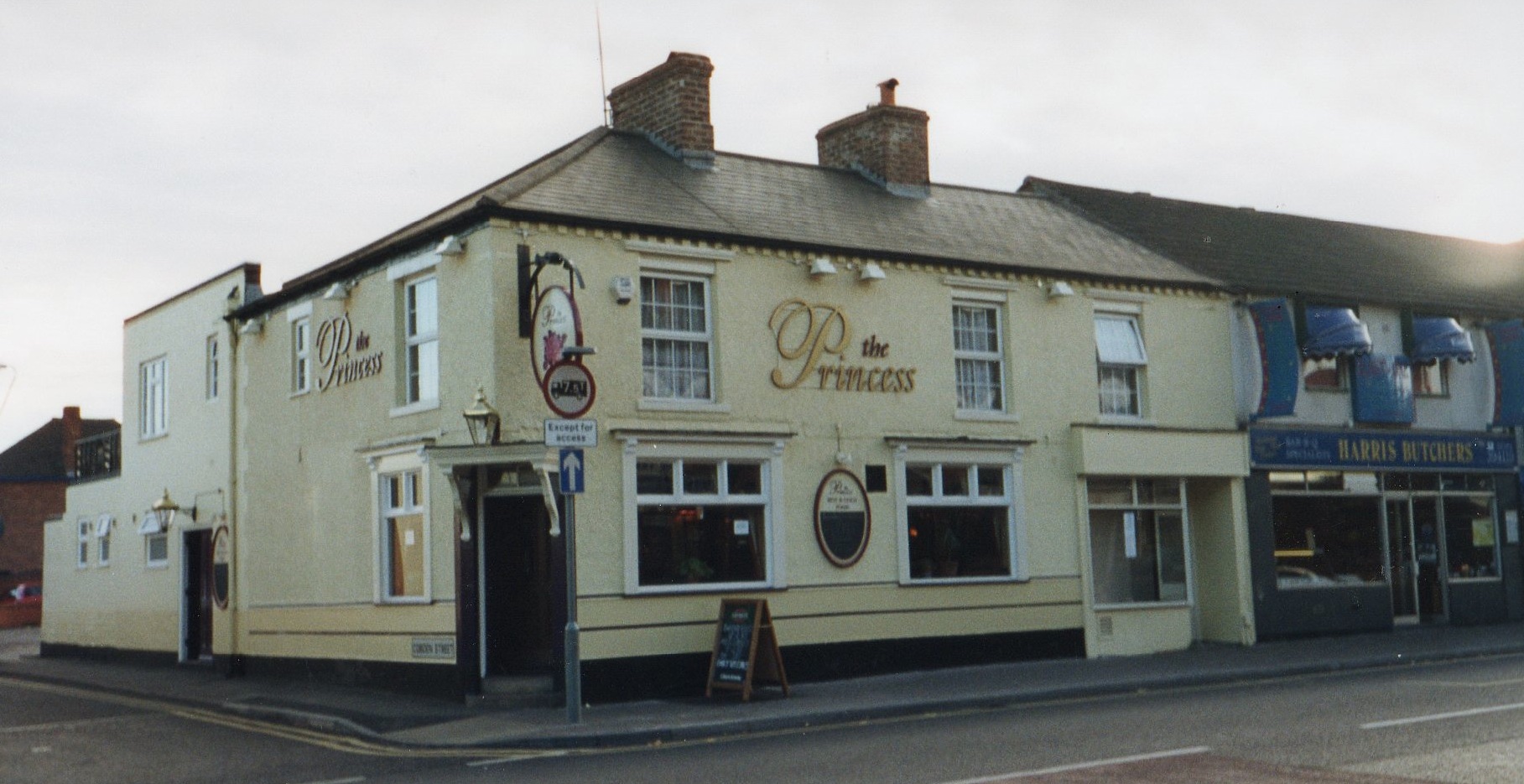
The Princess
2000s
The Alexandra public house was named in the 1861 census when the licensee was Samuel Rock. It is situated on the corner of Cobden Street and Bridgnorth Road and part of the garden at the rear became the public car park. One of the longest serving publicans in Wollaston was Daniel Bagnall who ran it for 32 years from 1930 until 1962 . Next door is the butcher’s shop which was run by William Harris who, at one time, was also the licensee and the shop still bears the family name. In October 1997 the name of the pub was changed to The Princess.
Comments
Add your comment